inbox and environment news: Issue 577
March 26 - April 1 2023: Issue 577
Varroa Mite Spread: Palm Beach - Whale Beach Now In Eradication Zone: Local Beekeeper's Hives Safe So Far
Palm Beach and Whale beach became part of the eradication zone for European honey bees on March 20 - the NSW DPI sent through a media release and has been out in our community inspecting local hives, all of which have been found free of the mite at present.
President of the Northern Beaches Beekeepers Giles Stoddard, spoke to Pittwater Online this week stating his own hives (Avalon Honey) had been inspected on Monday, March 20, and all were good. Mr. Stoddard is known in the community for his advocacy of keeping hives clean and the processes to do so.
He is pleased the DPI is still pursuing its eradication program for infected hives, although he understands how devastating it must be for those impacted to lose whole colonies they have worked for years to build.
''It's the feral European honeybees we have to watch out for, those that are not part of a hive but are in the landscape and can infect other hives. Unless we get a very strong wind blowing from the Central Coast and Umina, local hives should remain varroa free.''
A baiting program is being rolled out by DPI for those wild honeybees using an insecticide which does not attract non-target species, such as native bees.
On March 21, 2023 NSW Department of Primary Industries (DPI) stated surveillance and tracing activities has confirmed six new Varroa mite infestations in beehives at four locations across the Central Coast, Hunter and mid-north coast regions.
The new sites are at Mooney Mooney, Clarence Town, Mitchell’s Flat and Booral. The new detections bring the total infested premises to 137.
DPI Varroa Mite Response State Coordinator, Dr Chris Anderson, said the detections were a testament to the extensive tracing and surveillance work being undertaken, by beekeepers and DPI, to manage the outbreak.
“These new sites have low mite loads, which suggests they are very recent infestations,” he said.
“The recent detection on the Central Coast, however, has meant DPI is now concentrating its Varroa response surveillance activities into the northern suburbs of Sydney, to ensure the infestation is localised and that there is no mite population in the area.
“DPI has also had to extend the eradication (red) zone following the new detections on the mid-north coast.
“We know that this is a difficult time for impacted beekeepers, but controlling and eradicating this destructive mite is critically important to NSW and Australia.
“Changes in the number of infected premises are expected at this stage in the response, however what is encouraging is that these mites are being found quickly.
“We thank beekeepers and the community for their cooperation with the response.
For more information, visit the DPI website www.dpi.nsw.gov.au/varroa or call 1800 084 881
NB; Varroa mite emergency zones as of March 24, 2023; There are three Varroa mite zones.
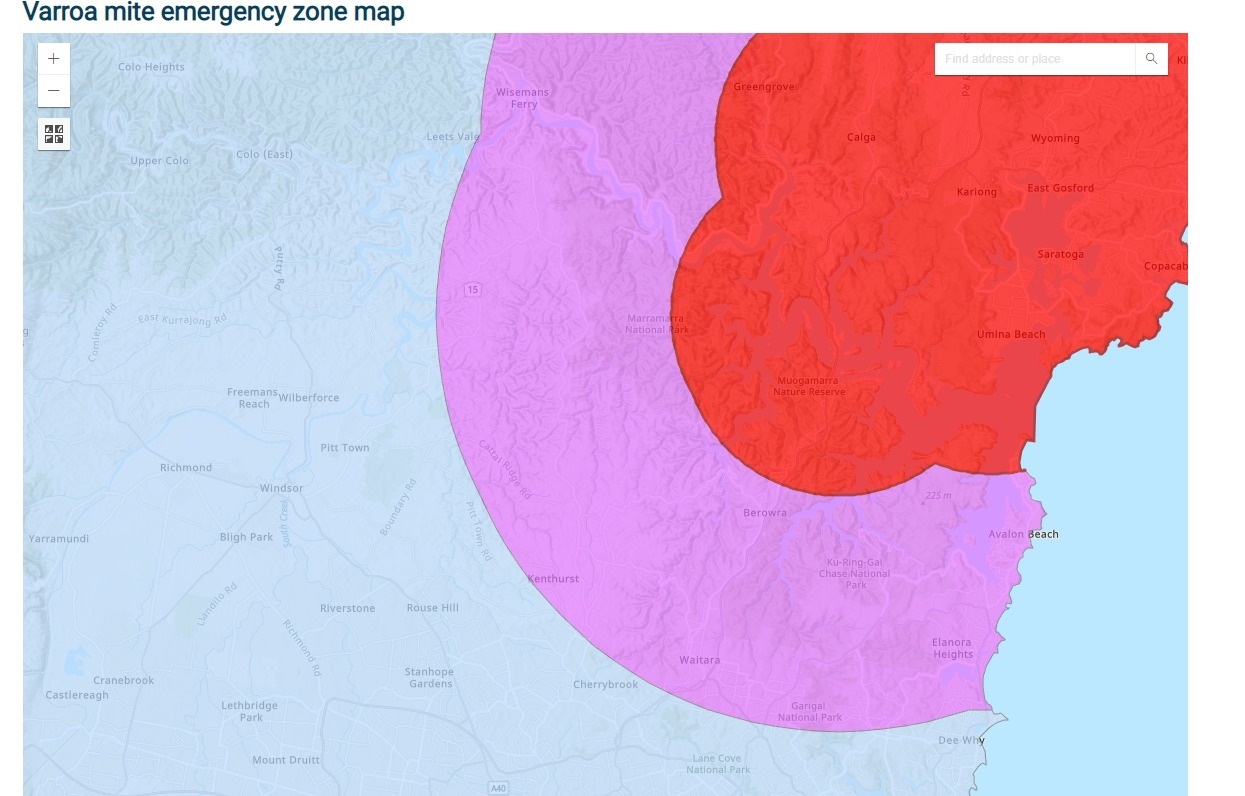

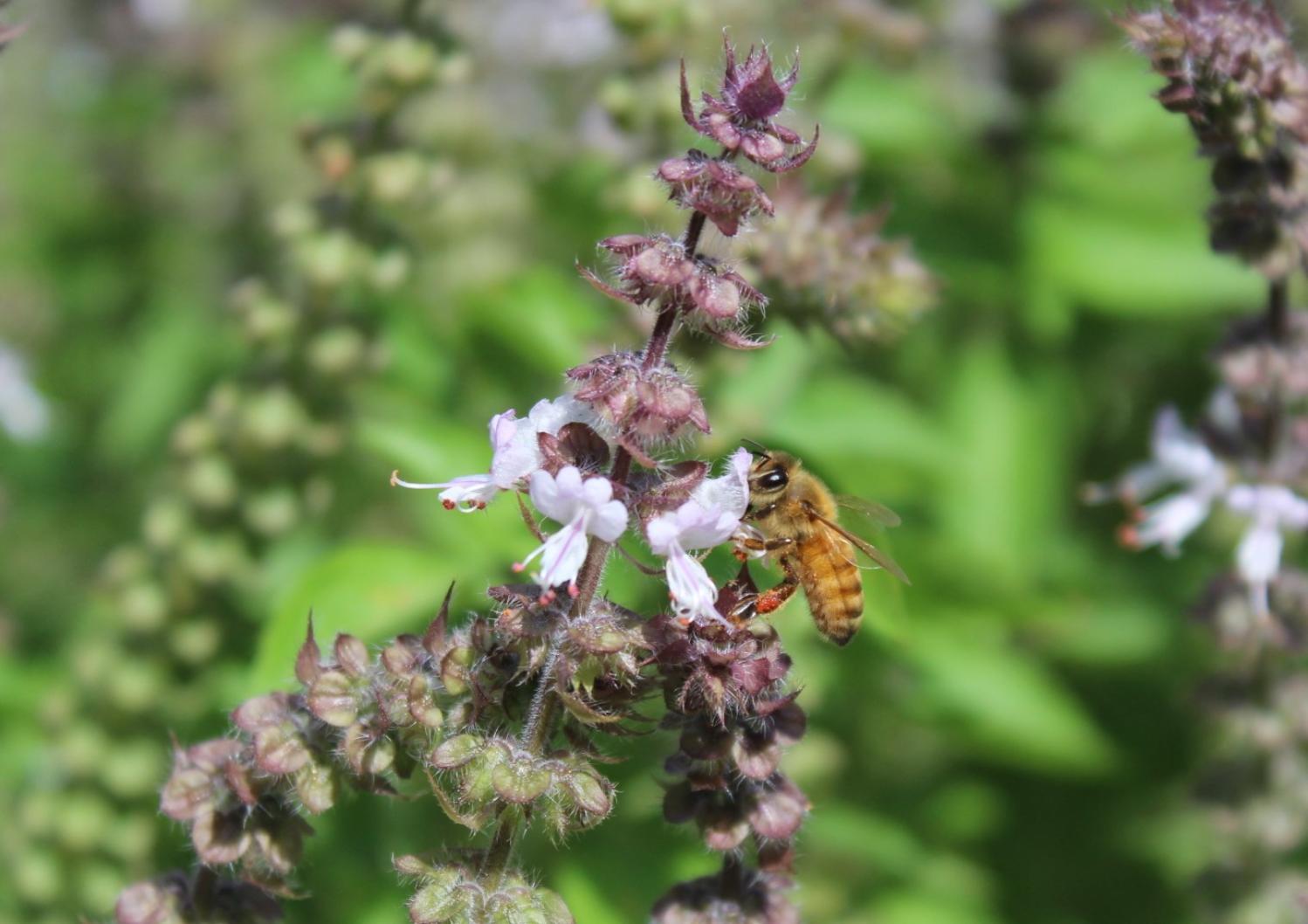
Photo European honeybee at Newport: AJG/PON
Australia’s 2023 Eucalypt Of The Year Is The Angophora Costata!
Announced by Eucalypt Australia on March 23 2023, and during its 10th year, this wonderful tree can be seen throughout our area and is so loved one of our early Reserves is named for one example, which sadly fell back to earth, after a long life, just last year in Angophora Reserve at Avalon Beach - there are some insights in the 2022 History page - which will rerun as the History feature this Issues as a special extra celebration.
It’s no wonder the tree is so well-loved, with those fantastically wiggly limbs that capture the imagination, and that smooth red bark that calls out to be touched!
Known as kajimbourra by the Dharawal people, the Sydney Red Gum is synonymous with the sandstone escarpments of the Greater Sydney region, where it grows in woodlands on shallow, sandy soils. Also known as the Smooth-barked Apple, the species is distributed from Bodalla on the NSW South Coast to Coffs Harbour (NSW North Coast), from the coast to adjacent inland ranges. Interestingly, there are disjunct populations on sandstone escarpments west of Townsville, suggesting a wider historic distribution.
Many Australians will be most familiar with the Sydney Red Gum as an important part of the urban forest in our cities and towns. With its broad trunk, attractive bark and spreading form, the species has been planted widely across suburban parklands and streetscapes and is beloved well beyond its natural range.
The Sydney Red Gum has this in common with this year’s runners-up, the Lemon-scented Gum (Corymbia citriodora) and Red Flowering Gum (Corymbia ficifolia). Each are so widely and commonly planted they have become part of the Australian psyche, at least in the south, where they evoke strong memories of childhood summers and days past.
But this year, it's our beloved angophora's turn to be lauded and applauded - if you want to see them persist, and have the room, plant a tree - some local instances:
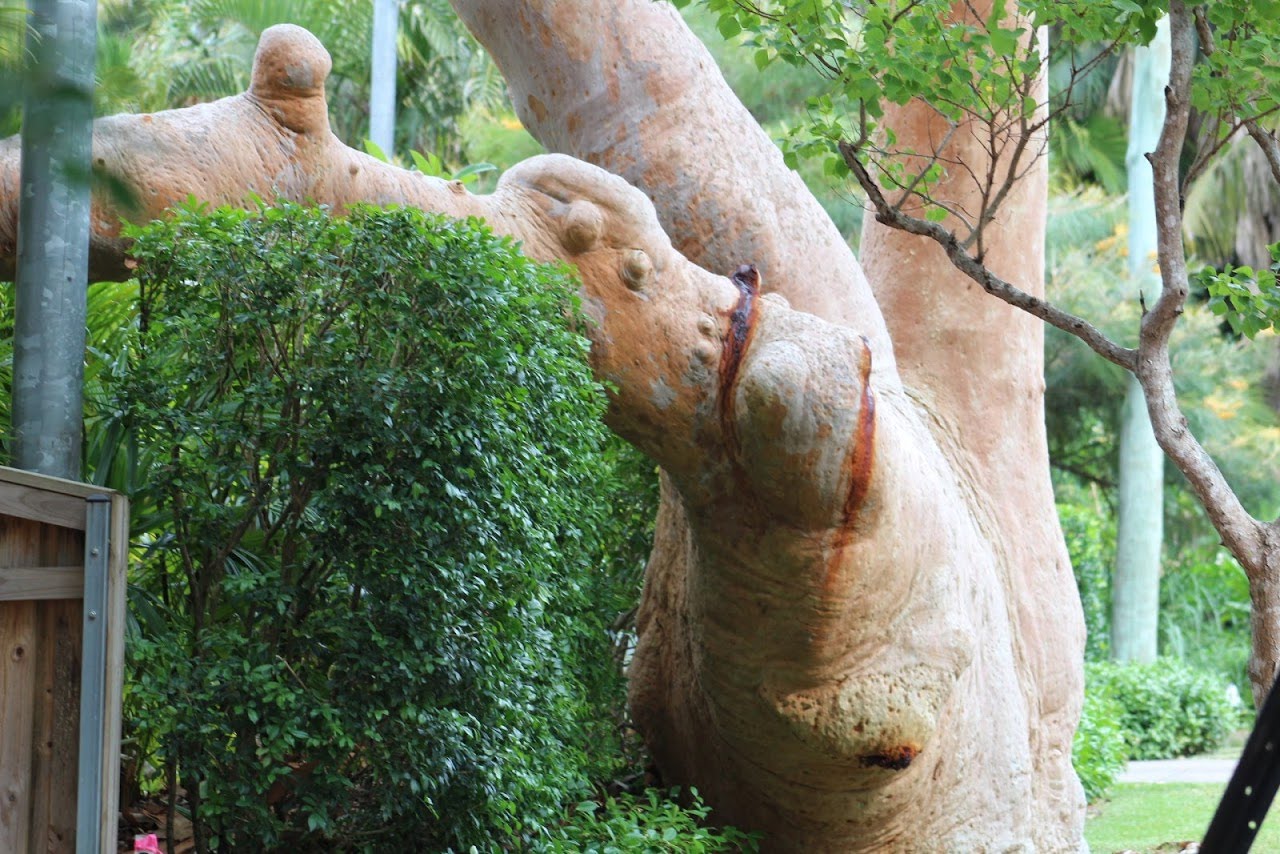
On a local street
.jpg?timestamp=1679635455680)
In McKay Reserve
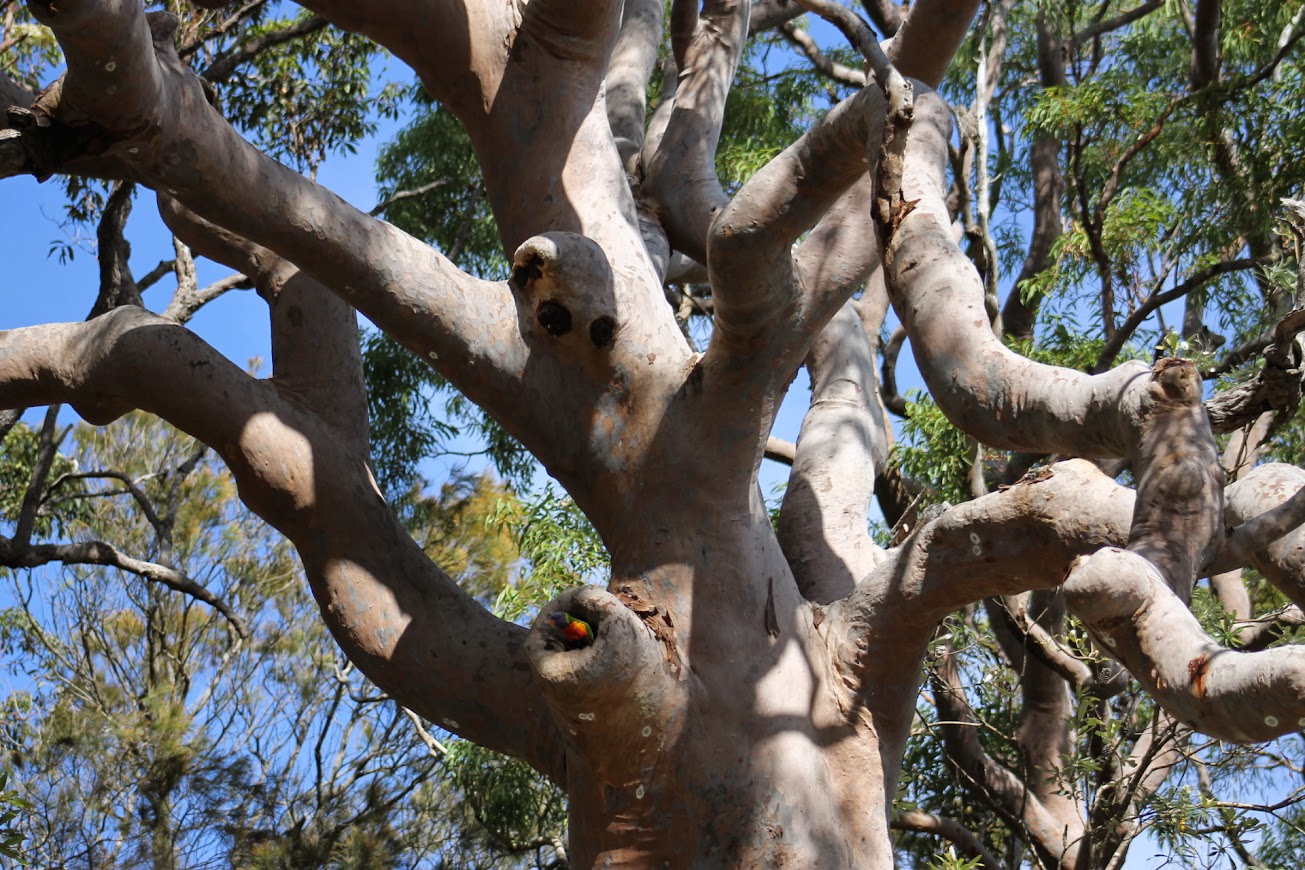
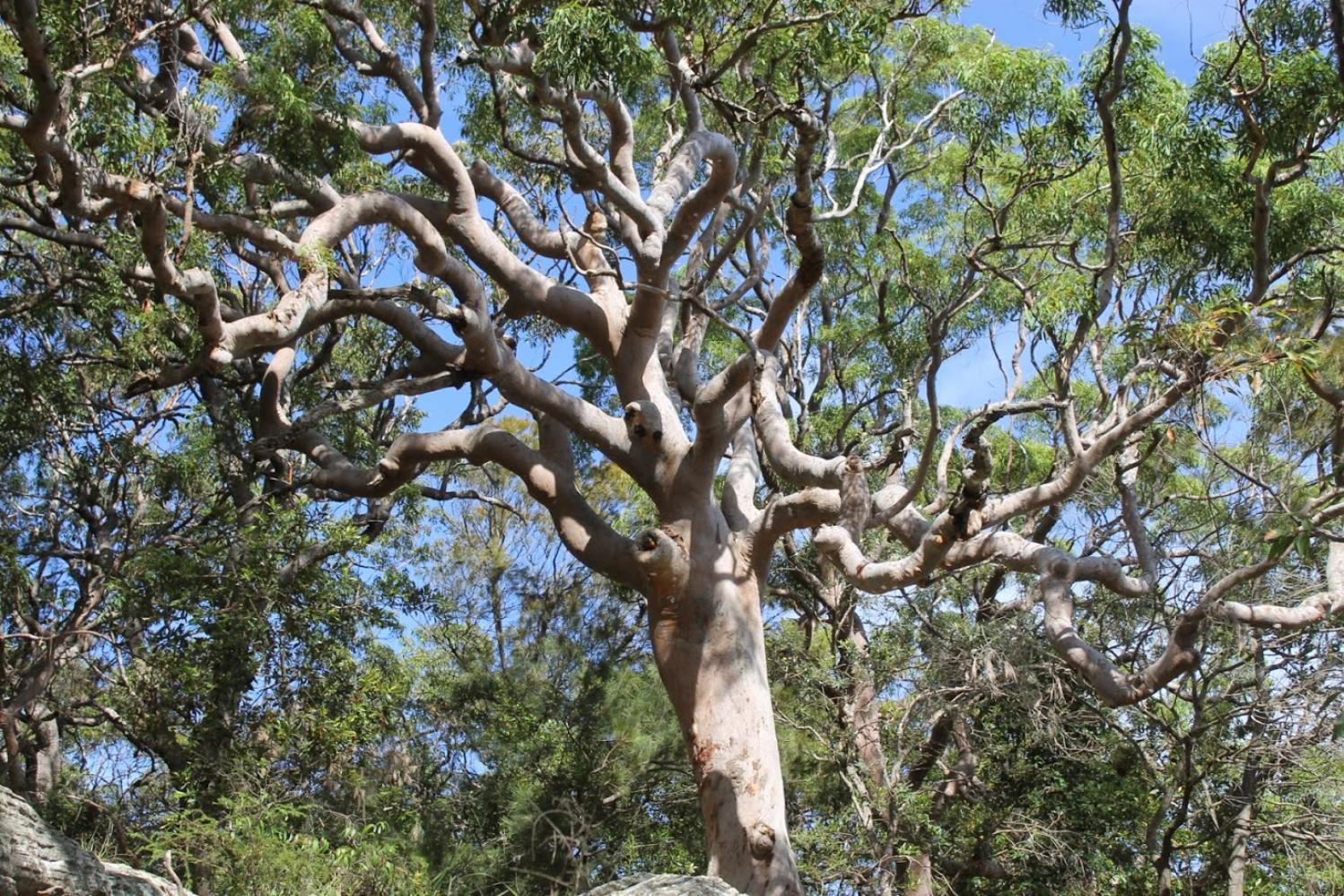
Kimbriki Resource Recovery Centre March 2023 Updates: Native Bees Are Back At Kimbriki + Clean Water Diversion System
Native Bees are Back
The team at the Eco House & Garden have recently been collaborating with the team in Ku-ring-gai Council's Strategy & Environment Department (Loving Living Ku-ring-gai). Various information and experiences have been shared on topics including education, composting set ups, waterwise gardens, visitor interactions and experiences, and native bees.
Sadly Kimbriki, like many others, lost our native bees during the extreme weather conditions experienced in 2022. We were delighted to receive a new native beehive yesterday, March 24, 203, for our Eco Garden, donated by Ku-ring-gai Council and kindly delivered and installed by their resident bee expert, Alex Austin. We look forward to having the "girls" in our garden and sharing the joys of our stingless native bees with our visitors again.
Find out more about the importance of native bees at: www.wheenbeefoundation.org.au/about-bees-pollination/australian-native-bees
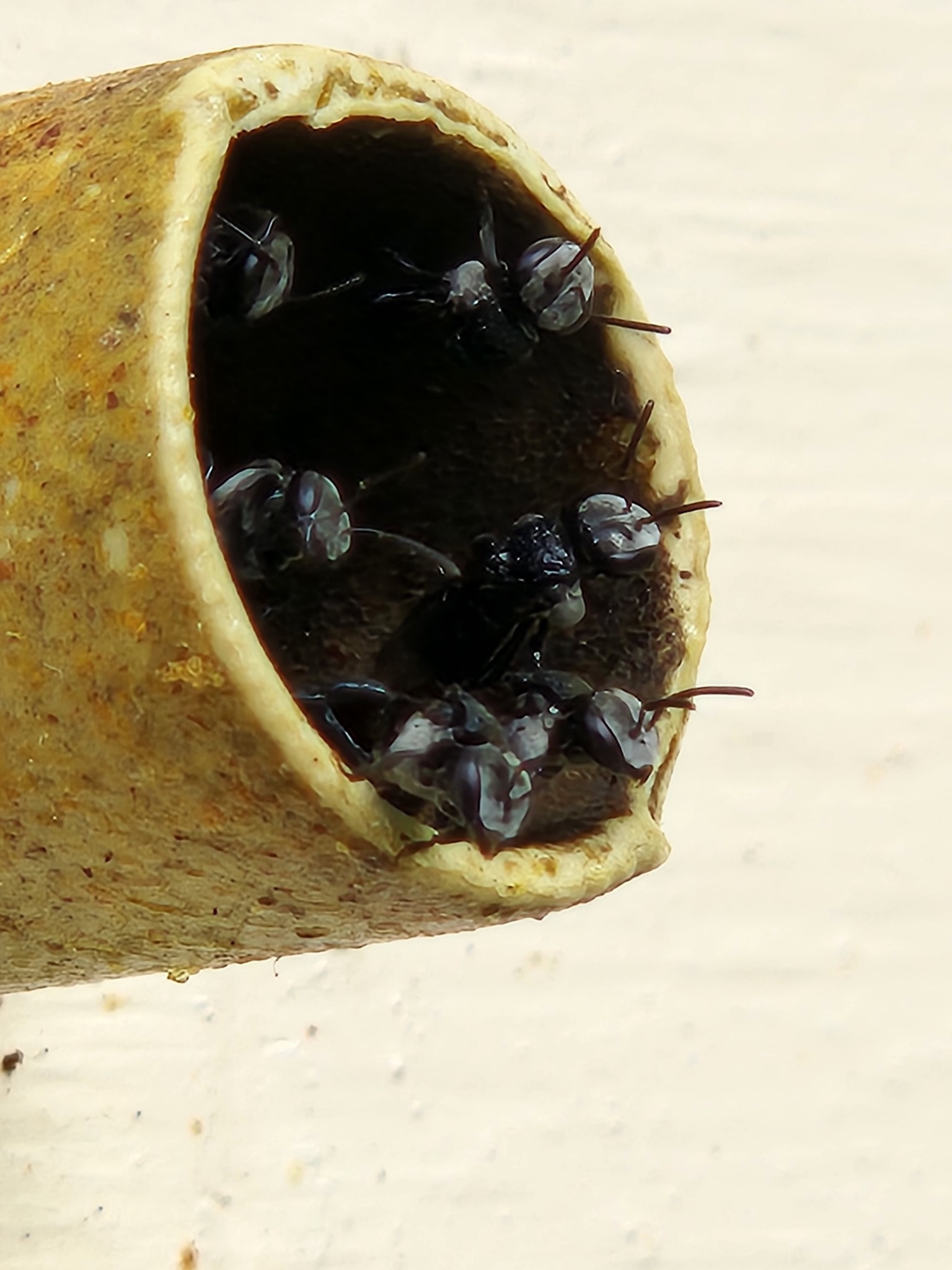
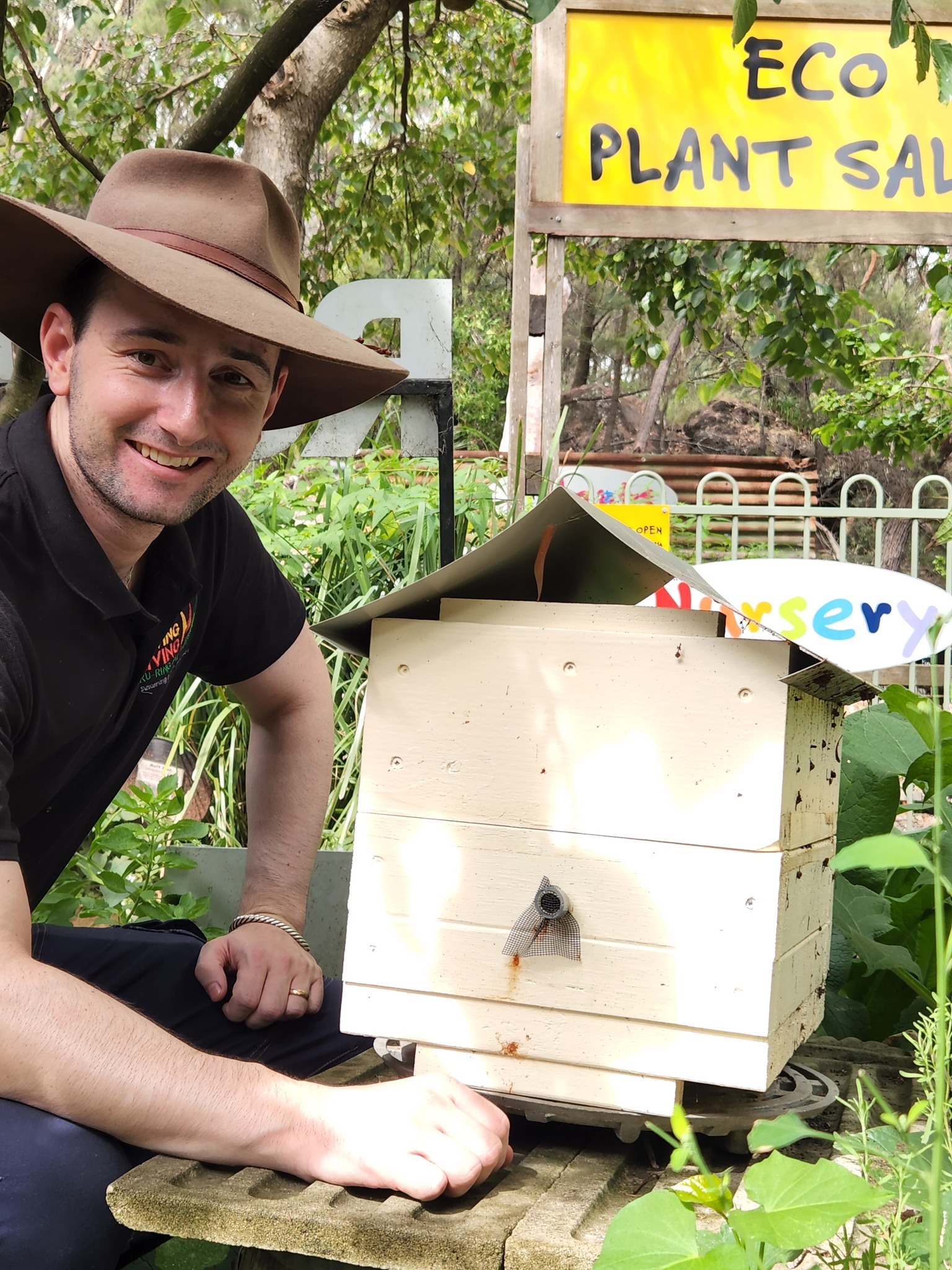
Photos: Kimbriki Resource Recovery Centre
Clean Water Diversion System
Have you visited Kimbriki recently and noticed the earthworks taking place?
We are busy implementing a Clean Water Diversion System, which will capture and divert water around the Kimbriki site.
Mark Wiser, Kimbriki's General Manager Operations provides a great overview of this important infrastructure project.
Swamp Wallaby At Palm Beach
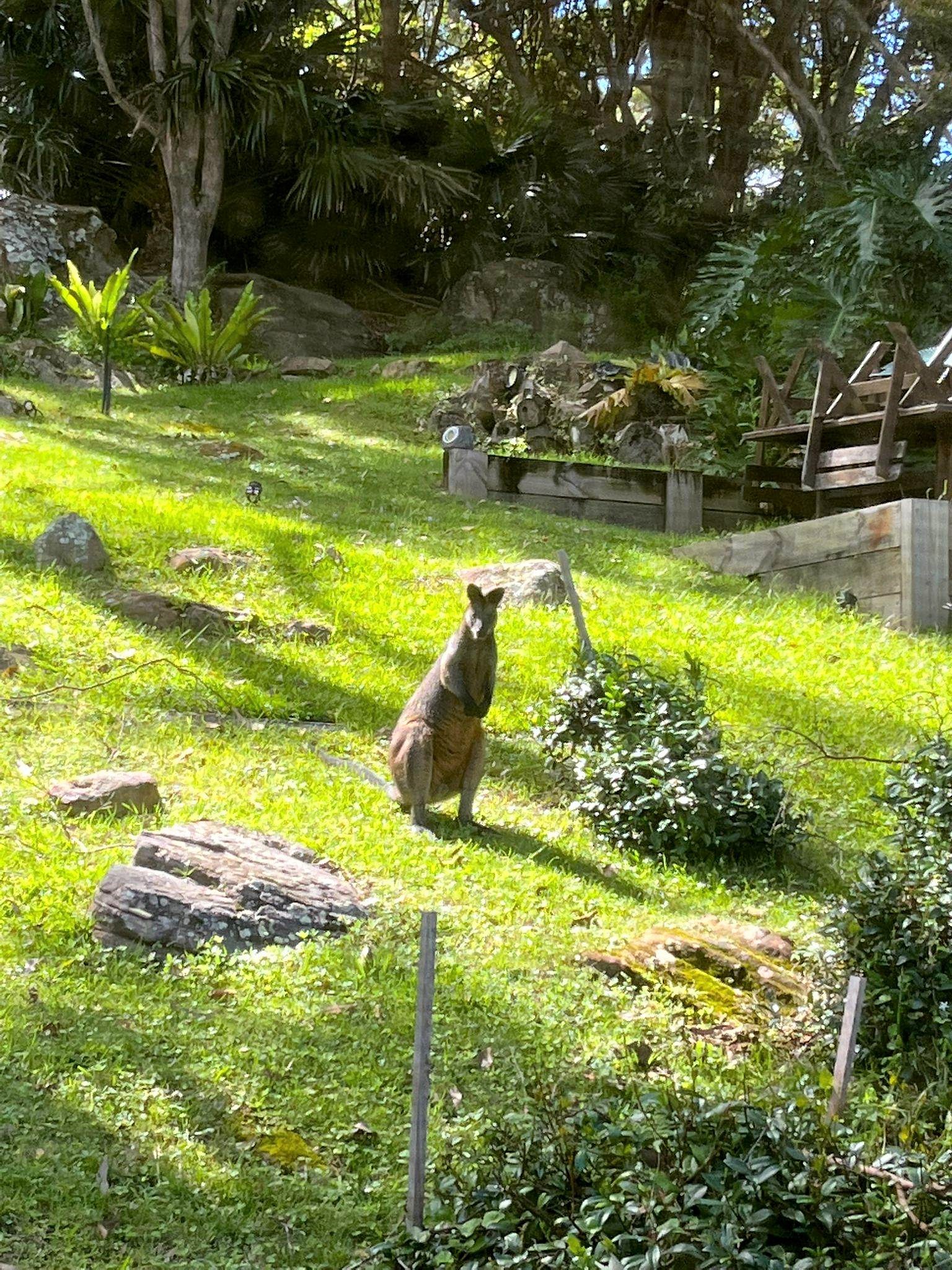
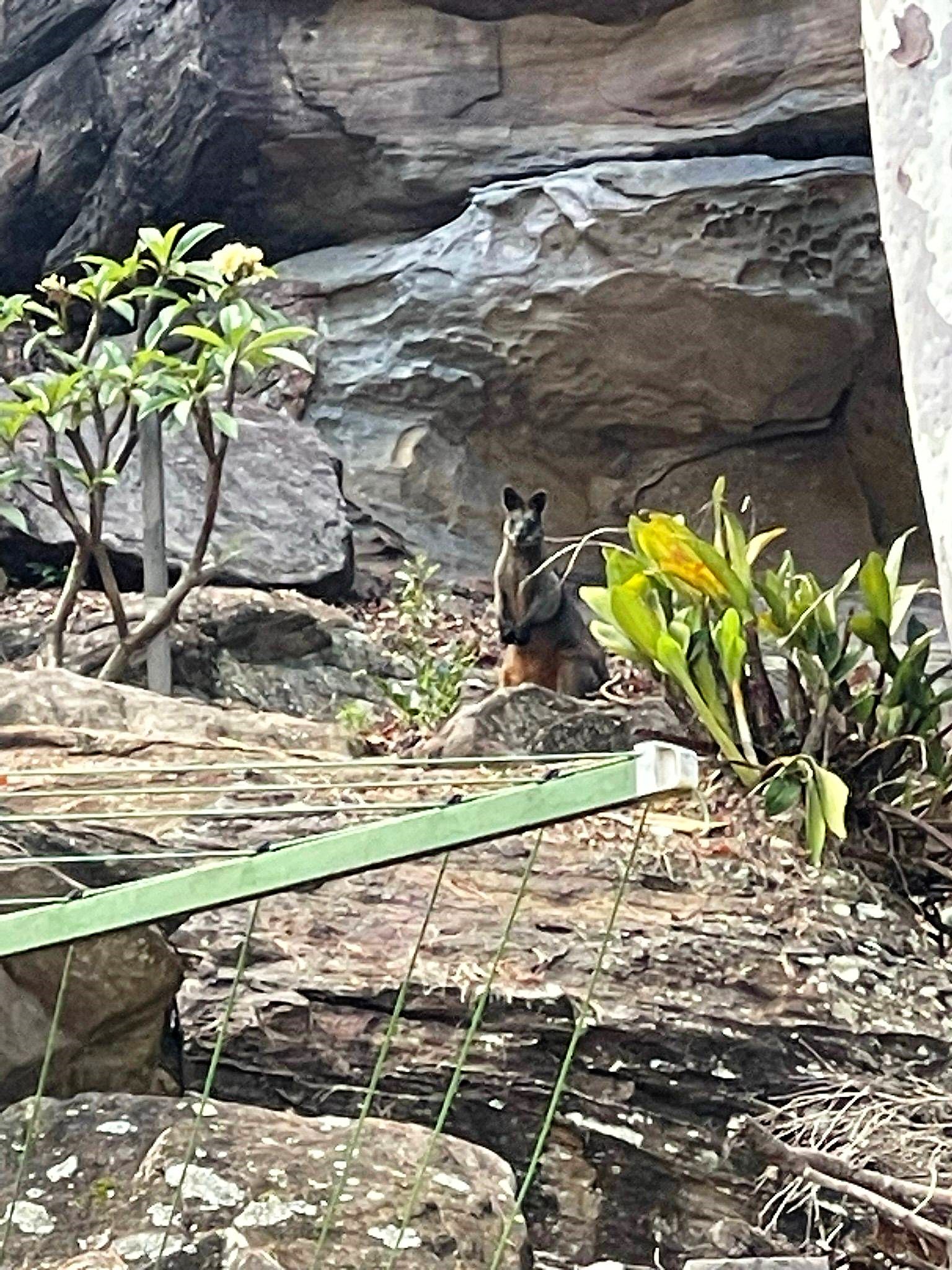
Westleigh Park - Critically Endangered Forest - POM Open For Feedback By Hornsby Council Until April 8
Purchased from Sydney Water in 2016, the 36-hectare Westleigh Park, Hornsby Council states, will play a key role in recreational provision for the district including a diverse range of provisions for formal sports, passive recreation (e.g. picnics, walking, playground), mountain biking and ancillary facilities (including internal roads, carparks, amenities buildings, shared paths and water management).
At its 8 March 2023 Council Meeting, Hornsby Council endorsed a revised draft Master Plan for Westleigh Park to be published for comment as part of the exhibition of the draft Plan of Management (read the Business Papers and Minutes).
The revised draft Master Plan seeks to provide a conceptual framework for ongoing planning on the site.
The draft Plan of Management establishes an appropriate character and scale for the development and management for Westleigh Park. It will enable the construction of new open space facilities at Westleigh Park to commence and will help identify a program of development and ongoing maintenance works.
Closes April 9, 2023
Visit: https://yoursay.hornsby.nsw.gov.au/westleigh-park-plan-management
Video published March 24, 2023 by Wild Bush Solutions
Calling All Citizen Scientists: Hunt For Shark Egg Cases Launches In Australia
March 20, 2023: CSIRO, Australia’s national science agency, is calling on citizen scientists to find and record egg cases washing up on Australian coasts, so researchers can better-understand oviparous chondrichthyans: egg-laying sharks, skates and chimaeras.
The Great Eggcase Hunt, an initiative of United Kingdom-based charity The Shark Trust, has launched in Australia in partnership with CSIRO to help provide new data for scientists studying the taxonomy and distribution of oviparous chondrichthyans.
Helen O’Neill, CSIRO Australian National Fish Collection biologist, said recording sightings of egg cases on beaches and coastlines would help scientists discover what the egg cases of different chondrichthyans look like, with some species still unknown.
“Egg cases are important for understanding the basic biology of oviparous chondrichthyans, as well as revealing valuable information such as where different species live and where their nurseries are located,” Ms O’Neill said.
Cat Gordon, Senior Conservation Officer at The Shark Trust, said the Great Eggcase Hunt began in the United Kingdom 20 years ago and has since recorded more than 380,000 individual egg cases from around the world.
“We’re really excited to be partnering with CSIRO to officially launch this citizen science project in Australia and to be able to expand the Shark Trust’s eggcase identification resources," Ms Gordon said.
"There’s such a diversity of species to be found around the Australian coastline, and with a tailored identification guide created for each state, they really showcase the different catsharks, skate, horn sharks, carpetsharks and chimaera eggcases that can be found washed ashore or seen while diving,” she said.
Also known as mermaids’ purses, egg cases come in many different shapes and colours, ranging from cream and butterscotch to deep amber and black. They range in size from approximately 4 to 25 centimetres.
Some egg cases have a smooth and simple appearance, while others have ridges, keels or curling tendrils that anchor them to kelp or coral. Port Jackson sharks have corkscrew-shaped egg cases that they wedge into rocks.
Each different species' egg case has a unique morphology that is helpful in taxonomy, the science of describing and naming species.
“At the Australian National Fish Collection, we are matching egg cases to the species that laid them,” Ms O’Neill said.
“We borrow egg cases from other collections, museums and aquariums around the world and use our own specimens collected from fish markets and surveys at sea or extracted from the ovaries of preserved specimens in our collection,” she said.
Chondrichthyans have the most diverse reproduction strategies found among vertebrates, encompassing parthenogenesis (no father), multiple paternity (more than one father of the litter), adelphophagy (baby sharks predating each other in the womb) and various modes of egg laying.
Egg cases found on beaches rarely contain live embryos, whose incubation times range from a few months up to three years, depending on the species.
“Egg cases found washed up on beaches have likely already hatched, died prematurely due to being washed ashore or been predated on by creatures like sea snails, who bore a hole in the egg case and suck out the contents,” Ms O’Neill said.
The Shark Trust is a United-Kingdom-based charity dedicated to safeguarding the future of sharks, skates, rays, and chimaera through positive change. The Trust achieves this through science, education, influence and action.
To get involved in the Great Eggcase Hunt, you can record sightings via the Shark Trust citizen science mobile phone app or through the project website: www.sharktrust.org/greateggcasehunt
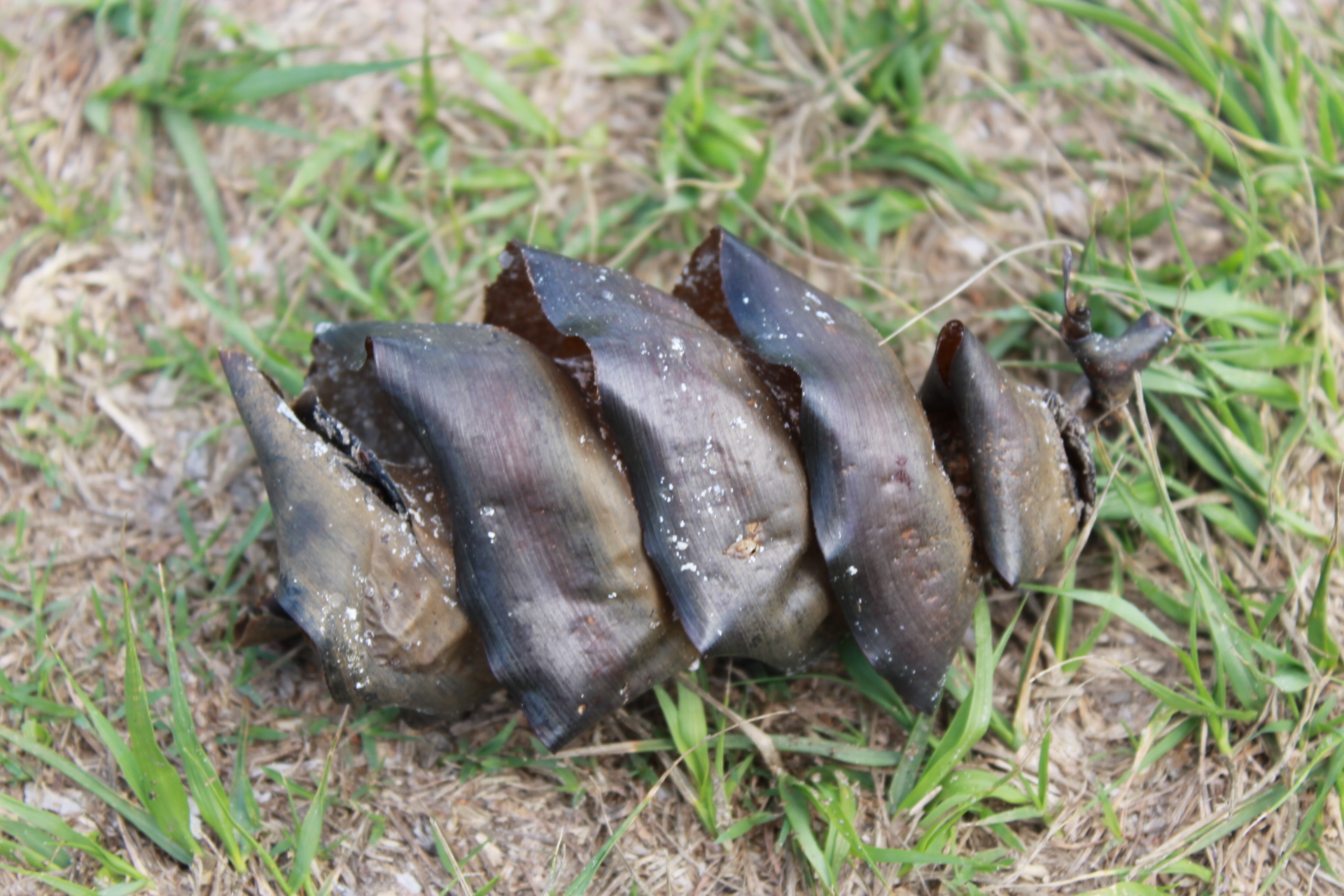
Photo: Port Jackson shark egg on Station Beach at Pittwater. Image PON/AJG
The Port Jackson shark (Heterodontus portusjacksoni) is a nocturnal, oviparous (egg laying) type of bullhead shark of the family Heterodontidae, found in the coastal region of southern Australia, including the waters off Port Jackson. It has a large, blunt head with prominent forehead ridges and dark brown harness-like markings on a lighter grey-brown body, and can grow up to 1.65 metres (5.5 ft) long. They are the largest in the genus Heterodontus.
The Port Jackson shark is a migratory species, traveling south in the summer and returning north to breed in the winter. It feeds on hard-shelled mollusks, crustaceans, sea urchins, and fish. Identification of this species is very easy due to the pattern of harness-like markings that cross the eyes, run along the back to the first dorsal fin, then cross the side of the body, in addition to the spine in front of both dorsal fins.
These sharks are are oviparous, meaning that they lay eggs rather than give live birth to their young. The species has an annual breeding cycle which begins in late August and continues until the middle of November. During this time, the female lays pairs of eggs every 8-17 days. As many as eight pairs can be laid during this period. The eggs mature for 10–11 months before the hatchlings, known as neonates, can break out of the egg capsule.
Port Jackson shark adults are often seen resting in caves in groups, and prefer to associate with specific sharks based on sex and size. Juvenile Port Jackson sharks, on the other hand, do not appear to be social. A captive study showed that these juveniles did not prefer to spend time next to other sharks, even when they were familiar with each other (i.e. tank mates). Juvenile Port Jackson sharks have unique personality traits, just like humans. Some were bolder than others when exploring a novel environment and they also reacted differently to a stressful situation (in choosing a freeze or flight response).
Juvenile Port Jackson sharks are also capable of learning to associate bubbles, LED lights, or sounds with receiving a food reward, can distinguish different quantities (i.e. count), and can learn by watching what other sharks are doing.
At least in some of these lab experiments males are shyer than females and boldness increases with consecutive trials of the same experiment. In experiments with different music genres, none of the sharks tested learned to discriminate between a jazz and a classical music stimulus.
Port Jackson Sharks are considered harmless to humans, although the teeth, whilst not large or sharp, can give a painful bite.
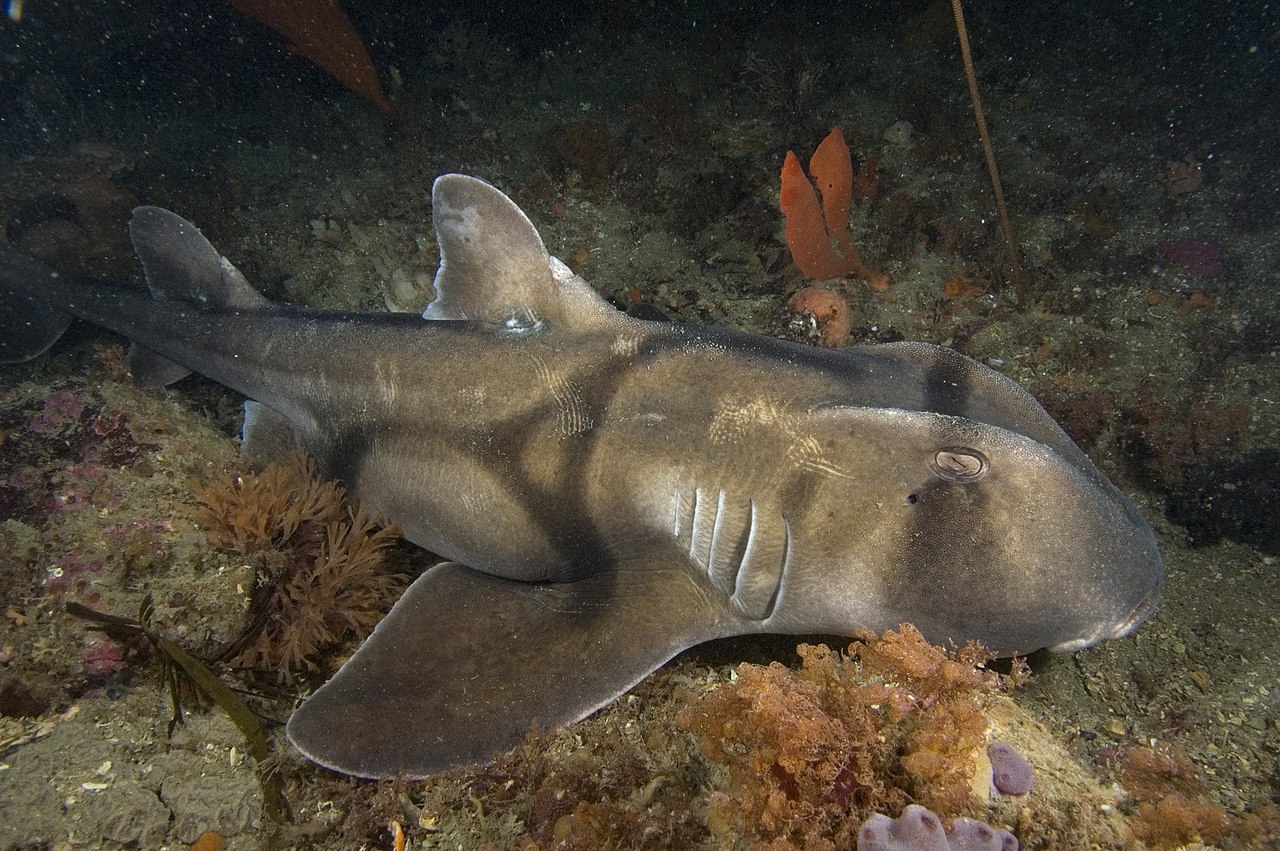
Heterodontus portusjacksoni. Photo: Mark Norman, Museums Victoria
Cat Owners Encouraged To Keep Their Pets Safe At Home
Wednesday, 1 March 2023
Northern Beaches residents are being encouraged to keep their pets safe at home as part of a new animal protection campaign.
According to RSPCA NSW, two out of three cat owners have lost a cat to a roaming-related accident, and one in three to a car accident. Northern Beaches Council is proud to be one of 11 councils partnering with RSPCA NSW as part of the Keeping Cats Safe at Home project.
Promoting responsible ownership, the new campaign goes beyond desexing and micro chipping of beloved cats and asks owners to consider keeping their cats at home.
Northern Beaches CEO Ray Brownlee said there’s a dual benefit to cats and local wildlife that flows directly from promoting responsible ownership of domesticated cats.
“Northern Beaches residents love their pets, but they’re also passionate about protecting the local environment,” Mr Brownlee said.
“Because pet cats occupy a special place in our hearts we need to educate the community on how have them microchip and desexed to keep them safe. This initiative has an educational focus. It aims to protect tiny native species like lizards, mammals, baby birds and frogs, while also preventing domesticated cats from falling prey to road accidents.”
In 2021, the NSW Government awarded a $2.5 million grant from the NSW Environmental Trust to RSPCA NSW to deliver the project.
To help promote the campaign, Council is asking cat-lovers living on the Northern Beaches to submit a photo of their cat or kitten living their best life at home and go in the draw to win one of 10 $1000 vouchers for a deluxe outdoor cat enclosure from Catnets. The competition opens on March 1st and closes on Sunday April 9th 2023. Finalists will be published in an online gallery.
For competition details visit www.northernbeaches.nsw.gov.au/environment/non-native-animals/cats/competition-keeping-cats-safe-home
Learn more about keeping cats safe at www.rspcansw.org.au/keeping-cats-safe
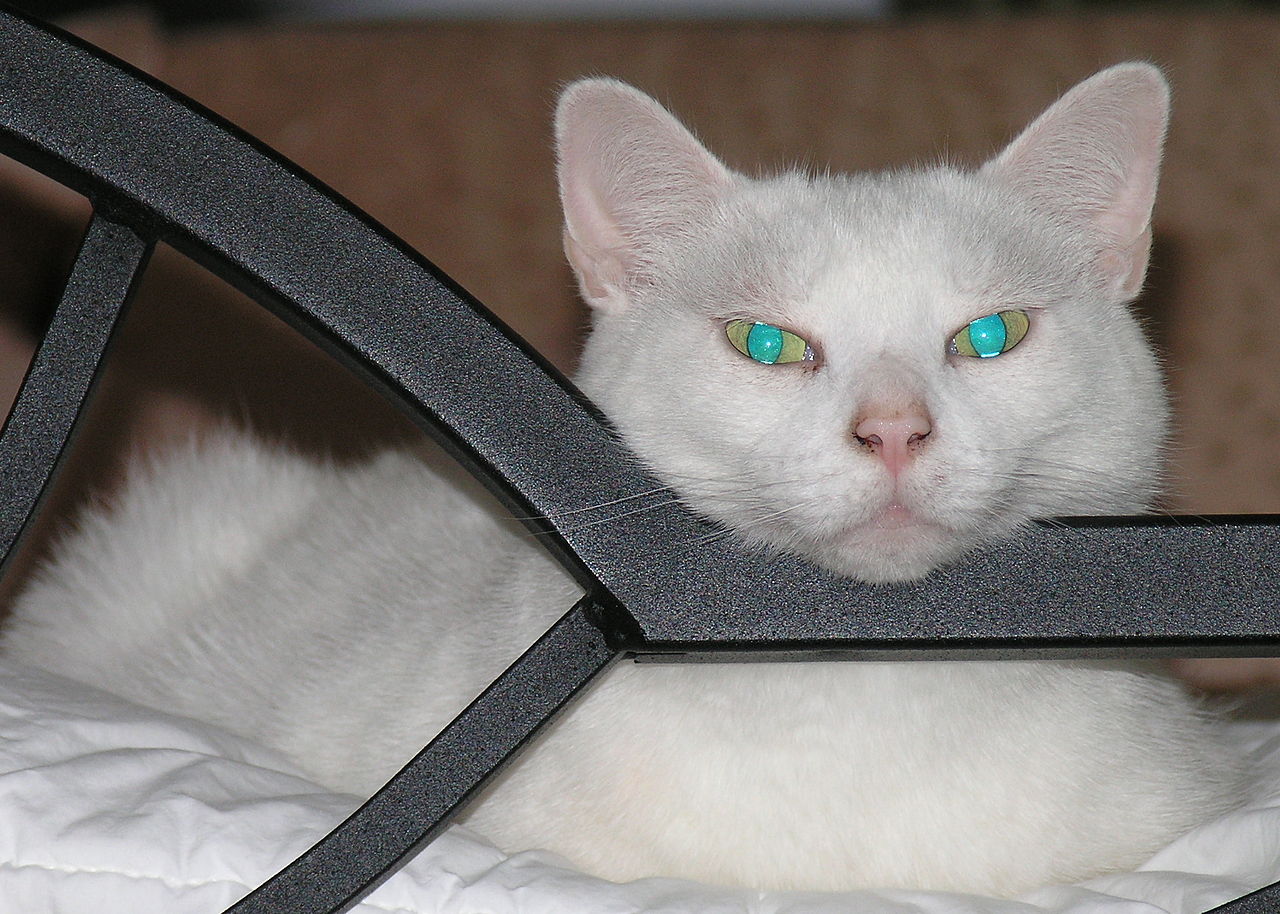
Photo: Greg Hume
Black Summer Vigil For Wildlife: April 2nd
The New South Wales Wildlife Council invites all wildlife carers, wildlife vets, vet nurses, first responders and supporters to the upcoming Black Summer Vigil for Wildlife on Sunday April 2nd 2023 starting at 2pm.
Please join us for the Black Summer Vigil, a three-year anniversary memorial service for the three billion animals who lost their lives in the fires – “one of the worst wildlife disasters in modern history”.
Attend online or in-person at Camperdown Memorial Rest Park (Sydney).
RSVP at: blacksummervigil.com
You’ll hear personal stories from the NSW Wildlife Council, Southern Cross Wildlife Care and other first responders across wildlife rescue, rural fire service, photojournalism, Aboriginal custodianship, veterinary medicine, ecology and more.
+ Performance and Ceremony by Jannawi Dance Clan, sharing a Dharug cultural perspective to honour the Ancestors and bring the spirit of the animals into our midst.
Join us to honour the animals who perished – and in doing so, celebrate the unique and extraordinary wildlife of these lands.
Speakers include:
Greg Mullins, Former Commissioner, Fire and Rescue NSW; Climate Councillor and founder, Emergency Leaders for Climate Action. Greg warned Australia's then–Prime Minister in April 2019 that a bushfire catastrophe was coming. He pleaded for support and was ignored, then risked his life dealing with the ramifications on the ground. “You couldn’t see very far because of the orange smoke. Everything was dark. It was probably 2 o’clock in the afternoon but it was like night. Then I saw something moving on the side of the road and I walked closer. It was a mob of kangaroos. The speed of that fire with its pyroconvective storm driving it in every direction, they had nowhere to go. They came out of the forest, on fire, and dropped dead on the road. I’ve never seen that. Kangaroos know what to do in a fire. They’re fast animals. Climate change, driven by the burning of coal, oil, and gas is driving worsening bushfires across Australia, and putting our precious, irreplaceable wildlife in danger.”
Internationally recognised ecologist and WWF board member, Professor Christopher Dickman oversaw the work calculating the animal deaths from Black Summer. A Fellow of the Australian Academy of Science, Professor Dickman already wore the heavy task of being an ecologist during the sixth mass extinction, in the country that has the worst rate of mammalian extinction in the world. On 8 January 2020 media around the world shared his finding that Black Summer fires had killed one billion animals. Sadly, the fires continued for two more months, and his team's final count was three billion. This does not include invertebrates: it is estimated 240 trillion beetles, moths, spiders, yabbies and other invertebrates died in the fires.
Coming up from the South Coast, owner of Wild2Free Kangaroo Sanctuary Rae Harvey, as seen in The Bond and The Fire. She is in the sad position of having personally known and cared for a number of Black Summer's victims: many of the orphaned joeys she cared for were killed in the fires. (She nearly died herself too.) For three years, she has been unable to even speak their names. Now, for the first time, she will tell the story of the joeys she lost.
Cultural burning practitioner and Southern NSW Regional Coordinator with Firesticks Alliance, Djiringanj-Yuin Custodian Dan Morgan. Dan practises using Aboriginal knowledge to heal Country. He has worked for 18 years with the NSW National Parks & Wildlife Service and is on the board of management for the Biamanga National Park, a sacred area home to the last surviving koalas on the NSW south coast – which was partly destroyed by the fires of Black Summer. “The animals that live on our sacred sites are our Ancestors, it's our Cultural obligation to protect them. We have evolved with our Country over thousands of years, nourishing and protecting all living species. Our Country represents our people. So when the fires came, it was devastating to see the aftermath, and the feeling of helplessness was truly traumatising for our people, due to the denial of our Cultural right to manage Country as our Ancestors did for thousands of years prior to colonisation. Australia needs to make legislative changes that allow us to heal Country and our community through the fire knowledge and to stop incinerating ecosystems with destructive 'hazard-reduction' burns."
Head of Programs & Disaster Response at Humane Society International (HSI), Evan Quartermain was one of the first responders on Kangaroo Island where nearly 40% of the island burnt at high severity: “Those were some of the toughest scenes I’d ever witnessed as an animal rescuer: the bodies of charred animals as far as the eye can see. Every time we found an animal alive it felt like a miracle.” As a result of this firsthand experience, HSI commissioned a report into the state of Australia's disaster response for wildlife, which we'll also hear about.
+ More to come.
The Black Summer Vigil is brought to you by the Department of Animals, Animals Australia, the NSW Wildlife Council, World Animal Protection, Humane Society International and Defend the Wild, with support from WIRES, Firesticks Alliance, Nature Conservation Council of NSW, Wild2Free Kangaroo Rescue, Four Paws, Friends of the Koala and Kangaroos Alive.

Permaculture Northern Beaches - Upcoming Events

- Learn about Permaculture design
- Caring for and raising chickens
- Native bees and bee hotels
- Living Skills - soap making
- AND Live Music!
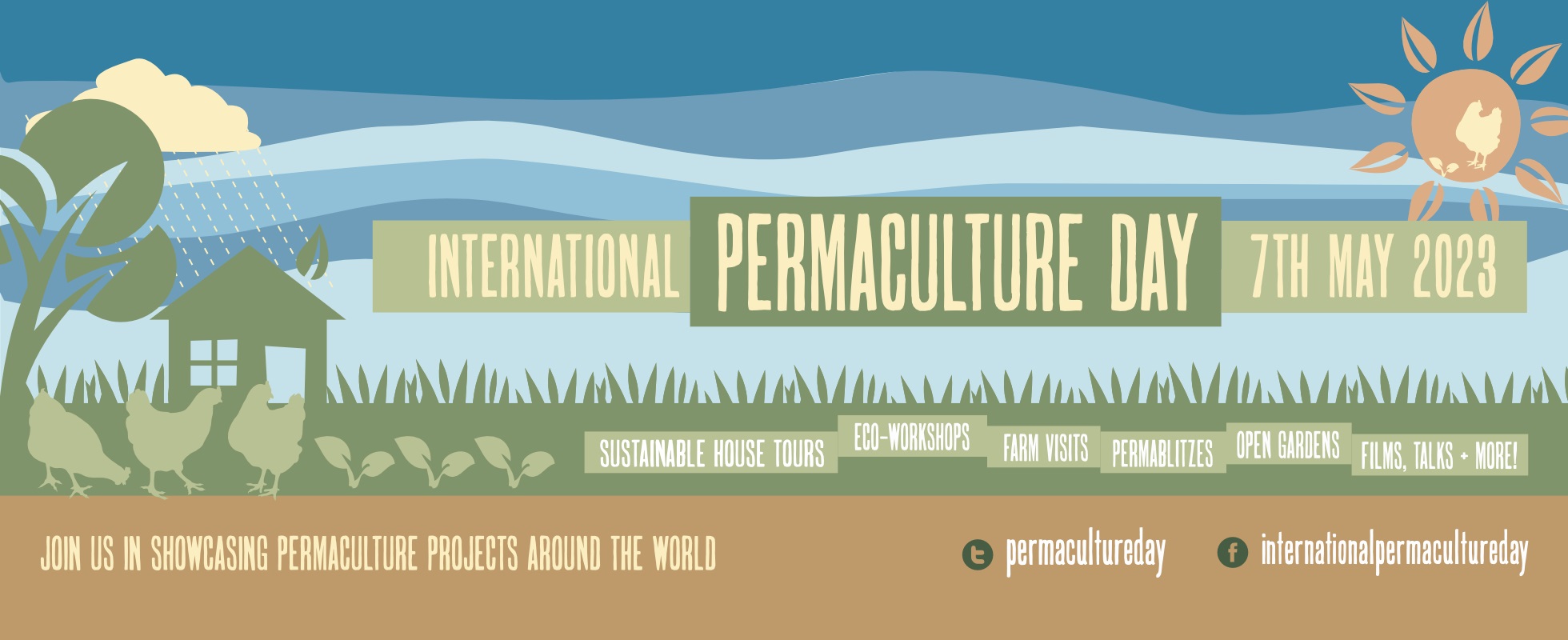
Report Fox Sightings
%20(1).jpg?timestamp=1675893929686)
Weed Of The Week: Cassia - Please Pull Out And Save Our Bush
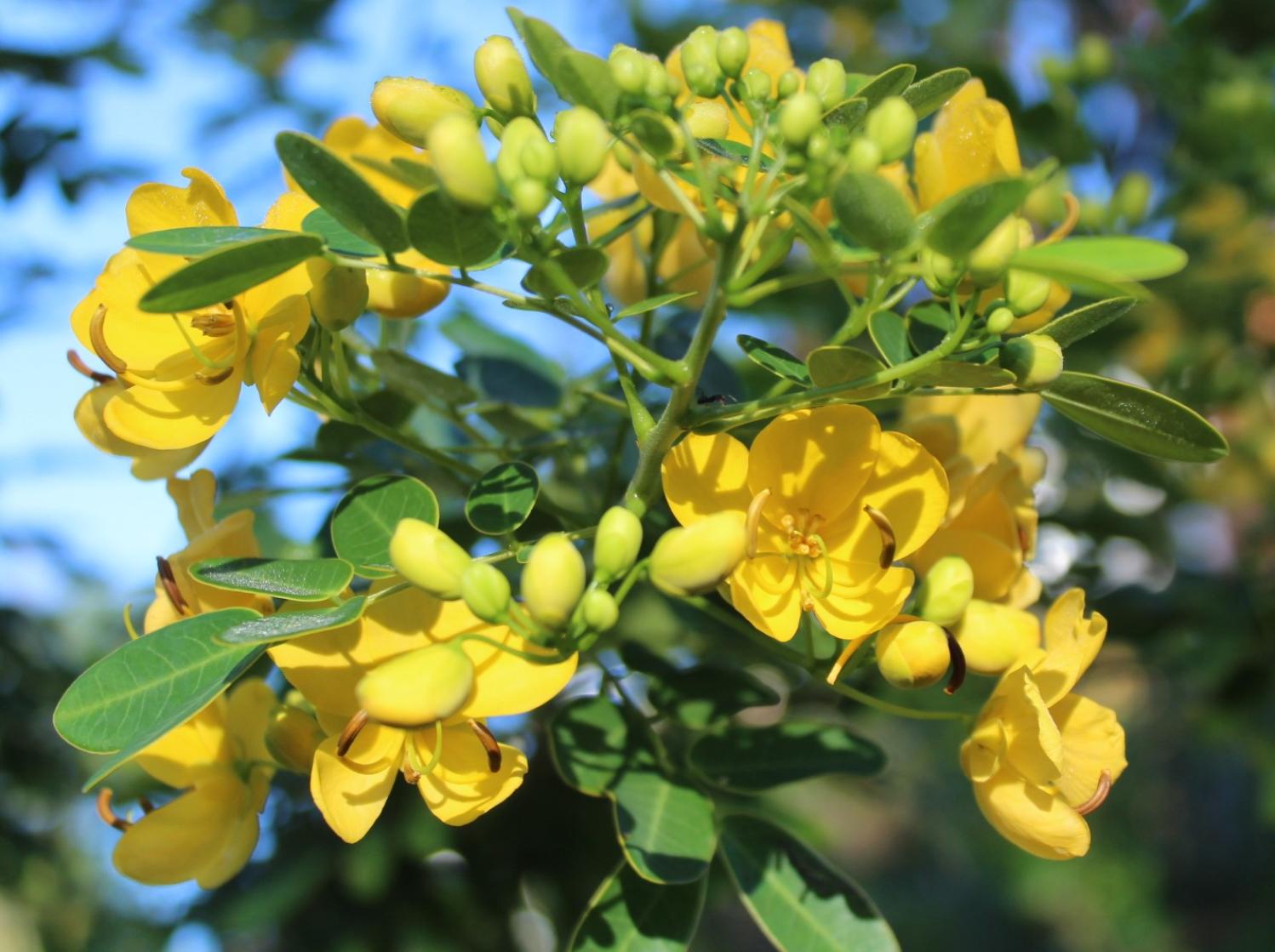
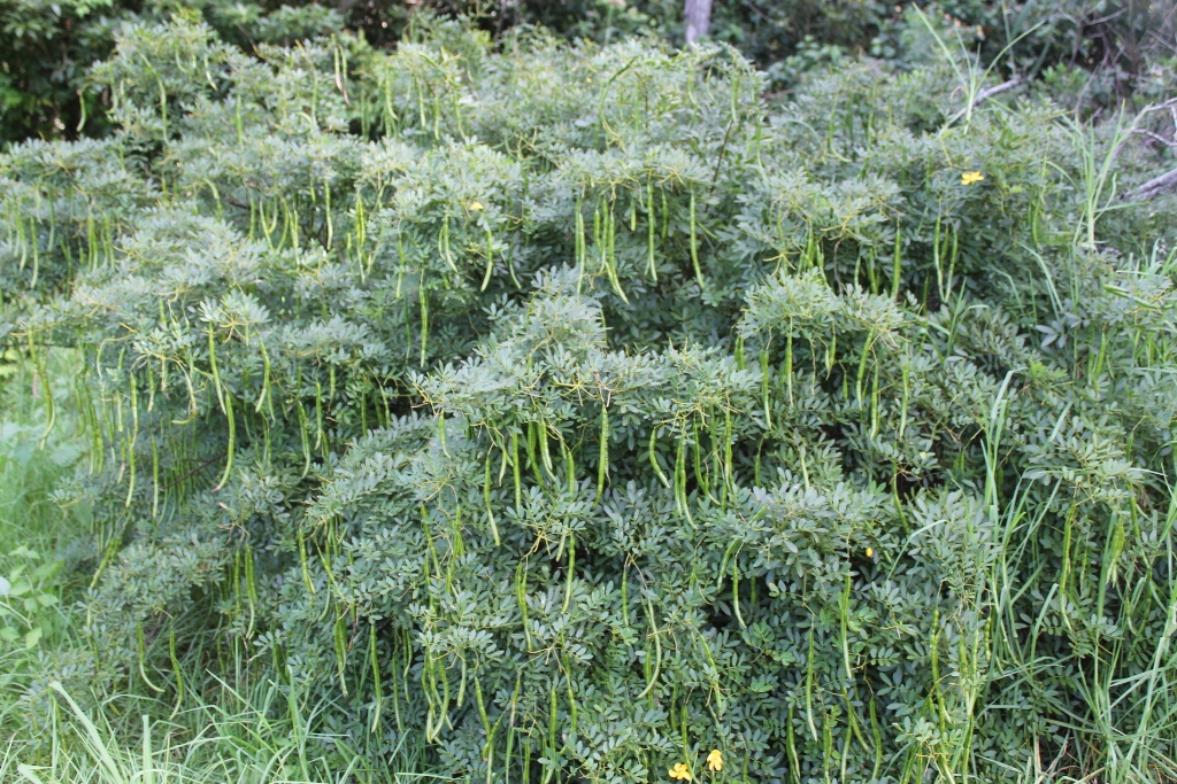
New Marine Wildlife Rescue Group On The Central Coast
A new wildlife group was launched on the Central Coast on Saturday, December 10, 2022.
Marine Wildlife Rescue Central Coast (MWRCC) had its official launch at The Entrance Boat Shed at 10am.
The group comprises current and former members of ASTR, ORRCA, Sea Shepherd, Greenpeace, WIRES and Wildlife ARC, as well as vets, academics, and people from all walks of life.
Well known marine wildlife advocate and activist Cathy Gilmore is spearheading the organisation.
“We believe that it is time the Central Coast looked after its own marine wildlife, and not be under the control or directed by groups that aren’t based locally,” Gilmore said.
“We have the local knowledge and are set up to respond and help injured animals more quickly.
“This also means that donations and money fundraised will go directly into helping our local marine creatures, and not get tied up elsewhere in the state.”
The organisation plans to have rehabilitation facilities and rescue kits placed in strategic locations around the region.
MWRCC will also be in touch with Indigenous groups to learn the traditional importance of the local marine environment and its inhabitants.
“We want to work with these groups and share knowledge between us,” Gilmore said.
“This is an opportunity to help save and protect our local marine wildlife, so if you have passion and commitment, then you are more than welcome to join us.”
Marine Wildlife Rescue Central Coast has a Facebook page where you may contact members. Visit: https://www.facebook.com/profile.php?id=100076317431064
- Ph: 0478 439 965
- Email: marinewildlifecc@gmail.com
- Instagram: marinewildliferescuecc

Watch Out - Shorebirds About
.JPG.opt1460x973o0,0s1460x973.jpg?timestamp=1663629195339)
Possums In Your Roof?: Do The Right Thing

Aviaries + Possum Release Sites Needed

Bushcare In Pittwater
Where we work Which day What time
Avalon
Angophora Reserve 3rd Sunday 8:30 - 11:30am
Avalon Dunes 1st Sunday 8:30 - 11:30am
Avalon Golf Course 2nd Wednesday 3 - 5:30pm
Careel Creek 4th Saturday 8:30 - 11:30am
Toongari Reserve 3rd Saturday 9 - 12noon (8 - 11am in summer)
Bangalley Headland 2nd Sunday 9 to 12noon
Bayview
Winnererremy Bay 4th Sunday 9 to 12noon
Bilgola
North Bilgola Beach 3rd Monday 9 - 12noon
Algona Reserve 1st Saturday 9 - 12noon
Plateau Park 1st Friday 8:30 - 11:30am
Church Point
Browns Bay Reserve 1st Tuesday 9 - 12noon
McCarrs Creek Reserve Contact Bushcare Officer To be confirmed
Clareville
Old Wharf Reserve 3rd Saturday 8 - 11am
Elanora
Kundibah Reserve 4th Sunday 8:30 - 11:30am
Mona Vale
Mona Vale Beach Basin 1st Saturday 8 - 11am
Mona Vale Dunes 2nd Saturday +3rd Thursday 8:30 - 11:30am
Newport
Bungan Beach 4th Sunday 9 - 12noon
Crescent Reserve 3rd Sunday 9 - 12noon
North Newport Beach 4th Saturday 8:30 - 11:30am
Porter Reserve 2nd Saturday 8 - 11am
North Narrabeen
Irrawong Reserve 2nd Saturday 2 - 5pm
Palm Beach
North Palm Beach Dunes 3rd Saturday 9 - 12noon
Scotland Island
Catherine Park 2nd Sunday 10 - 12:30pm
Elizabeth Park 1st Saturday 9 - 12noon
Pathilda Reserve 3rd Saturday 9 - 12noon
Warriewood
Warriewood Wetlands 1st Sunday 8:30 - 11:30am
Whale Beach
Norma Park 1st Friday 9 - 12noon
Western Foreshores
Coopers Point, Elvina Bay 2nd Sunday 10 - 1pm
Rocky Point, Elvina Bay 1st Monday 9 - 12noon
Friends Of Narrabeen Lagoon Catchment Activities

Gardens And Environment Groups And Organisations In Pittwater
Federal Government States It Is Using Every Tool In The Box To Conserve More Of Our Iconic Landscapes; Invites Feedback On Framework
- A geographically defined area other than a Protected Area, which is governed and managed
- in ways that achieve positive and sustained long-term outcomes for the in-situ conservation
- of biodiversity, with associated ecosystem functions and services and where applicable,
- cultural, spiritual, socio-economic, and other locally relevant values.
Australia’s 116 new coal, oil and gas projects equate to 215 new coal power stations
Richard Denniss, Crawford School of Public Policy, Australian National UniversityAustralia has 116 new coal, oil and gas projects in the pipeline. If they all proceed as planned, an extra 1.4 billion tonnes of greenhouse gases would be released into the atmosphere annually by 2030.
To put that in perspective, Australia’s total domestic greenhouse gas emissions in 2021–22 were 490 million tonnes. So annual emissions from these new projects would be the almost three times larger than the nation’s 2021-22 emissions. That’s the equivalent of starting up 215 new coal power stations, based on the average emissions of Australia’s current existing coal power stations.
The reason we can get away with this is the current global framework for emissions accounting only considers emissions generated onshore. And almost all coal, oil and gas from these new projects would be exported. But as we share the atmosphere with the rest of the people on the planet, the consequences will come back to bite us.
This week the Synthesis Report from the Intergovernmental Panel on Climate Change (IPCC) described how fossil fuels are wreaking havoc on the planet. The science is clear: the IPCC says fossil fuel use is overwhelmingly driving global warming.
“The sooner emissions are reduced this decade, the greater our chance of limiting warming to 1.5℃ or 2℃. Projected CO₂ emissions from existing fossil fuel infrastructure (power plants, mines, pipelines) without additional abatement exceed the remaining carbon budget for 1.5℃,” the IPCC says, let alone new coal, oil and gas projects.
In the words of UN Secretary General António Guterres:
Every country must be part of the solution. Demanding others move first only ensures humanity comes last.
Guterres added that “the Acceleration Agenda calls for a number of other actions”, specifically:
No new coal and the phasing out of coal by 2030 in OECD countries and 2040 in all other countries
Ending all international public and private funding of coal
Ensuring net zero electricity generation by 2035 for all developed countries and 2040 for the rest of the world
Ceasing all licensing or funding of new oil and gas – consistent with the findings of the International Energy Agency
Stopping any expansion of existing oil and gas reserves
Shifting subsidies from fossil fuels to a just energy transition
Establishing a global phase down of existing oil and gas production compatible with the 2050 global net zero target.
Hidden In Plain Sight
Our new research, released today by the Australia Institute, reveals the pollution from Australia’s 116 new fossil fuel projects. These are listed among the federal government’s major projects.
Government analysts estimate each project’s start date and annual production figures. If they are correct, by 2030 the projects would produce a total of 1,466 million tonnes of coal and 15,400 petajoules of gas and oil.
Then it’s fairly straightforward to calculate emissions. We simply multiplied these enormous new fossil fuel volumes by their “emissions factors”. When one tonne of coal is burned it releases approximately 2.65 tonnes of carbon dioxide or its equivalent (CO₂-e) into the atmosphere, and burning one terajoule (0.001 petejoules) of natural gas results in 51.5 tonnes CO₂-e.
Combined with the 164 million tonnes of emissions that the mining of these fuels would cause, the result is a planet-warming, but spine-chilling, total of 4.8 billion tonnes by 2030.
This amount is 24 times greater than the ambition of the federal government’s key emissions reduction policy, the so-called Safeguard Mechanism. That aims to reduce emissions by 205 million tonnes over the same period.
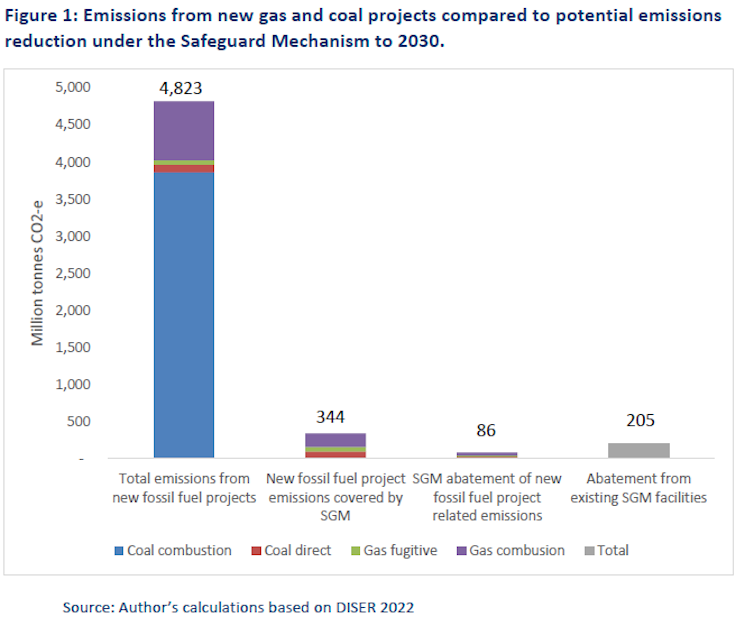
Rather than embrace the task of decarbonising the Australian economy, the Albanese government has continued down the path laid out by the former Coalition government. It’s a path that relies more heavily on the use of carbon offsets than curtailing coal and gas.
Even though the rest of the world is committed to burning less fossil fuels, there are more gas and coal mine project proposals in Australia today than there were in 2021.
Note also that this list does not include several large, advanced projects actively supported by Australian governments, including Santos’s Barossa gas field, Shell’s Bowen Gas Project, Chevron’s Cleo Acme, and several vast new unconventional gas basins including the Beetaloo, Canning and Lake Eyre basins.
3 Reasons To Change Our Ways
Climate Change Minister Chris Bowen argues that Australians are not responsible for the emissions from our fossil fuel exports. That’s because the international accounting rules distinguish between the emissions that occur within our borders (known as scope 1 and 2 emissions) and those that occur when other countries burn the coal and gas we sell them (known as scope 3 emissions).

But if Bowen really wants to tackle climate change, there are three reasons both he and Australians should bear this responsibility:
First, there’s the moral argument. Australia didn’t ban whaling and asbestos mining because we wanted to stop Australians from eating whales or building hazardous homes. We stopped these activities because they were dangerous. Countries can and do shape the world they live in.
Second, even just the emissions in Australia from these 116 new fossil fuel projects (their methane leaks, fuel use and other relevant emissions in Australia) will pour 344 million tonnes of greenhouse gas emissions into the atmosphere by 2030. That dwarfs the 205 million tonnes of emissions the entire Safeguard Mechanism is supposed to save over that same period.
And finally, leaving aside the risks of catastrophic climate change, which is admittedly a big ask, it is hard to overstate the risks to the Australian economy of continuing to focus our investment on the expansion of export industries that the rest of the world is committed to transitioning away from. If we aimed the $11 billion per year we spend on fossil fuel subsidies at decarbonising our economy, we would slash emissions in no time.
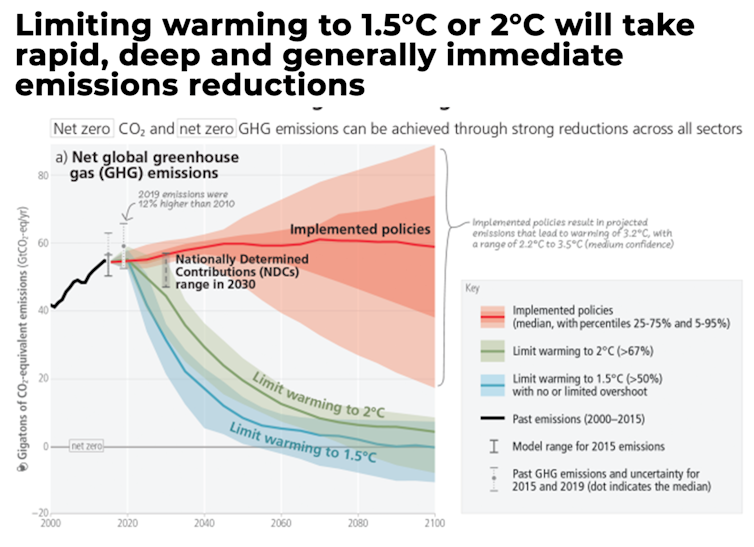
No New Coal, Oil And Gas
The Australian government continues to support unlimited growth in fossil fuel production and export, despite clear statements from the United Nations, International Energy Agency (IEA) and IPCC that new fossil fuel projects are incompatible with global temperature goals.
No matter where in the world Australian fossil fuels are burned, they will turn up the heat. We can’t escape the simple truth that humanity must stop burning fossil fuels. It’s the only path to a liveable future.![]()
Richard Denniss, Adjunct Professor, Crawford School of Public Policy, Australian National University
This article is republished from The Conversation under a Creative Commons license. Read the original article.
Species don’t live in isolation: what changing threats to 4 marsupials tell us about the future
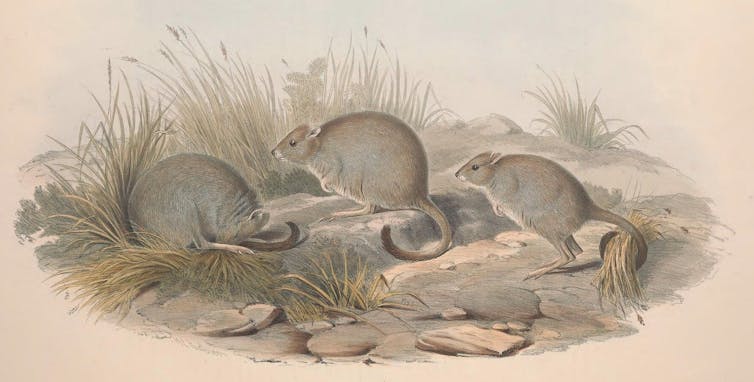
Conserving native wildlife is a challenging task and Australia’s unenviable extinction record shows us we urgently need more sophisticated and effective approaches.
Too often we focus on saving individual threatened species. But in the wild, species do not live neatly in isolation. They are part of rich ecosystems, relying on many other species to survive. To save species often means saving this web of life.
Our new research models what’s likely to happen to four well-known Western Australian marsupials in the biodiversity hotspot of south-western Australia, by identifying key drivers of their populations over time.
In the past, these species were most at risk from habitat loss. But when we ran our models forwards, we found all four species would be at more risk from climate change, which is bringing heightened fire risk and a drying trend to the region. Even better control of foxes – a major predator – did not offset the trend fully.
Our work adds further weight to efforts to protect ecosystems in all their complexity. The way species – including feral predators – interact takes place against a changing climate, fire regimes, and human-made change, like logging and grazing.
To give native species their best chance of survival, we have to embrace ecosystem-based conservation, rather than focusing on rescuing individual species.
What Did We Find?
We looked at long-term monitoring data to find out what was having the most impact on the woylie (brush-tailed bettong), chuditch (western quoll), koomal (western brushtail possum) and the quenda (southern brown bandicoot), four animals living in Upper Warren jarrah forests.

All four have undergone considerable population change over the last few decades and some are now threatened due to predation by foxes and feral cats, habitat loss and increased frequency of droughts and bushfires. To add to that, controlled burns, lethal fox control and timber harvesting have all taken place in our study region within this time. What we didn’t know was how these threats and conservation efforts interact.
To find out, we built a complex statistical model of the ecosystem to pinpoint what was driving population change geographically and over time.
We found the abundance of these species were affected most by the historical impact of habitat loss, as well as less food in the form of vegetation or prey due to the area’s ongoing decline in rainfall.
Of the habitat lost here, most was cleared during the 19th and early 20th centuries. But now it has more or less stopped, the legacies of this change continue through the effects of habitat fragmentation and increased incursion by introduced species. That means the main falls in abundance took place decades ago.
What about fire and foxes? These threats had less effect than habitat loss and rainfall declines, which we attribute to the broad management of both of these in the region. It was also difficult to quantify the effects of fox control because of the lack of control areas – essentially, comparable areas without poison baits in the region.
Our work shows there’s not one simple answer for managing this ecosystem. Everything is connected. We need to embrace this complexity so that we can better pinpoint where our actions can make a difference.
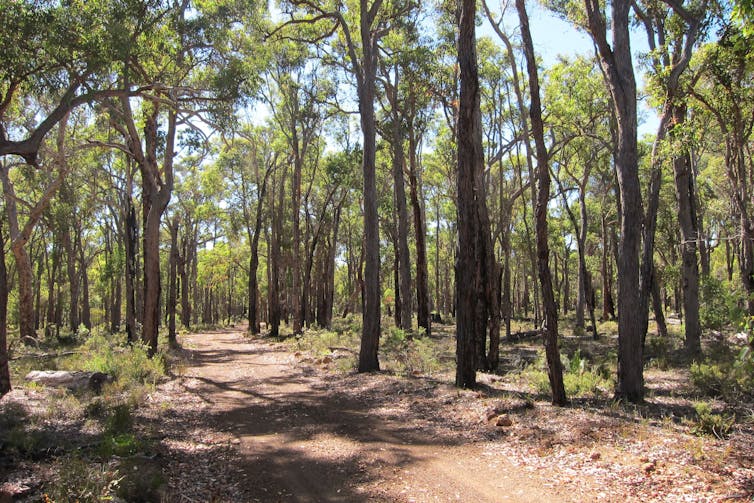
What’s Likely To Happen?
While habitat loss was the major historical threat, the future looks to be different. Severe fire is set to increase and rainfall reduce due to climate change. This indicates all four species will see falling populations.
Annual rainfall in south-western Australia has already fallen at least 20% below the historical average and further declines are expected. If severe fires arrive more often – and overlap with reduced rainfall – we could see even greater population loss.
These threats mean local conservation managers will be less able to help. Controlling fox numbers may help at present, but in a drier, fierier future, things will get harder.
Our modelling suggests that for woylie and koomal, lethal fox control could boost their resilience to severe fire and reduced rainfall, but not completely offset the expected losses.
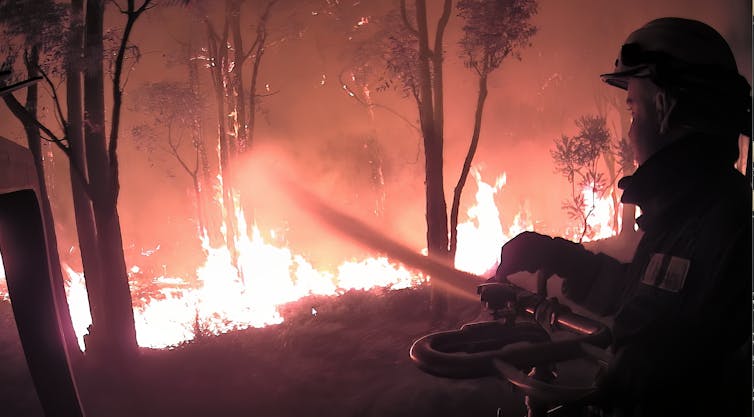
What Does This Mean For Ecosystem Management?
It’s long been a goal for conservationists to manage ecosystems as a whole. In reality, this is often incredibly difficult, as we need to consider multiple threats (such as fire and invasive species) and conflicting requirements of different species, in the face of uncertainty about how some ecosystems work, as well as limited budgets.
Ecosystems are complex webs of interacting species, processes and human influences. If we ignore this complexity, we can miss conservation opportunities, or see our actions have less effect than we expected.
Sometimes, well-intended actions can actually produce worse outcomes for some species, such as fox control leading to a boom in wallabies who strip the forest of everything edible.
Studies like ours wouldn’t be possible without the careful collection and synthesis of data over decades. As global climate change accelerates and the effects on ecosystems become increasingly unpredictable, conservation managers are flying blind if they do not have long-term monitoring to inform decisions on where and when to act.
So what can our conservation managers do? They can help ecosystems survive by doing two things. First, keep managing the threats within our control – such as invasive predators and ongoing habitat loss – to help reduce damage from other threats. Second, model and anticipate the effects of future change, and use that knowledge to be as prepared as we can. ![]()
William Geary, PhD Student, Deakin University; Adrian Wayne, Adjunct Senior Research Fellow, The University of Western Australia; Euan Ritchie, Professor in Wildlife Ecology and Conservation, School of Life & Environmental Sciences, Deakin University, and Tim Doherty, ARC DECRA Fellow, University of Sydney
This article is republished from The Conversation under a Creative Commons license. Read the original article.
How did millions of fish die gasping in the Darling – after three years of rain?
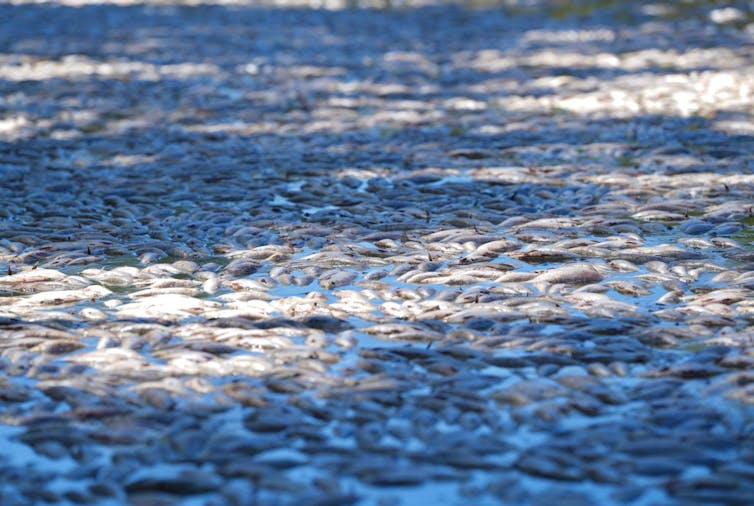
Millions of dead fish float on the surface of the river. Native bony herring and introduced young carp, as well as a few mature Murray cod and golden perch. History is repeating on the Darling River at Menindee. This new fish kill is even worse than the enormous 2018–2019 fish kill. And it’s in almost the same location.
But how can so many fish die when we’ve been having floods? What’s killing them?
In both 2018 and 2023, the immediate answer is the same: the fish ran out of oxygen. Five years ago, it was because the river was almost dry. This time, it’s likely to be factors like the heatwave days earlier, receding floodwaters, bacteria pulling oxygen from the water – and no escape.
But two events like this in five years speaks to a deeper cause. The Darling River – known as the Baaka by Barkandji Traditional Owners – is very sick. Too much of its water is siphoned off for agriculture. Our native fish are hardy. They’re used to extremes. But this is too much, even for them.
Short Term Pressure, Long Term Pain
I was a member of the expert panel investigating the 2018–2019 Menindee fish kills. Everyone agreed the fish ran out of oxygen. It was a very dry period, and a cool front arriving after a heat wave mixed deep low-oxygen river water with the thin top layer which had oxygen.
But our panel also examined the long-term changes to the river. We found the long-term cause for the river’s decline was simple: too much water was being diverted upstream.
It wasn’t just climate change – it was irrigation. We warned it could happen again. Now it has.
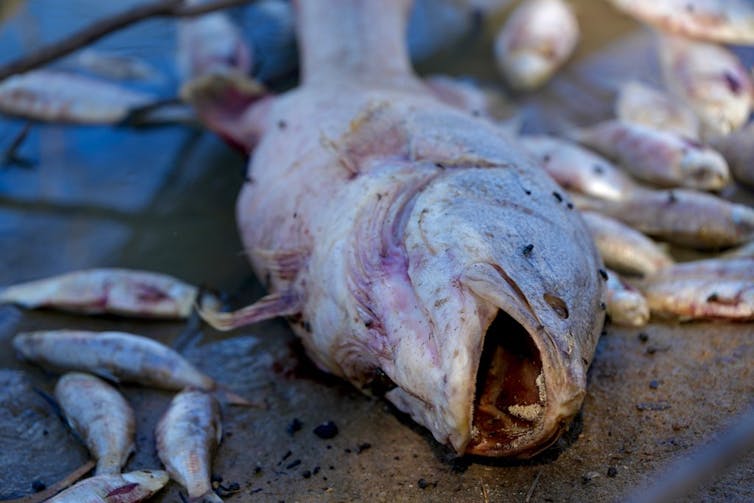
When faced with such environmental disaster, our leaders tend to reach for Dorothea MacKellar’s famous poem, My Country, and its line about a land “Of droughts and flooding rains.” Coalition water ministers at both federal and state level confidently blamed the drought for the first fish kill. Now, NSW premier Dominic Perrottet has linked this kill to the recent floods.
This is part of the reason. But only part. When floodwaters engorged the Darling and its tributaries, it was a bonanza for bacteria that broke down dead wood lying on the floodplain. Unfortunately, this explosion of microorganisms had a devastating side effect: they sucked oxygen out of the water.
This is what’s known as a blackwater event (in reality, more greeny-brown). As the floodwaters moved downstream and the Darling’s flow decreased, millions of fish fled the floodplains and found themselves crammed back in the narrow river channel where they were hit by plummeting oxygen levels.
Desperate, the fish looked to escape. But upstream, their exit was blocked. In December, authorities had fully opened the gates to the Menindee main weir for the first time in a decade to let fish migrate. But now the gates are shut.
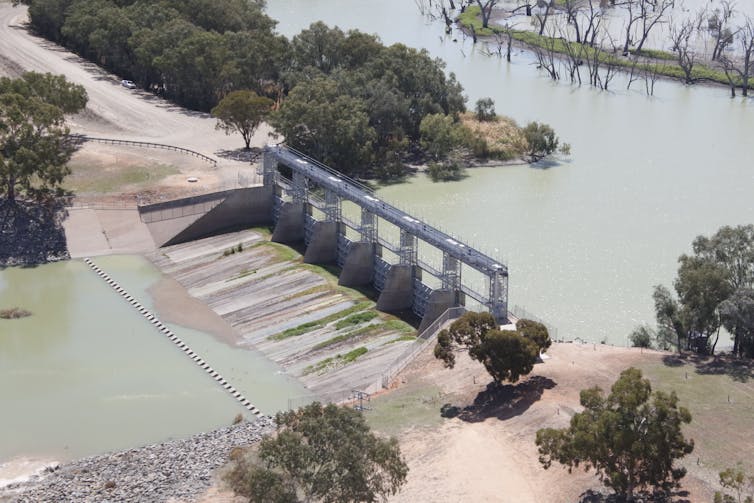
They couldn’t get into the main Menindee Lakes, where they might have found water with more oxygen, as they were blocked by the regulators – large taps used mainly to let water out.
Could they escape downstream? Perhaps some did. But for millions of fish, there was no time. Their bodies will only make the problem worse, as tonnes of rotting fish deposit vast quantities of nutrients into the river. That’s great for bacteria, algae and some fish-eating birds. But it’s not healthy for the river, its fish, or its people.
Yes, fish kills have always occurred but not at this scale. The fundamental reason the fish of the Darling keep dying is because there is not enough water allowed to flow.
Why Is The Darling In Such Trouble?
Since the 1980s, the Darling’s tributaries have steadily shrunk. The Macquarie, the Namoi, the Gwydir, the Border Rivers and the Condamine-Balonne are all shadows of the rivers they once were. Much of their water is captured in large dams, like Burrendong Dam, or intercepted by floodplain harvesting, which was legalised only last year by the NSW Government to the dismay of environmentalists and farmers downstream.
Just last week, before news of the fish kills at Menindee, water allocations in the Namoi and Gwydir Rivers were a staggering 113% and 275% respectively. That is to say, all the water farmers and other users could take from these rivers is well beyond the total flows left in the rivers.
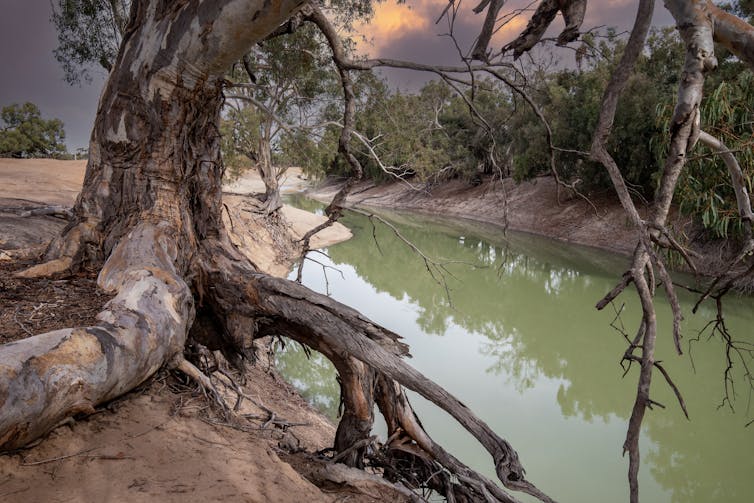
The fish kills at Menindee are the clearest sign yet of how policy and management have failed the Darling. These catastrophes were inevitable. And the pain isn’t limited to fish. We are suffering too.
Taxpayers forked out nearly half a billion dollars for a pipeline from the Murray to Broken Hill, which nearly ran out of water in 2019. Why? Because the Darling was no longer dependable. In 2019, the towns of Wilcannia and Brewarrina ran out of water, significantly affecting Aboriginal communities. Why? Because the Darling was so low.
Fish kills like this one make news for a few days, and then get forgotten. But unless we tackle the fundamental problem of a lack of water in our rivers, there will be many more to come. This is not a natural disaster. It is man-made. ![]()
Richard Kingsford, Professor, School of Biological, Earth and Environmental Sciences, UNSW Sydney
This article is republished from The Conversation under a Creative Commons license. Read the original article.
Our mysterious night parrot has terrible vision – but we discovered it might be able to hear like an owl
Elen Shute, Flinders University; Alice Clement, Flinders University, and Gavin Prideaux, Flinders UniversityOne bird bucks the stereotype of Australia’s raucous parrots – the mysterious and critically endangered night parrot (Pezoporus occidentalis). Rather than flying around in noisy flocks or eating fruit in trees, the night parrot roosts all day in a clump of sharp spinifex grass. When darkness falls, it scurries about on the ground to forage, almost like a little rodent.
For eight decades, we thought it might be extinct. But then, in 2013, it was photographed. Now we know this vanishingly rare nocturnal bird still lives in parts of the remote outback.
Because it’s so rare, it’s very hard to study. In our work in palaeontology, we recently identified some fossil leg bones as probably belonging to the night parrot. Because there were no modern skeletons to compare them with, we had to CT-scan a museum specimen.
What we intended to do was compare the leg anatomy to our fossil leg bones. But then we found something bizarre. The night parrot’s skull was wonky and the ears were asymmetrical. Predatory owls have this too, as a way to boost their hearing and hunt better. But why would a seed-eating parrot need superb hearing?
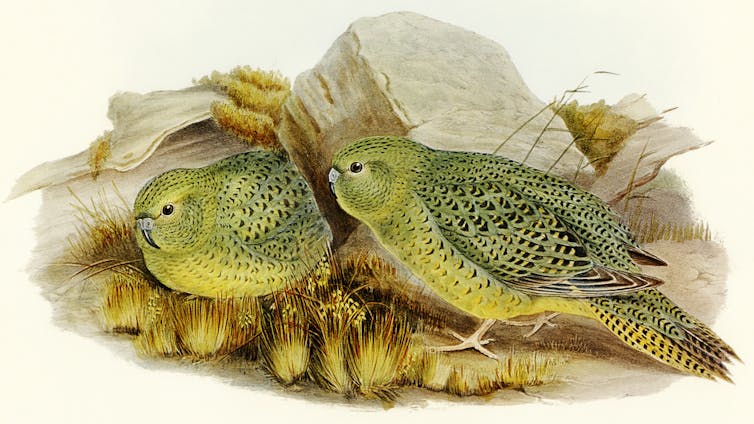
Of Wonky Skulls And Offset Ears
In our new research, we offer the first anatomical description of the night parrot’s skull. In this, we were fortunate to be allowed to scan the precious type specimen held by the Natural History Museum in London. This is the original skin used by John Gould, the preeminent 19th century English ornithologist, to formally describe and name the night parrot in 1861.
We used high-resolution CT scans to look inside this museum “skin”, a dried specimen with internal organs removed, feathers on the outside and a partial skeleton on the inside.
The scans showed the left side of the skull did not mirror the right. Skull asymmetry isn’t unheard of in nocturnal birds. Many species of owl have offset ears and dramatically distorted skulls, which allows them to pinpoint any sound made by intended prey. But we certainly weren’t expecting it in a parrot.
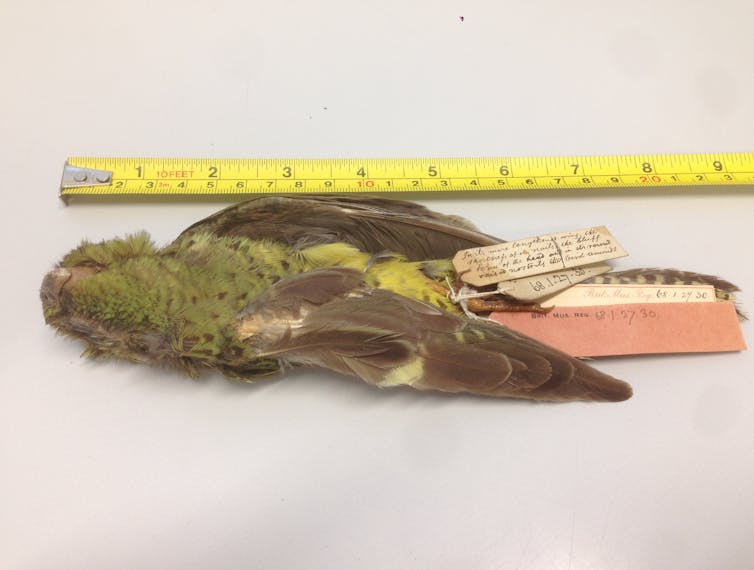
Wired For Sound?
When we looked closely at the night parrot’s skull, we spotted telltale clues of a bird specialising in hearing. Asymmetry is part of it: the left ear opening is flat while the right one arches out to the side.
In uneven-eared owls, one ear is typically placed higher than the other. In flight, sound waves travelling from ground level hit each ear at slightly different times. This tiny difference in timing allows the owl’s brain to calculate precisely the sound’s origin on a vertical plane.
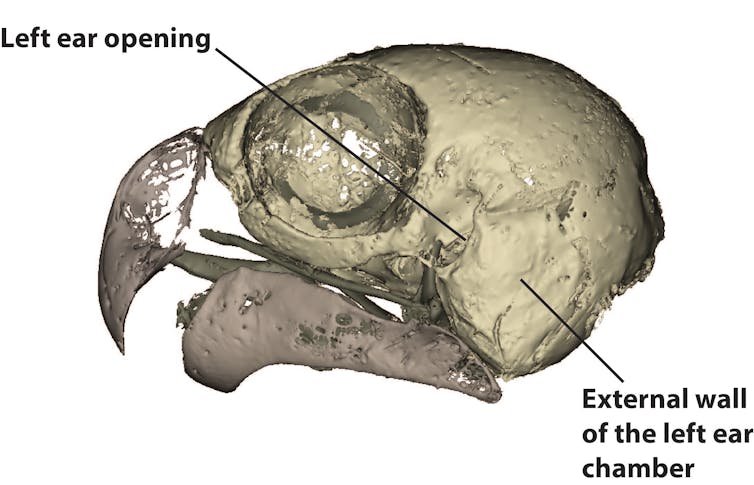
But night parrots don’t hunt fast-moving prey. They mostly eat seeds, so they probably don’t use asymmetrical ears to locate food.
While owl ears are positioned at different heights on the skull, this isn’t the case for the night parrot. The major difference between the parrot’s ears is how far they stick out sideways. This might help them locate the direction a sound comes from horizontally, which would make sense for a bird living almost entirely at ground level.
This could be useful to listen for predators, keep contact with their mates and young, find new potential mates, or to scan their habitat for competitors.
Adding to the evidence for excellent hearing is the size of this parrot’s ear chambers. Compared to other parrots, an unusually large volume of the night parrot’s skull is devoted to the external ear chamber – fully one third of the length of its head. These enlarged ear chambers may act like amplifiers, increasing the volume of sound transferred to the inner ears. This suggests it would be wise to keep the noise down in their habitat until we know more about their hearing.
Bigger Ears, Smaller Eyes
A previous study found the night parrot has small optic nerves and reduced optic lobes in the brain for processing vision. From this, the researchers inferred the nocturnal parrot probably sees poorly in the dark. Despite this, it expertly navigates its dark world, flying up to a 30 kilometre round trip in a night to find food and water, before returning home to the same spinifex hummock where it roosts before sunrise.
Now that we’ve examined the skull, we can see the same clues. Vision appears to have been traded for hearing. Inside an animal skull, real estate is precious. Heads are heavy and cumbersome, and there’s only so much you can evolve to fit inside one. Enlarged ear chambers appear to constrain the maximum size of a night parrot’s eyes.
Even so, this bird has crammed in as much as it can. It has an outsized head compared to its body. Gould described the parrot’s “thick bluffy head” as one of the features defining the species.
When we measured the scleral ring – the circular bone supporting the eyeball – and compared it to other birds, we found telling differences. A night parrot’s cornea is about as small as it can possibly be while still allowing visually guided nocturnal flight. A millimetre or two smaller and they wouldn’t get enough light into their eyes to see in the dark.
This remarkable parrot is one of 22 threatened birds prioritised by the federal government for recovery. We hope ecologists can make the most of this to find out what we need to do to bring night parrots back from the brink. We’re only beginning to learn how unusual they are. ![]()
Elen Shute, Researcher, Flinders University; Alice Clement, Research Associate in the College of Science and Engineering, Flinders University, and Gavin Prideaux, Associate professor, Flinders University
This article is republished from The Conversation under a Creative Commons license. Read the original article.
Stressed Out: Mapping The Human Footprint On Coastal Areas Globally
March 20, 2023
A global mapping project led by University of Queensland researchers has revealed the major stressors placed upon global coastlines by human activity.
The team quantified and mapped the presence and extent of major land-based and marine stressors, finding that 97 per cent of coastal areas globally had at least one major stressor present.
Professor Salit Kark from UQ's School of Biological Sciences said the research team were surprised at the sheer extent and far-reaching impact revealed by the footprint map created.
"There is hardly anywhere on the planet, outside of the polar and arctic regions, that does not show some form of human pressure on their coastline," Professor Kark said.
"In essence, we have influenced the majority of coastal areas globally.
"We therefore should aim to map and understand our impacts, and also leave some untouched coastlines."
UQ PhD candidate Hannah Allan said the research outlined the spatial extent and magnitude of 10 major land-based stressors and 10 major marine stressors that occur across coastlines globally.
"The threats human activity pose to coastal ecosystems and biodiversity come from both the land and sea, sometimes arriving far from human activity," Ms Allan said.
"Therefore, coastal conservation must incorporate land-sea connections.
"Human population size, tourism, and roads were some of the biggest contributors to the terrestrial component of Australia's coastal human footprint.
"As for marine stressors, increasing sea surface temperatures, nutrient pollution, and shipping were found to be major drivers of human pressure on Australian coastlines."
Professor Noam Levin said a map of this kind, which assembles both terrestrial and marine stressors and presents the coastal human footprint globally, has rarely been attempted.
"This research offers valuable insights that could help decision-makers and managers identify where to mitigate particular impacts," Prof. Levin said.
"For example, the database underlying the human footprint can show specific areas with high oil and gas operations, such as in Western Australia.
"This can help develop preparedness procedures for the very realistic chance of environmental disasters that impact coastal areas, such as oil spills.
"An added benefit of our new global map is that it helps prioritise these decisions based on how widespread the potential pressures of our human footprint in certain areas of the world might be.
"Coastal areas, where 90 per cent of Australians live, were not immune to these stressors.
"For Australia, the highest human footprint was found in the coastal cities, in the order of Melbourne, Sydney, Perth, Adelaide, and Brisbane.
"We also mapped 160 areas on the planet with the most pristine coastal areas, including several in Australia.
"Of those, nearly 40 per cent were totally unprotected -- opening an opportunity to identify coastal areas for further conservation actions.
"A key finding was that light pollution is increasing, with more white LEDs being used, placing great strain on areas of high importance for biodiversity, disrupting the natural patterns of wildlife."
Moving forward, researchers are looking to fine-tune the mapping process, looking more specifically at Australia's coastlines.
"Our plan is to develop high-resolution coastal footprint mapping for specific coastal areas in Australia, using finer detailed layers that are currently not available at a global scale," Professor Levin said.
Hannah Allan, Noam Levin, Salit Kark. Quantifying and mapping the human footprint across Earth's coastal areas. Ocean & Coastal Management, 2023; 236: 106476 DOI: 10.1016/j.ocecoaman.2023.106476
What is myrtle rust and why has this disease closed Lord Howe Island to visitors?
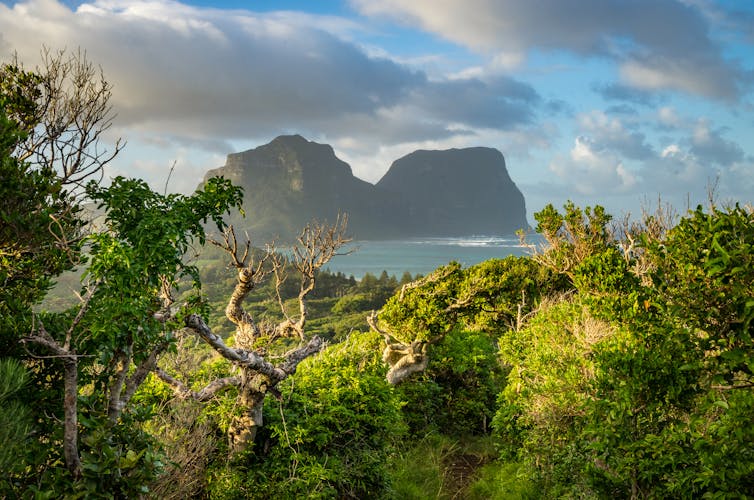
Some 70% of the World Heritage-listed Lord Howe Island has been closed to non-essential visitors in response to a recurrence of the plant disease myrtle rust.
Myrtle rust, native to South America, was first detected in Australia on the Central Coast of NSW in April 2010. It is caused by a fungus that belongs to a group of plant pathogens known as the rusts.
Rusts are among the most feared of all plant pathogens. They spread rapidly over thousands of kilometres on wind currents and can cause huge losses in plant production.
For example, wheat rust research over the past 100 years at the University of Sydney has shown clear evidence of wind-borne rust spores travelling from central Africa to Australia. Wheat production losses due to rust have at times totalled hundreds of millions of dollars.
Myrtle rust rapidly invaded the entire east coast of Australia in the years after it was first detected. It has caused the near extinction of at least three rainforest species, including the native guava (Rhodomyrtus psidioides) and the scrub turpentine (Rhodamnia rubescens).
The disease was detected at Lord Howe Island in 2016, and eradicated. Now it has managed to spread there once again. There are concerns if the disease is left unchecked, it could seriously alter the unique ecology of the island. Lord Howe is home to some 240 native plant species, of which more than 100 are not found anywhere else.
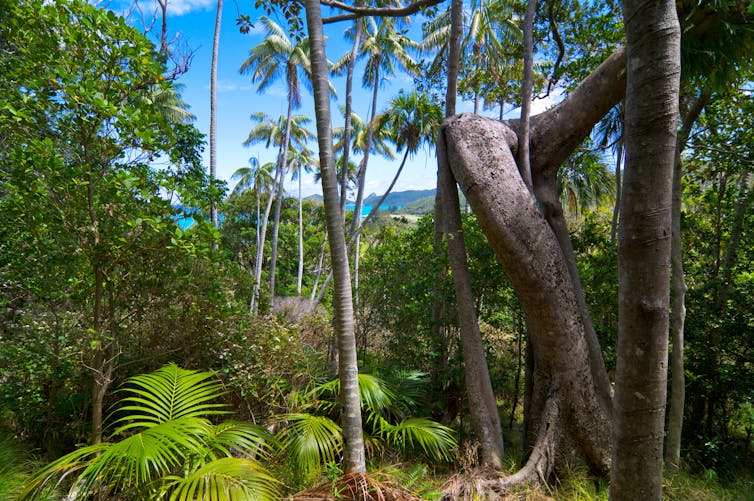
How Can The Disease Be Controlled?
Rust diseases in agriculture are controlled by the cultivation of genetically resistant plants, or by use of fungicides. These fungicides can kill existing recent infections and provide protection for up to four weeks. In other situations, such as horticulture and native plant communities, fungicides are used together with removal and destruction of infected plants.
The 2010 detection of myrtle rust in Australia followed its detection in Hawaii in 2005 and China in 2009. It was later found in New Caledonia (2013) and New Zealand (2017). Research has shown the same strain – known as the “pandemic strain” – has appeared in all of these countries. Several other strains occur in South America.
It is likely the fungus spread to Lord Howe Island from eastern Australia on wind currents. The especially wet conditions along the east coast of much of Australia in 2022 led to an increase in the disease there. This, in turn, increased rust spore load and hence the chance of long-distance spore dispersal.
In addition to being spread on the wind, the rusty coloured spores produced by these fungal pathogens stick readily to clothing. These spores remain viable for at least two weeks under ambient conditions. Several wheat rusts of exotic origin are believed to have been accidentally brought in to Australia on travellers’ clothing from North America and Europe.
The chance of inadvertent spread of myrtle rust on contaminated clothing is why access to Lord Howe island has been restricted since last week.
The second incursion into the island clearly shows how incredibly difficult rust diseases are to manage once they reach a new region. It points to possible recurrences of the disease there in years to come even should current efforts to eradicate it succeed.
On top of the ability of rust diseases to spread rapidly over large distances, a further complication in controlling myrtle rust is it infects a wide range of native plants. Some of these species hold great cultural significance and/or are endangered.
Endemic species of the myrtle plant family Myrtaceae that are dominant in many of the plant communities on Lord Howe Island are highly vulnerable to myrtle rust infection. Of critical concern are two species that occur only on the island: the mountain rose (Meterosideros nervulosa) and the rainforest tree scalybark (Syzigium fullagarri). The rust infects young leaves and also flowers, where it causes sterility.
Australia Brings Expertise To The Battle
Australia has some of the best plant pathologists in the world and has long been a leader in controlling rust diseases in agriculture. This expertise, combined with world-leading scientists in the ecology of Australian native plants, has enabled solid progress in understanding myrtle rust in the Australian environment. Australian scientists have joined hands with New Zealand scientists to boost efforts to control the pathogen in both countries.
Research is also under way at the University of Sydney and Australian National University to develop new DNA-based diagnostics to allow rapid identification of the different strains of the pathogen. These tests are especially important given only one strain of myrtle rust occurs in the Asia-Pacific and Oceania regions.
The success of managing the impact of myrtle rust on the region’s iconic flora against a backdrop of climate change will rely heavily on undertaking the research needed to gain a much better understanding of this damaging plant pathogen. Recognising this, staff at the University of Sydney have convened a conference for June 21-23 this year. It will bring together myrtle rust experts to exchange their latest research findings and identify priority areas for research.![]()
Robert Park, Judith and David Coffey Chair in Sustainable Agriculture, Plant Breeding Institute, University of Sydney
This article is republished from The Conversation under a Creative Commons license. Read the original article.
New research reveals how forests reduce their own bushfire risk, if they’re left alone
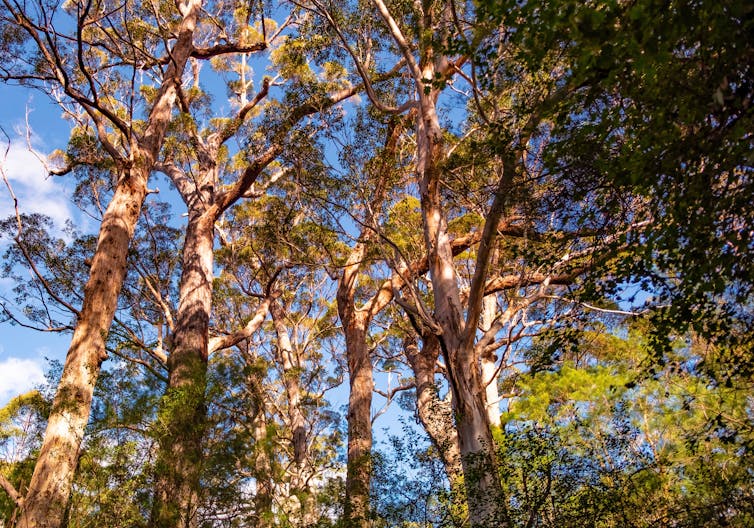
Fire management in Australia is approaching crisis point. Seasons such as the Black Summer three years ago showed how our best efforts in fire-fighting and prescribed burning are insignificant in the face of a changing climate.
But what if forests have their own tools to manage bushfire risk, and we could tap into them?
We know long-unburnt mountain forests in south-east Australia are far less fire-prone than more recently burnt areas. And forests in south-west Australia have the lowest fire risk when they’ve not been subjected to prescribed burning.
Our study just published set out to understand why this occurs, by modelling fire behaviour in iconic red tingle forests of south-west Australia. Our findings offer a clear set of tools for living with fire, even in a warming climate.
The ‘Fuel Load’ Dilemma
Most bushfires in the south-west forests of Western Australia occur in areas burned specifically to reduce fuel loads.
Current fire management by government agencies focuses on broadscale burning to reduce fuel load. The practice is also known as prescribed, planned, controlled or hazard-reduction burning. It aims to reduce the intensity of future fires at a location by burning leaf litter and other fine surface matter.
Fuel-load reduction is premised on the idea that the amount of fuel in a forest determines how flammable it is. The idea comes from early attempts at fire behaviour modelling imported from the United States in the 1960s.
But more recent work has shown prescribed burning can lead to catastrophic outcomes. This includes the near-destruction of critically endangered wildlife populations and the destruction of homes when prescribed burns escape.
So what can be done? Our study on the iconic red tingle (Eucalyptus jacksonii) deals with this dilemma.
Getting To Know The Red Tingle
Red tingles are among the tallest eucalypts, growing up to 70 metres. They grow only in a 6,000-hectare stretch along the high-rainfall south coast of Western Australia.
Red tingles can live for more than 400 years. They regenerate well after fire – even an intense fire – and form naturally mixed aged forests dominated by large old trees.
But red tingles are sensitive to frequent fires, no matter how mild. Flames can enter the tree and hollow it out, eventually causing its collapse.
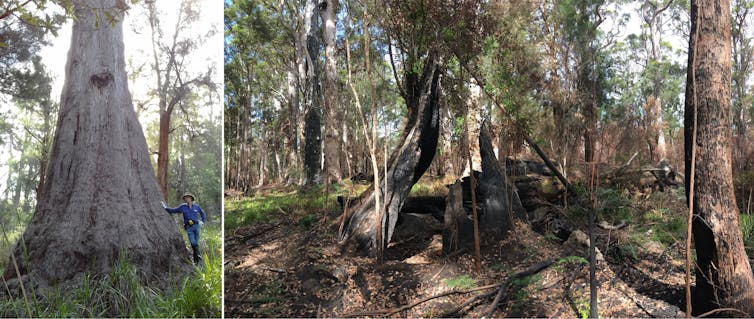
The understorey of red tingle forest consists of tall, long-lived shrubs that germinate prolifically after fire. These understoreys thin and open as they age.
The goal of our research was to understand how these changes in red tingle forests affect fire behaviour. To do this, we used an advanced fire modelling tool developed by the lead author of this article, Phillip Zylstra, and his colleagues.
The tool doesn’t use a simple number to characterise a forest’s fuel load. Instead, it uses hundreds of thousands of calculations to determine which plants will ignite – and importantly, which plants won’t ignite but will instead calm the flames.
So what did we find? As the understorey of red tingle forest ages and thins, the lower branches of taller plants “self-prune” – in other words, they shed dead leaves and twigs.
When this litter is on the ground, it begins to decay and poses a lower fire risk than if it were still suspended.
The lower branches of taller plants, once self-pruned, are then less likely to ignite as fuel. Instead, they act as “overstorey shelter” that reduces wind speed and fire severity. In this way, mature forests control fire rather than drive it.
Our study showed that, due to this calming effect, fires in mature red tingle forests could be extinguished by firefighters most of the time.
By contrast, our study showed that prescribed burning in red tingle forests creates dense regrowth, which burns severely during bushfires. In such cases, our study showed firefighters are often unable to extinguish the flames and must resort to backburning - a risky fire suppression technique.
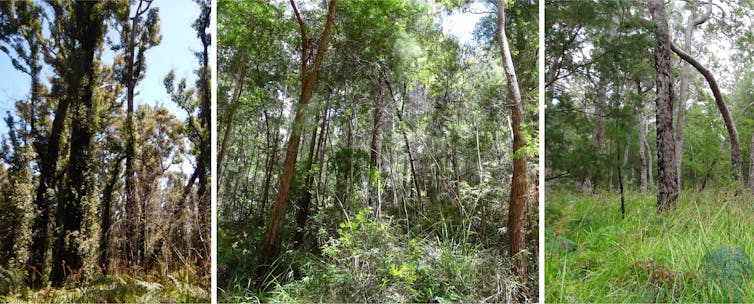
Making Peace With The Bush
Contemporary fire management approaches, and their dependence upon broadscale prescribed burns, contrast starkly with the approach of Australia’s First Nations people.
Menang and Goreng Traditional Owners of red tingle and surrounding forests say fire should be used in specific locations, burning only what is needed in small, strategically placed patches. Wadandi Pibulmun Yunungjarlu Elder Wayne Webb advised our team that Traditional Owners deliberately excluded fire from tall red tingle forests.
In our contemporary context, we can co-operate with the landscape - balancing the effects of climate change by using specialist fire-fighting skills and technological advances to reinforce safe forest havens.
The fire risk in WA’s south-western forests, and many other eucalypt forests, is so much lower if they’re left unburnt and allowed to mature. Our analysis of red tingle forests helps explain why.
One thing is clear: if we still want forests in our flammable country, we must stop burning their defences away.![]()
Philip Zylstra, Adjunct Associate Professor at Curtin University, Research Associate at University of New South Wales, Curtin University and Grant Wardell-Johnson, Adjunct Associate Professor, Molecular and Life Sciences and ARC Centre for Mine Site Restoration., Curtin University
This article is republished from The Conversation under a Creative Commons license. Read the original article.
The Great Southern Reef is in more trouble than the Great Barrier Reef
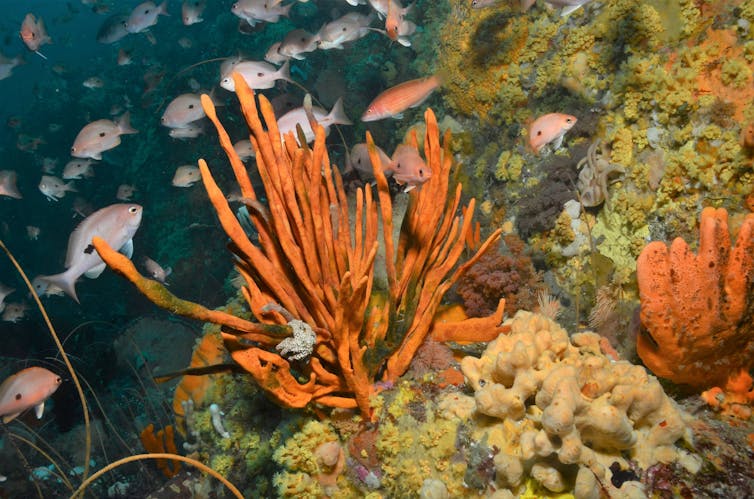
Marine heatwaves are damaging reef ecosystems around Australia, but while the tropical north has received the lion’s share of the attention to date, we equally need to worry about the temperate south.
That’s partly because the Great Southern Reef is of immense biodiversity value. Species found here are found nowhere else in the world. Even their distant relatives are long gone. It’s also because these temperate reefs are suffering even more from heatwaves than the Great Barrier Reef.
After 30 years counting thousands of marine species on Australian reefs, we could see the situation was changing rapidly. But our research team wasn’t able to survey enough locations to adequately track the changes. These occurred out of sight, beneath the waves, off coastlines extending thousands of kilometres. We realised we needed help.
So we enlisted the help of enthusiastic volunteer divers to complete the world’s first continental audit of shallow marine life. This unique Australian effort was a tremendous collaborative achievement. But it’s nothing compared to what’s needed in the years to come, to defend our reef ecosystems from the impacts of climate change and other human pressures.
Answering Questions With Data
Our goal was to answer crucial questions from managers, including:
which marine species are rapidly heading towards extinction?
how can threats to reef species be addressed cost effectively?
how large do marine reserves need to be, to achieve conservation goals?
which regulations work best?
Our solution was to headhunt the most enthusiastic and experienced recreational divers, then train them to scientific standards in underwater survey methods.
More than 200 highly trained volunteers have now participated in the Reef Life Survey of Australia. Together they have counted more than 3,000 species of fishes, corals and other invertebrates at over 2,500 sites around Australia, including offshore locations not previously visited by divers.
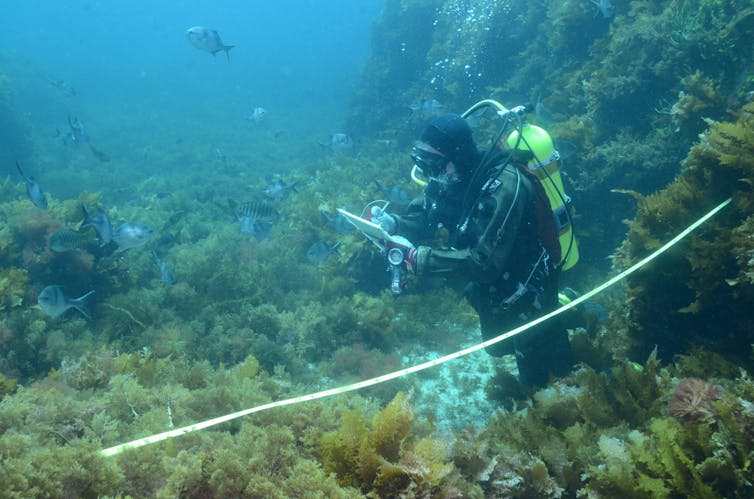
This information, combined with survey data from the Australian Temperate Reef Collaboration (collected using similar methods) and the Australian Institute of Marine Science in Queensland, has allowed us to produce the first continental audit of shallow marine life completed anywhere in the world. Our new research is published today in the journal Nature.
Our investigation revealed that heatwaves have damaged many (but not all) reef communities over the past decade. The effects have been patchy. Some reef populations have been devastated, other reefs nearby have declined and recovered, and others have flourished.
Species tended to increase numbers in years when water temperatures rose less than 0.5℃ above average, but declined rapidly once this heatwave threshold was passed. Overall, more species were declining than increasing.
Coral density has showed little overall change across the Great Barrier Reef since 2010. Many, but not all, coral reef communities impacted by the 2016 heatwave have recovered. Coral populations tended to decline in the north, show little change in the central region, and increase in the south.
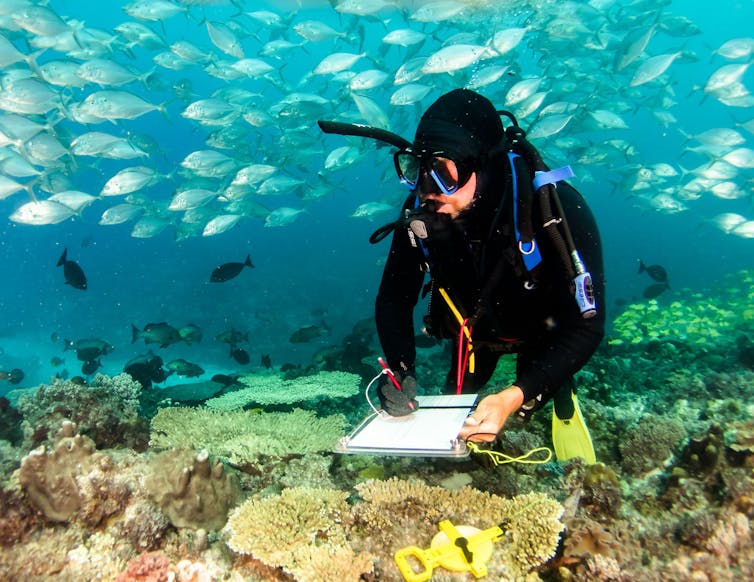
Around Australia, fishes, mobile invertebrates such as crabs, snails and seastars, and seaweeds showed similar responses to warming. Numbers typically declined in the north of species’ ranges and increased in the south. The increasing abundance of warm water species in the south has, however, squeezed populations of cold water species.
At the limit, southern Tasmanian species trapped by the deep Southern Ocean barrier cannot migrate further south. The common sea dragon (Phyllopteryx taeniolatus), for example, has declined in numbers by 57% over the past decade across monitoring sites.
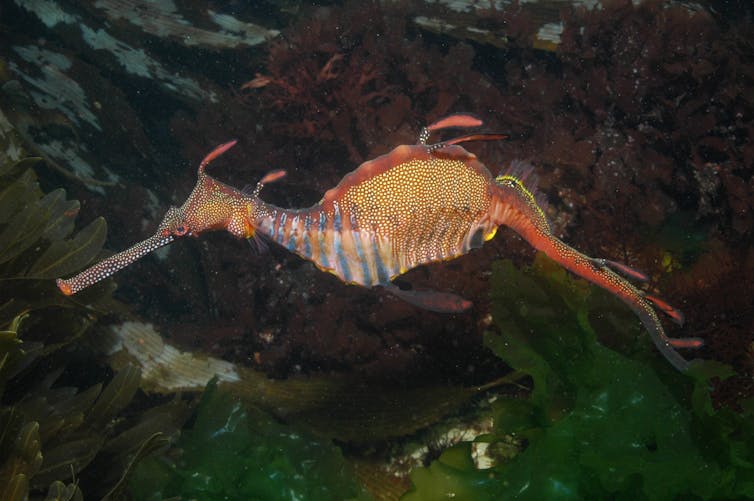
Many species living on Tasmanian reefs, particularly echinoderms such as sea stars and sea urchins, have shown precipitous population declines over the past decade.
A strong heatwave off southwestern Australia in 2011 also caused seaweed populations to drop rapidly. Most affected seaweeds remain at greatly reduced levels.
Overall, cool-temperate species inhabiting the Great Southern Reef - the interconnected network of kelp-covered rocky reefs that extends from northern New South Wales to southwestern Australia — are generally declining in number more rapidly and are more threatened with extinction, than tropical species.
This is perhaps not surprising given that Great Southern Reef species live in a climate change hotspot (where sea temperatures are rising more rapidly than elsewhere worldwide) along the most densely populated Australian coast. Impacts from infrastructure development, catchment degradation, pollution and fishing are widespread.
Why The Southern Reef Is So Great
Australia’s southern reefs - in temperate waters between the tropical north and the Southern Ocean - are hotspots of biodiversity. Most species are found nowhere else in the world (70% of the temperate species surveyed were endemic to Australia). In contrast, almost all of the tropical species censused in our study are widely distributed across the Indo-Pacific (only 3% endemic to Australia).
Furthermore, temperate Australian species often have no close relatives. Their evolutionary roots run deep. Examples include the red velvet fish (Gnathanacanthus goetzii) and the giant creeper snail (Campanile symbolicum). Both species sit alone in their families, and were found in our census to have rapidly declining populations.
Worldwide, the most threatened fish family is the handfishes. This is a group of 14 species restricted to southeastern Australia, primarily Tasmania. The critically endangered red handfish (Thymichthys politus) and spotted handfish (Brachionichthys hirsutus) have declined to tiny populations of around 100 (red) and 5000 (spotted) individuals living in shallow bays near Hobart. The smooth handfish (Sympterichthys unipennis) is probably already extinct.
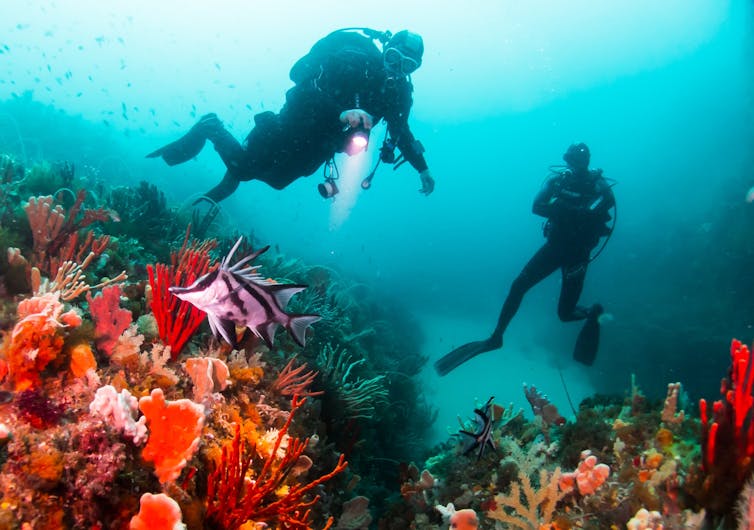
What We Stand To Lose
The loss of most Australian marine species will likely occur unseen. Government funding does not generally support systematic monitoring of native plants and animals.
Data provided by volunteer Reef Life Survey divers has provided the only population trend information for over 1,000 species, while tens of thousands of species lack any information at all. Only the Great Barrier Reef Long Term Monitoring Program run by the Australian Institute of Marine Science receives dedicated funding covering marine habitats.
Until more attention is paid to the conservation of temperate marine species, the living heritage of future generations will continue to slip away. We will also remain in the dark as to what already has been lost. The little public, scientific or management attention paid to the Great Southern Reef belies its status as a global marvel, and one that is highly threatened.![]()
Graham Edgar, Senior Marine Ecologist, Institute for Marine and Antarctic Studies, University of Tasmania
This article is republished from The Conversation under a Creative Commons license. Read the original article.
Fishing for data: commercial fishers help monitor rising temperatures in coastal seas
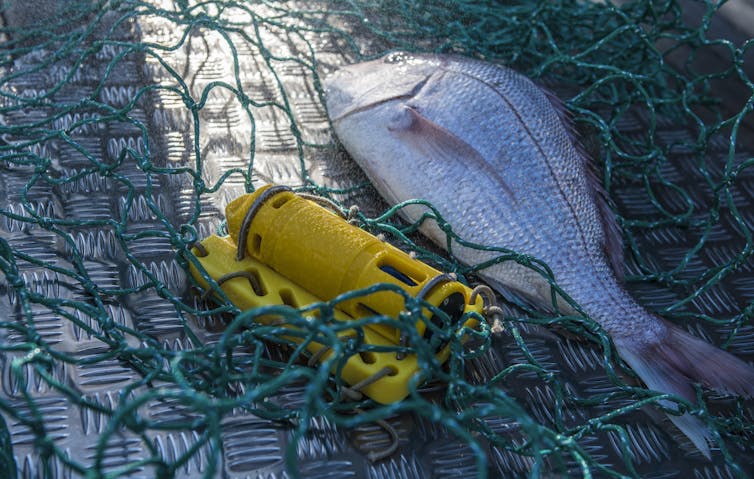
The world’s oceans are buffering us from the worst climate impacts by taking up more than 90% of the excess heat generated by greenhouse gas emissions. This has warmed them by 0.88℃ (on average globally), according to the latest climate report released this week.
The warming of the ocean affects marine ecosystems, drives changes in ocean circulation and heat distribution, and strongly influences atmospheric weather systems. All these processes are critically important to the health of our planet.
Scientists measure subsurface ocean temperature around the world, but there is a coastal gap in those measurements. This is where fishing, aquaculture, recreation and ocean managers need good data the most.
MetService’s Moana Project is changing that. We have joined forces with the commercial fishing sector to deploy sensors on vessels nationwide to gain insights into how ocean temperatures are changing near the coast.
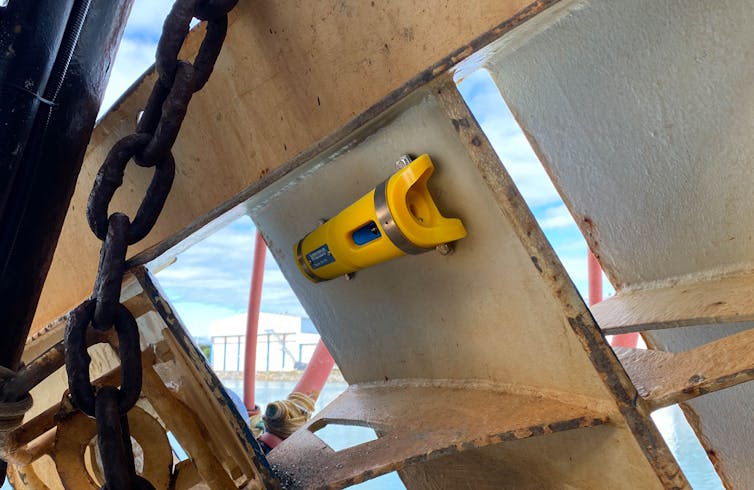
Monitoring Coastal Changes
Ocean temperature measurements are critical for understanding and accurately predicting extreme events, including severe storms and unusually warm coastal waters, which have serious economic and societal impacts.
During the past few years, Aotearoa New Zealand has been plagued by extreme rainfall and persistent marine heatwaves. This has severely affected marine life, fisheries and aquaculture.
Increased ocean temperatures can exacerbate severe weather events like Cyclone Gabrielle, contributing to the conditions for intense rainfall and potential devastation.
To prepare for a changing climate and provide early alerts for extreme events, we need to monitor temperature changes below the ocean’s surface. These measurements are usually expensive, often requiring oceanographic research vessels to deploy instruments.
Pioneering international programmes like Argo (autonomous floats that move with the world’s ocean currents collecting measurements) provide unprecedented world coverage of deeper waters.
But they are not primarily designed to measure coastal and shelf seas. The lack of coastal observations is recognised in New Zealand and globally, and is a priority for the United Nations Decade of Ocean Science 2021-2030.
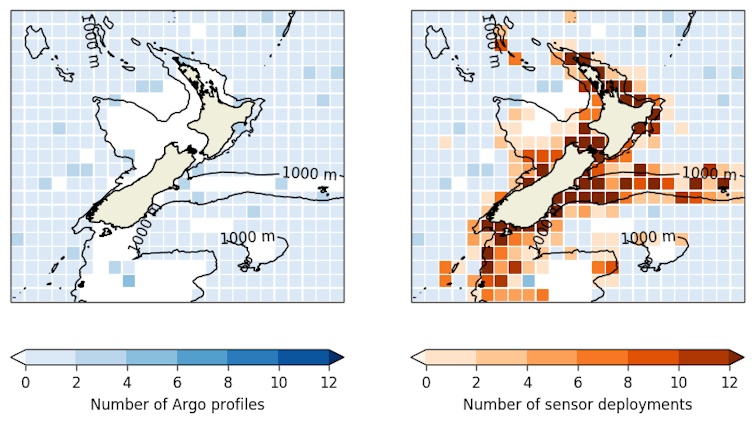
Crowd-Sourcing Ocean Observations
As part of the Moana Project, MetService and the commercial fishing industry partnered with Nelson-based company ZebraTech to develop the Mangōpare sensor, a small, lightweight, robust and accurate temperature sensor that attaches to commercial fishing gear.
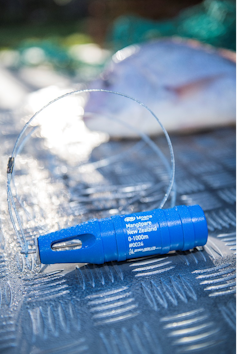
The sensor was distributed to volunteer inshore and deep-water fishing vessels and citizen scientists. Thanks to more than 200 skippers and crew, there are now 300 sensors on commercial fishing vessels, providing more than one million subsurface observations a month from across Aotearoa New Zealand.
The sensor attaches to any type of fishing gear and automatically collects ocean temperature and depth measurements through the water column. This information is automatically sent to the cloud, quality checked, returned to the fisher collecting it and incorporated into MetService ocean forecasts.
Vital Temperature Record To Improve Forecasts
Temperature observations are used to improve ocean forecasting models and verify the depth of marine heatwaves around Aotearoa New Zealand.
Similar to a weather station on land collecting real-time data that improves weather forecasts, sensor data helps improve three-dimensional predictions of ocean temperature, currents and sea level. These forecasts are used to prepare coastal communities for approaching storms, optimise fishing and alert aquaculture to extreme ocean temperatures.
Scientists use the sensor data to understand how ocean temperature affects our marine ecosystems. Recently, severe marine heatwaves have affected coastal and offshore areas leading to changes in fish distribution and impacts on sensitive species.
The sensor provides measurements exactly where fishing occurs, helping fishers make sense of changes in their catch.

Temperature measurements are an invaluable record of subsurface ocean structure, allowing scientists to determine impacts of marine heatwaves, such as the bleaching of Fjordland sponges. Increased understanding is essential to a climate-resilient future for our oceans and marine species over the coming decades.
Partnering with technology innovators, the commercial fishing sector, citizen scientists and researchers from across New Zealand, this project breaks down traditional barriers.
This approach demonstrates how we can solve critical environmental issues and provide important insight into our changing oceans. The continuation of this system will lead the way toward informing a climate-resilient blue economy and understanding the coastal ocean, providing measurements that will only become more critical in the coming years.![]()
Julie Jakoboski, Oceanographic Data Scientist, Moana Project's Te Tiro Moana Team Lead, MetService — Te Ratonga Tirorangi; João Marcos Azevedo Correia de Souza, MetOcean Solutions Science Manager of the Research and Development Team. Moana Project Science Lead, MetService — Te Ratonga Tirorangi, and Malene Felsing, Moana Project Manager, MetService — Te Ratonga Tirorangi
This article is republished from The Conversation under a Creative Commons license. Read the original article.
Why bioplastics won’t solve our plastic problems
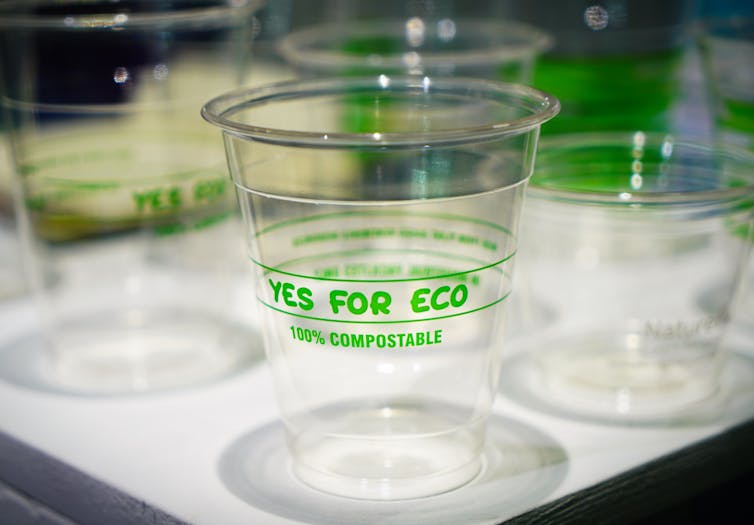
Last month, Victoria banned plastic straws, crockery and polystyrene containers, following similar bans in South Australia, Western Australia, New South Wales and the ACT. All states and territories in Australia have now banned lightweight single-use plastic bags.
You might wonder why we have to ban these products entirely. Couldn’t we just make them out of bioplastics – plastics usually made of plants? Some studies estimate we could swap up to 85% of fossil-fuel based plastics for bioplastics.
Unfortunately, bioplastics aren’t ready for prime time – except for their use in kitchen caddy bins as food waste liners. In Australia, we don’t have widely available pathways to compost or process them at the end of their lives. Nearly always, they end up in landfill.
That’s why many states are including bioplastics in their plastics bans. Avoiding single-use plastics entirely, whether traditional fossil fuel-based plastics or bioplastics, is more sustainable. And as our recycling system struggles, less plastic of any kind is simply better.

Bio-Based, Biodegradable And Compostable Are Different
Bioplastics is a blanket term covering plastics which are biologically-based or biodegradable (including compostable), or both.
Plastics are materials based on polymers – long-repeating chains of large molecules. These molecules don’t have to be oil-based - biologically-based plastics are made from raw materials such as corn, sugarcane, cellulose and algae.
Biodegradable plastics are those plastics able to be broken down by microorganisms into elements found in nature. Importantly, biodegradable here doesn’t specify how long or under what conditions plastic will break down.
Compostable plastics biodegrade on a known timeframe, when composted. In Australia, they can be certified for commercial or home compostable use.
These differences are important. Many of us would see the word “bioplastic” and assume what we’re buying is plant based and breaks down quickly. That’s often not true. Some biodegradable plastics are even made from fossil fuels.
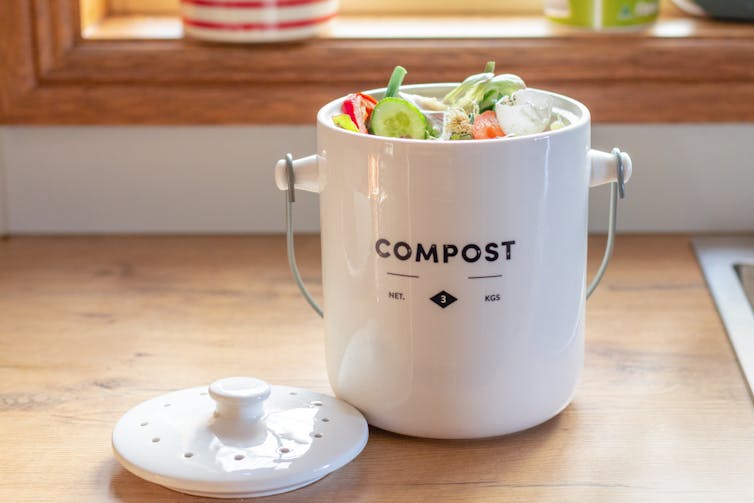
Are Bioplastics Broadly More Environmentally Friendly?
To understand this we need to look at the whole lifecycle of the plastic, how it is made, used and what happens to it at end-of-life. Manufacturing bio-based plastics generally has lower environmental impacts and has less greenhouse gas emissions than fossil fuel plastics.
This isn’t always the case. Producing plastics from plants has an environmental impact from the use of land, water and agricultural chemicals. Increased demand for agricultural land could lead to biodiversity loss and can compete with food production.
Bioplastics often sub in for familiar single use items such as plastic bags, takeaway coffee cups and cutlery. Around 90% of the bioplastics sold in Australia are certified compostable. In most of these applications a reusable alternative would be the most sustainable option.
Some applications have beneficial environmental outcomes: compostable bags for kitchen food waste caddies increase the rate of food waste collected, which means less food waste in landfill and fewer greenhouse gas emissions.
What about the crucial question of plastic waste and pollution? Sadly, if bioplastics end up in the environment, they can damage the environment in the same way as conventional plastics, such as contaminating soil and water. A turtle can choke just as easily on a bioplastic bag as a conventional plastic bag. That’s because biodegradable plastics still take years or even decades to biodegrade in nature.
Ideally, bioplastics should be designed to be either recyclable or compostable. Unfortunately, some bioplastics are neither. These pose problems for our waste management system, as they often end up contaminating recycling or compost bins when the only place for them is the tip.
In recent research for WWF Australia, we found widespread greenwashing in the industry, with terms such as “earth friendly” and “plastic-free” adding to the confusion. Regulating the industry and standardising terms would make it easier for us all to choose.
Compostable Plastics Almost All End Up In Landfill
Compostable plastics are designed to be broken down in the compost. Some can be composted at home, but others have to be done commercially.
The problem is these plastics aren’t being composted most of the time. Australian Standard compostable plastics are accepted in food organics and garden organics bins in South Australia and some councils in Hobart. But everywhere else, access to these services is limited. Many councils in other states will accept food and green waste – but specifically exclude compostable plastics (some accept council-supplied food waste caddy liners).
This means most compostable plastics used in Australia end up in landfill, where they emit methane as they break down, where it is not always captured. There’s no benefit using bioplastics if they can’t – or won’t – be recycled or composted, especially if they’re replacing a plastic that’s readily recyclable, such as the PET used in soft drink bottles.
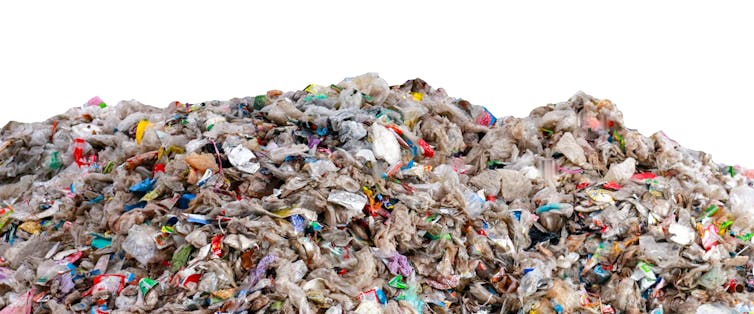
Where Does It Make Sense To Use Bioplastics In Australia?
When you reach for a bioplastic product, you’re probably doing it to reduce plastic waste. Unfortunately, we’re not there yet. We need viable pathways for recycling and composting.
So should we avoid them altogether? If you use compostable bin caddies and compost them at home or your council accepts them, that’s a useful option. But for most other uses, it’s far better to just not use plastic at all. Your reusable coffee cup and shopping bags are the best option. ![]()
Elsa Dominish, Research Principal, Institute for Sustainable Futures, University of Technology Sydney; Fiona Berry, Research Principal, Institute for Sustainable Futures, University of Technology Sydney; Nick Florin, Associate Professor and Research Director, Institute for Sustainable Futures, University of Technology Sydney, and Rupert Legg, PhD Candidate, University of Technology Sydney
This article is republished from The Conversation under a Creative Commons license. Read the original article.
Antarctic ice age survival story: life seeking ice-free refuges imitates art in Ice Age, the movie
Mark Stevens, University of Adelaide and Andrew Mackintosh, Monash UniversityAntarctica is an icy place today, but the ice extended even further during past ice ages. The question of how and where life survived on land in the icy continent, through the ages, has long puzzled biologists.
Ever since the first expeditions to Antarctica, the persistence of life in this inhospitable environment has remained a mystery. Until now.
We assembled data to test our theory of how life survived previous ice ages. We argue that life forms including invertebrates, vertebrates and plants persisted by retreating to numerous ice-free areas, called nunataks, that were not buried by advancing glaciers.
Then when Antarctica gradually warmed up again, life expanded from these nunatak refuges to repopulate larger ice-free areas. Our approach explains the uneven distribution of Antarctic terrestrial life, and identifies new research priorities to test our theory further.
The Coming Age Of Ice
For many, the term “Ice Age” conjures up memories of the animated adventures of Manny, Sid and Diego (and don’t forget that squirrel-rat, Scrat!) trying to escape the advancing ice.
There may be some truth to this story. The idea of a mammoth, sloth, sabretooth tiger (and pesky humans) migrating south for warmer climes is becoming well known in the Northern Hemisphere. And research published this month suggests early humans sat out the last ice age in the ice-free refuges of southern Europe.
But in Antarctica, land-loving life forms had nowhere to go. Or so it seemed, until now.
As scientists began to learn more about life in Antarctica, they began to consider the possibility of survival in ice-free refuges. But there was a problem. Any ice-free land in coastal regions, where life exists today, would have surely been consumed by the expanding ice. So how did life survive?
Unusual Ice-Free Refuges
Using evidence from the biology and geology of Antarctica, we describe how ice-free refuges (nunataks) could have provided respite for coastal species.
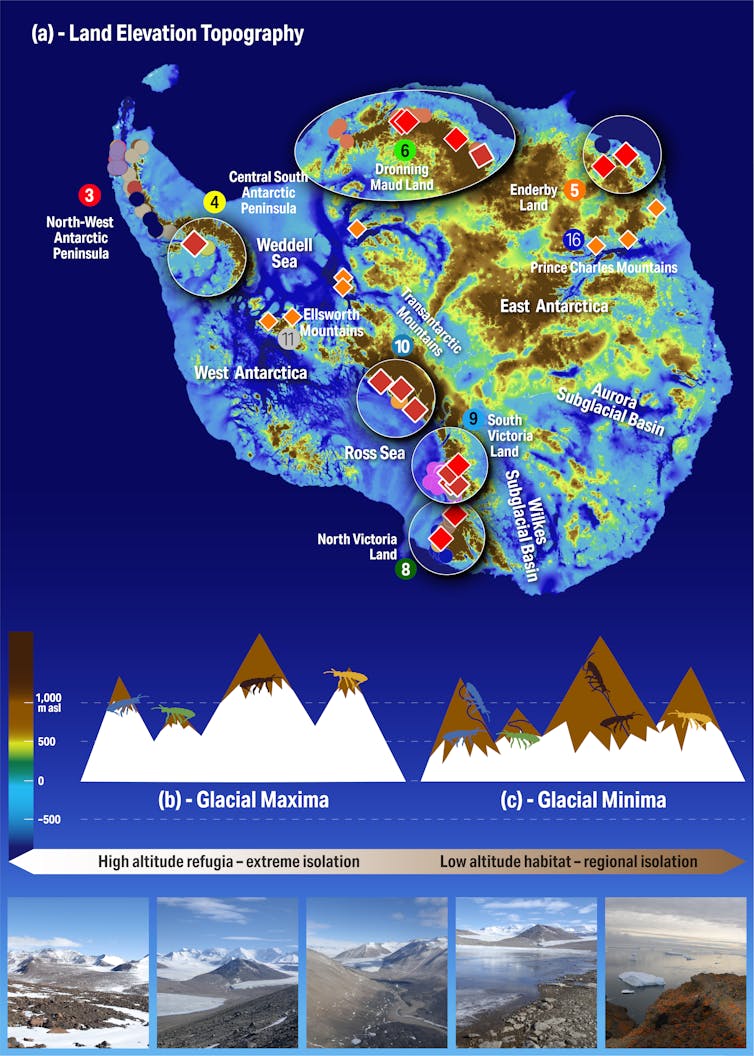
We discounted previous research suggesting geothermal sites provided sufficient ice-free refuges on the coast. That’s because these would have been short-lived - compared to an ice age lasting around 100,000 years - and too few in number to explain the survival of life on the continent today.
We provide the first testable evidence-based hypothesis for the existence of life on continental Antarctica for millions of years. And we achieved this using the most well-known of all Antarctic invertebrates, a small creature that inhabits ice-free land year-round: springtails.
Springtails are an important contributor to soil health globally. They were among the first animals collected during early expeditions to the Antarctic Peninsula and the northern coast of Victoria Land from 1897-1900.
We collated a database of distribution records for Antarctic springtails from these first discoveries more than a century ago to the present.
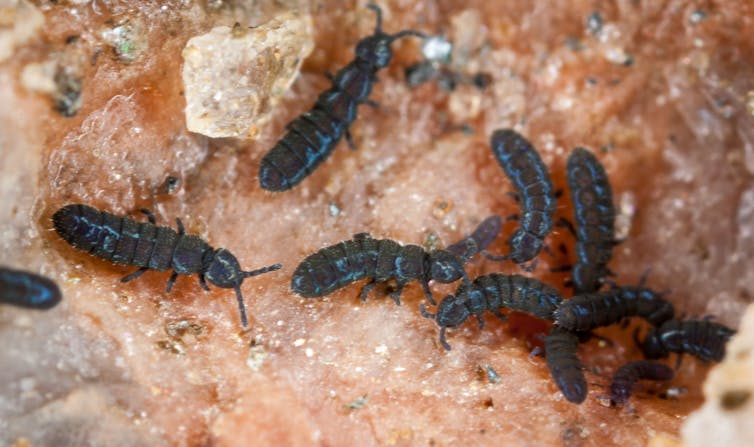
We also delved into an existing resource that has not been previously used to explore these questions of survival. By exploring the Informal Cosmogenic-nuclide Exposure-age Database (ICE-D) for Antarctica, we were able to demonstrate that ice-free conditions persisted across the last (and previous) ice ages at a large number of locations.
Cosmogenic-nuclide dating is normally used to improve the understanding of ice sheets’ response to climate change, by revealing when a rock was last covered by ice. But it had not been used to identify ice-free glacial refuges, until now.
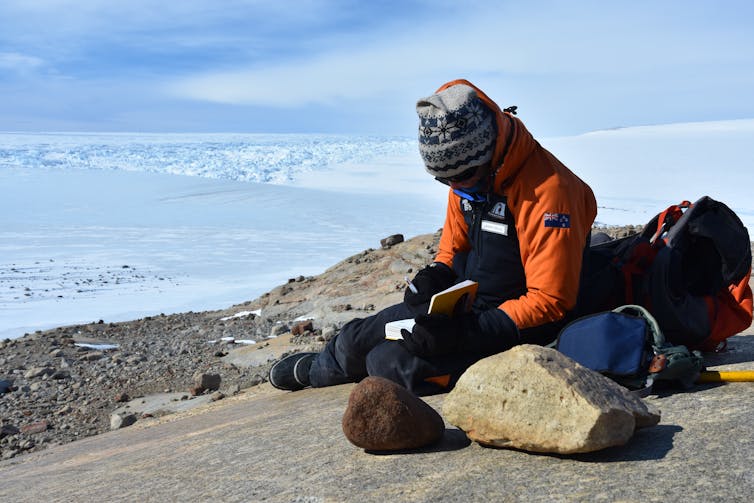
We show that some of these ice-free refuges persisted above the expanding ice during past ice ages. Some contained all species found in a region.
But how did life move from these refuges, to repopulate habitats such as coastal areas? Clues to this remarkable survival story comes from well-known alpine and polar studies, showing life present in ice-free ecosystems near glacial margins shifts as the ice expands or contracts.

Learning Life Lessons
Antarctic life faces an uncertain future as the climate changes. The region is experiencing more extreme events such as the catastrophic breakup of ice shelves, the highest observed Antarctic air temperature, and the least extensive sea ice ever recorded. It seems we are now living in the sequel “Ice Age: The Meltdown”. Let’s hope we fare as well as Manny and his friends.
Antarctica will change forever, and limiting that change will take a “mammoth” collective effort at a global scale to rapidly reduce greenhouse gas emissions. This is a daunting and unprecedented challenge, but one which is required to secure Antarctica’s future. Life endured past ice ages, but can it survive us?![]()
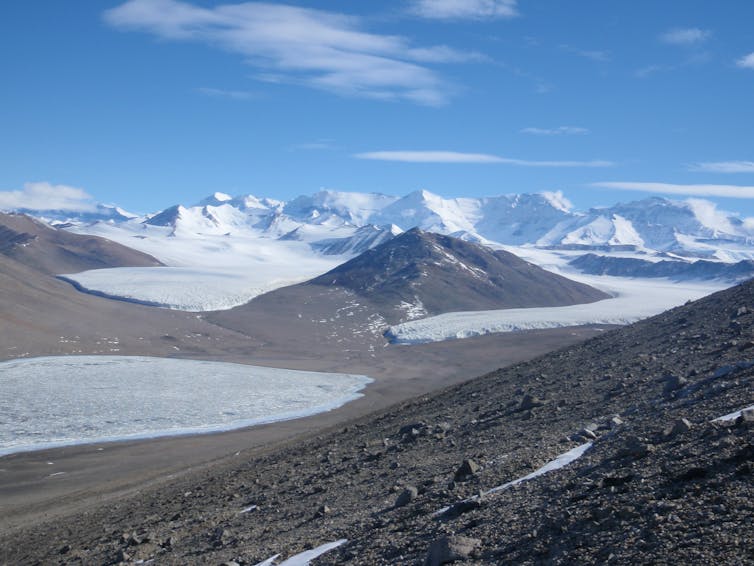
Mark Stevens, Adjunct Associate Professor, University of Adelaide and Andrew Mackintosh, Professor & Head, School of Earth Atmosphere and Environment; expert on glaciers and ice sheets, Monash University
This article is republished from The Conversation under a Creative Commons license. Read the original article.
Participation income: the social welfare model that could help communities fight climate change
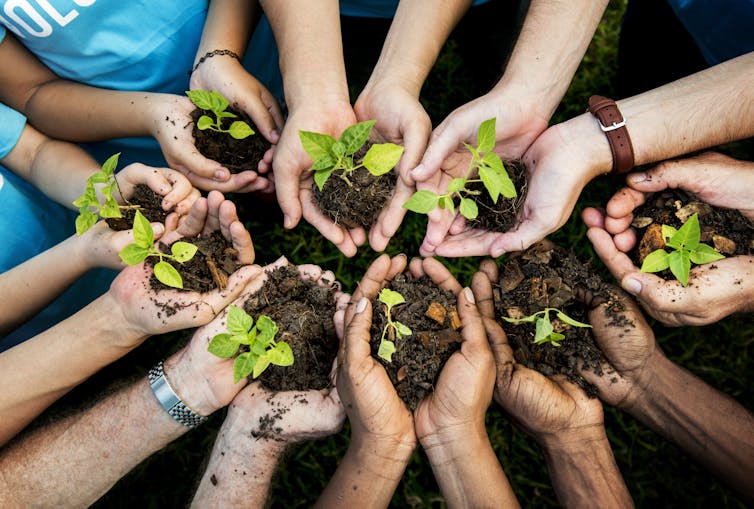
Universal Basic Income (UBI), a programme in which all adult citizens are given a regular amount of money to spend on what they choose, dominates the debate on the future of social policy. It is based on the idea that in the middle of plenty, millions of people still suffer from unemployment, underemployment, and a lack of means to have a meaningful life, and that a regular grant will provide a basic threshold to guarantee a certain quality of life.
Basic income schemes have already been piloted in Finland, Canada, Los Angeles in the US, and Wales, among others. And many countries have dealt with the social protection gap in hard times by providing temporary cash transfers with no strings attached, as happened in response to COVID-19 in Japan, South Korea and the US.
While arguments still continue over the predicted impact of new digital technologies on employment as a result of increasing automation, there is a pressing crisis that also calls for radical changes in social policy: the climate emergency.
Wellbeing Not Economic Growth
Welfare regimes all rely on the dividend of future productivity growth to underwrite increases in welfare spending. Even if economic growth could be decoupled from emissions, this is unlikely to happen fast enough to arrest global warming between 1.5 and 2°C, which scientists estimate is necessary to avert catastrophic changes.
There is fledgling research on new models of a welfare state which is not built on productivity and economic growth, but upon an architecture of sustainable wellbeing and care. UBI is the best known alternative to traditional welfare states. But it fails to meet the challenge for building a sustainable and just society.

Getting “free” money on its own won’t encourage people to use less fossil energy and do less of the things currently driving climate change. UBI schemes also consider monetary income as the route to meeting basic needs, strengthening the role of money in everyday life and leaving existing social relations untouched. Such schemes might entice politicians to cut resources from public services.
UBI does not fit well with the call for a more interventionist state to grapple with the climate emergency either. It is based on the idea of an individual right to income without recognising the value of common action or reciprocal behaviour. Claimants may withdraw from the community and never explore their full potential as community members.
Participation Income
The original participation income model (PI) was proposed by the British economist Anthony Atkinson in 1996. It is similar to UBI, but obliges people to do something in exchange for the money they receive. These activities can contribute to both the capacity of the community or the individual, like care work or attending language courses. For the most part, claimants know best what activities would be appropriate, and it would allow them to engage in a reciprocal relationship with society.
These activities could include gardening or tree planting, essentially anything that involves restoring biodiversity and bolstering natural solutions to climate change. And it can even replace or be integrated into current labour market policy measures which aim to equip unemployed persons with new skills to reenter work.
PI does have some weaknesses which need to be overcome. Atkinson envisioned nearly every person in society being eligible for the scheme, as monitoring eligibility would be difficult and incur hefty administrative costs. The PI model could be revised so that the payment reaches people on low incomes who currently rely on means-tested benefits.

Some people will also choose not to take part in participatory activities, but they must not be allowed to slip through the net. If PI was given as a “top-up” to a guaranteed minimum income, receiving PI would be seen as positive and losing it could not be regarded as a sanction.
Importantly, if the participatory activities were imposed upon people, they would remain in a subordinate position and may be stuck doing similar duties repeatedly. Allowing PI recipients to choose their activities would let them decide how to enrich their own lives and the life of their community. This model could involve community-based organisations, public providers and local residents’ networks in planning a range of development projects.
Innovative models of social security are especially important for people who may not be able to find green jobs, or households and communities with limited resources, who may not have the time or money to adopt energy-saving technologies or a climate-friendly diet.
PI is no panacea, but it could be useful for helping build a welfare state model fit for the 21st century.
This article is co-published with Nordics.info![]()
Heikki Hiilamo, Professor of Social Policy, University of Helsinki
This article is republished from The Conversation under a Creative Commons license. Read the original article.
Pittwater Reserves: Histories + Notes + Pictorial Walks
A History Of The Campaign For Preservation Of The Warriewood Escarpment by David Palmer OAM and Angus Gordon OAM
A Stroll Through Warriewood Wetlands by Joe Mills February 2023
A Walk Around The Cromer Side Of Narrabeen Lake by Joe Mills
America Bay Track Walk - photos by Joe Mills
An Aquatic June: North Narrabeen - Turimetta - Collaroy photos by Joe Mills
Angophora Reserve Angophora Reserve Flowers Grand Old Tree Of Angophora Reserve Falls Back To The Earth - History page
Annie Wyatt Reserve - A Pictorial
Avalon's Village Green: Avalon Park Becomes Dunbar Park - Some History + Toongari Reserve and Catalpa Reserve
Bairne Walking Track Ku-Ring-Gai Chase NP by Kevin Murray
Bangalley Headland Bangalley Mid Winter
Banksias of Pittwater
Barrenjoey Boathouse In Governor Phillip Park Part Of Our Community For 75 Years: Photos From The Collection Of Russell Walton, Son Of Victor Walton
Barrenjoey Headland: Spring flowers
Barrenjoey Headland after fire
Bayview Baths
Bayview Wetlands
Beeby Park
Bilgola Beach
Botham Beach by Barbara Davies
Bungan Beach Bush Care
Careel Bay Saltmarsh plants
Careel Bay Birds
Careel Bay Clean Up day
Careel Bay Playing Fields History and Current
Careel Creek
Careel Creek - If you rebuild it they will come
Centre trail in Ku-ring-gai Chase National Park
Chiltern Track- Ingleside by Marita Macrae
Clareville Beach
Clareville/Long Beach Reserve + some History
Coastal Stability Series: Cabbage Tree Bay To Barrenjoey To Observation Point by John Illingsworth, Pittwater Pathways, and Dr. Peter Mitchell OAM
Cowan Track by Kevin Murray
Curl Curl To Freshwater Walk: October 2021 by Kevin Murray and Joe Mills
Currawong and Palm Beach Views - Winter 2018
Currawong-Mackerel-The Basin A Stroll In Early November 2021 - photos by Selena Griffith
Currawong State Park Currawong Beach + Currawong Creek
Deep Creek To Warriewood Walk photos by Joe Mills
Drone Gives A New View On Coastal Stability; Bungan: Bungan Headland To Newport Beach + Bilgola: North Newport Beach To Avalon + Bangalley: Avalon Headland To Palm Beach
Duck Holes: McCarrs Creek by Joe Mills
Dunbar Park - Some History + Toongari Reserve and Catalpa Reserve
Dundundra Falls Reserve: August 2020 photos by Selena Griffith - Listed in 1935
Elsie Track, Scotland Island
Elvina Track in Late Winter 2019 by Penny Gleen
Elvina Bay Walking Track: Spring 2020 photos by Joe Mills
Elvina Bay-Lovett Bay Loop Spring 2020 by Kevin Murray and Joe Mills
Fern Creek - Ingleside Escarpment To Warriewood Walk + Some History photos by Joe Mills
Iluka Park, Woorak Park, Pittwater Park, Sand Point Reserve, Snapperman Beach Reserve - Palm Beach: Some History
Ingleside
Ingleside Wildflowers August 2013
Irrawong - Ingleside Escarpment Trail Walk Spring 2020 photos by Joe Mills
Irrawong - Mullet Creek Restoration
Katandra Bushland Sanctuary - Ingleside
Lucinda Park, Palm Beach: Some History + 2022 Pictures
McCarrs Creek
McCarr's Creek to Church Point to Bayview Waterfront Path
McKay Reserve
Mona Vale Beach - A Stroll Along, Spring 2021 by Kevin Murray
Mona Vale Headland, Basin and Beach Restoration
Mona Vale Woolworths Front Entrance Gets Garden Upgrade: A Few Notes On The Site's History
Mount Murray Anderson Walking Track by Kevin Murray and Joe Mills
Mullet Creek
Narrabeen Creek
Narrabeen Lagoon Catchment: Past Notes Present Photos by Margaret Woods
Narrabeen Lagoon State Park
Narrabeen Lagoon State Park Expansion
Narrabeen Rockshelf Aquatic Reserve
Nerang Track, Terrey Hills by Bea Pierce
Newport Bushlink - the Crown of the Hill Linked Reserves
Newport Community Garden - Woolcott Reserve
Newport to Bilgola Bushlink 'From The Crown To The Sea' Paths: Founded In 1956 - A Tip and Quarry Becomes Green Space For People and Wildlife
Pittwater Reserves: The Green Ways; Bungan Beach and Bungan Head Reserves: A Headland Garden
Pittwater Reserves, The Green Ways: Clareville Wharf and Taylor's Point Jetty
Pittwater Reserves: The Green Ways; Hordern, Wilshire Parks, McKay Reserve: From Beach to Estuary
Pittwater Reserves - The Green Ways: Mona Vale's Village Greens a Map of the Historic Crown Lands Ethos Realised in The Village, Kitchener and Beeby Parks
Pittwater Reserves: The Green Ways Bilgola Beach - The Cabbage Tree Gardens and Camping Grounds - Includes Bilgola - The Story Of A Politician, A Pilot and An Epicure by Tony Dawson and Anne Spencer
Pittwater spring: waterbirds return to Wetlands
Pittwater's Lone Rangers - 120 Years of Ku-Ring-Gai Chase and the Men of Flowers Inspired by Eccleston Du Faur
Pittwater's Parallel Estuary - The Cowan 'Creek
Resolute Track at West Head by Kevin Murray
Resolute Track Stroll by Joe Mills
Riddle Reserve, Bayview
Salvation Loop Trail, Ku-Ring-Gai Chase National Park- Spring 2020 - by Selena Griffith
Seagull Pair At Turimetta Beach: Spring Is In The Air!
Stapleton Reserve
Stapleton Park Reserve In Spring 2020: An Urban Ark Of Plants Found Nowhere Else
Stony Range Regional Botanical Garden: Some History On How A Reserve Became An Australian Plant Park
The Chiltern Track
The Resolute Beach Loop Track At West Head In Ku-Ring-Gai Chase National Park by Kevin Murray
Topham Track Ku-Ring-Gai Chase NP, August 2022 by Joe Mills and Kevin Murray
Towlers Bay Walking Track by Joe Mills
Trafalgar Square, Newport: A 'Commons' Park Dedicated By Private Landholders - The Green Heart Of This Community
Tranquil Turimetta Beach, April 2022 by Joe Mills
Turimetta Beach Reserve by Joe Mills, Bea Pierce and Lesley
Turimetta Beach Reserve: Old & New Images (by Kevin Murray) + Some History
Turimetta Headland
Warriewood Wetlands - Creeks Deteriorating: How To Report Construction Site Breaches, Weed Infestations + The Long Campaign To Save The Warriewood Wetlands & Ingleside Escarpment March 2023
Warriewood Wetlands and Irrawong Reserve
Whale Beach Ocean Reserve: 'The Strand' - Some History On Another Great Protected Pittwater Reserve
Wilshire Park Palm Beach: Some History + Photos From May 2022
Winji Jimmi - Water Maze

Pittwater's Birds
Australian Predators of the Sky by Penny Olsen - published by National Library of Australia
Australian Raven Australian Wood Duck Family at Newport
A Week In Pittwater Issue 128 A Week In Pittwater - June 2014 Issue 168
Baby Birds Spring 2015 - Rainbow Lorikeets in our Yard - for Children Baby Birds by Lynleigh Greig, Southern Cross Wildlife Care - what do if being chased by a nesting magpie or if you find a baby bird on the ground
Baby Kookaburras in our Backyard: Aussie Bird Count 2016 - October
Balloons Are The Number 1 Marine Debris Risk Of Mortality For Our Seabirds - Feb 2019 Study
Bangalley Mid-Winter Barrenjoey Birds Bird Antics This Week: December 2016
Bird of the Month February 2019 by Michael Mannington
Birdland Above the Estuary - October 2012 Birds At Our Window Birds at our Window - Winter 2014 Birdland June 2016
Birdsong Is a Lovesong at This time of The Year - Brown Falcon, Little Wattle Bird, Australian Pied cormorant, Mangrove or Striated Heron, Great Egret, Grey Butcherbird, White-faced Heron
Bird Songs – poems about our birds by youngsters from yesterdays - for children Bird Week 2015: 19-25 October
Bird Songs For Spring 2016 For Children by Joanne Seve
Birds at Careel Creek this Week - November 2017: includes Bird Count 2017 for Local Birds - BirdLife Australia by postcode
Black Cockatoo photographed in the Narrabeen Catchment Reserves this week by Margaret G Woods - July 2019
Black-Necked Stork, Mycteria Australis, Now Endangered In NSW, Once Visited Pittwater: Breeding Pair shot in 1855
Black Swans on Narrabeen Lagoon - April 2013 Black Swans Pictorial
Endangered Little Tern Fishing at Mona Vale Beach
‘Feather Map of Australia’: Citizen scientists can support the future of Australia's wetland birds: for Birdwatchers, school students and everyone who loves our estuarine and lagoon and wetland birds
Fledgling Common Koel Adopted by Red Wattlebird -Summer Bird fest 2013 Flegdlings of Summer - January 2012
Flocks of Colour by Penny Olsen - beautiful new Bird Book Celebrates the 'Land of the Parrots'
Friendly Goose at Palm Beach Wharf - Pittwater's Own Mother Goose
Front Page Issue 177 Front Page Issue 185 Front Page Issue 193 - Discarded Fishing Tackle killing shorebirds Front Page Issue 203 - Juvenile Brush Turkey Front Page Issue 208 - Lyrebird by Marita Macrae Front Page Issue 219 Superb Fairy Wren Female Front Page Issue 234: National Bird Week October 19-25 and the 2015 the Aussie Back Yard Bird Count: Australia's First Bird Counts - a 115 Year Legacy - with a small insight into our first zoos Front Page Issue 236: Bird Week 2015 Front Page Issue 244: watebirds Front Page Issue 260: White-face Heron at Careel Creek Front Page Issue 283: Pittwater + more birds for Bird Week/Aussie Bird Count Front Page Issue 284: Pittwater + more birds for Bird Week/Aussie Bird Count Front Page Issue 285: Bird Week 2016 Front Page Issue 331: Spring Visitor Birds Return
G . E. Archer Russell (1881-1960) and His Passion For Avifauna From Narrabeen To Newport
Glossy Black-Cockatoo Returns To Pittwater by Paul Wheeler Glossy Cockatoos - 6 spotted at Careel Bay February 2018
Grey Butcher Birds of Pittwater
INGLESIDE LAND RELEASE ON AGAIN BUT MANY CHALLENGES AHEAD by David Palmer
Issue 60 May 2012 Birdland - Smiles- Beamings -Early -Winter - Blooms
Jayden Walsh’s Northern Beaches Big Year - courtesy Pittwater Natural Heritage Association
John Gould's Extinct and Endangered Mammals of Australia by Dr. Fred Ford - Between 1850 and 1950 as many mammals disappeared from the Australian continent as had disappeared from the rest of the world between 1600 and 2000! Zoologist Fred Ford provides fascinating, and often poignant, stories of European attitudes and behaviour towards Australia's native fauna and connects these to the animal's fate today in this beautiful new book - our interview with the author
July 2012 Pittwater Environment Snippets; Birds, Sea and Flowerings
Juvenile Sea Eagle at Church Point - for children
King Parrots in Our Front Yard
Kookaburra Turf Kookaburra Fledglings Summer 2013 Kookaburra Nesting Season by Ray Chappelow Kookaburra Nest – Babies at 1.5 and 2.5 weeks old by Ray Chappelow Kookaburra Nest – Babies at 3 and 4 weeks old by Ray Chappelow Kookaburra Nest – Babies at 5 weeks old by Ray Chappelow Kookaburra and Pittwater Fledglings February 2020 to April 2020
Lion Island's Little Penguins (Fairy Penguins) Get Fireproof Homes - thanks to NSW National Parks and Wildlife Service and the Fix it Sisters Shed
Lyre Bird Sings in Local National Park - Flock of Black Cockatoos spotted - June 2019
Magpie's Melodic Melodies - For Children (includes 'The Magpie's Song' by F S Williamson)
Masked Lapwing (Plover) - Reflected
May 2012 Birdland Smiles Beamings Early Winter Blooms
Musk Lorikeets In Pittwater: Pittwater Spotted Gum Flower Feast - May 2020
Nankeen Kestrel Feasting at Newport: May 2016
National Bird Week 2014 - Get Involved in the Aussie Backyard Bird Count: National Bird Week 2014 will take place between Monday 20 October and Sunday 26 October, 2014. BirdLife Australia and the Birds in Backyards team have come together to launch this year’s national Bird Week event the Aussie Backyard Bird Count! This is one the whole family can do together and become citizen scientists...
National Bird Week October 19-25 and the 2015 the Aussie Back Yard Bird Count: Australia's First Bird Counts - a 115 Year Legacy - with a small insight into our first zoos
Nature 2015 Review Earth Air Water Stone
New Family of Barking Owls Seen in Bayview - Church Point by Pittwater Council
Noisy Visitors by Marita Macrae of PNHA
Odes to Australia's Fairy-wrens by Douglas Brooke Wheelton Sladen and Constance Le Plastrier 1884 and 1926
Oystercatcher and Dollarbird Families - Summer visitors
Painted Button-Quail Rescued By Locals - Elanora-Ingleside escarpment-Warriewood wetlands birds
Palm Beach Protection Group Launch, Supporters Invited: Saturday Feb.16th - Residents Are Saying 'NO' To Off-Leash Dogs In Station Beach Eco-System - reports over 50 dogs a day on Station Beach throughout December-January (a No Dogs Beach) small children being jumped on, Native birds chased, dog faeces being left, families with toddlers leaving beach to get away from uncontrolled dogs and 'Failure of Process' in council 'consultation' open to February 28th
Pardalote, Scrub Wren and a Thornbill of Pittwater
Pecking Order by Robyn McWilliam
Pelican Lamps at Narrabeen Pelican Dreamsong - A Legend of the Great Flood - dreamtime legend for children
Pittwater Becalmed Pittwater Birds in Careel Creek Spring 2018 Pittwater Waterbirds Spring 2011 Pittwater Waterbirds - A Celebration for World Oceans Day 2015
Pittwater's Mother Nature for Mother's Day 2019
Plastic in 99 percent of seabirds by 2050 by CSIRO
Plover Appreciation Day September 16th 2015
Powerful and Precious by Lynleigh Grieg
Red Wattlebird Song - November 2012
Restoring The Diamond: every single drop. A Reason to Keep Dogs and Cats in at Night.
Sea Birds off the Pittwater Coast: Albatross, Gannet, Skau + Australian Poets 1849, 1898 and 1930, 1932
Sea Eagle Juvenile at Church Point
Seen but Not Heard: Lilian Medland's Birds - Christobel Mattingley - one of Australia's premier Ornithological illustrators was a Queenscliff lady - 53 of her previously unpublished works have now been made available through the auspices of the National Library of Australia in a beautiful new book
7 Little Ducklings: Just Keep Paddling - Australian Wood Duck family take over local pool by Peta Wise
Shag on a North Avalon Rock - Seabirds for World Oceans Day 2012
Short-tailed Shearwaters Spring Migration 2013
South-West North-East Issue 176 Pictorial
Spring 2012 - Birds are Splashing - Bees are Buzzing
Spring Becomes Summer 2014- Royal Spoonbill Pair at Careel Creek
Spring Notes 2018 - Royal Spoonbill in Careel Creek
Station Beach Off Leash Dog Area Proposal Ignores Current Uses Of Area, Environment, Long-Term Fauna Residents, Lack Of Safe Parking and Clearly Stated Intentions Of Proponents have your say until February 28, 2019
Summer 2013 BirdFest - Brown Thornbill Summer 2013 BirdFest- Canoodlers and getting Wet to Cool off Summer 2013 Bird Fest - Little Black Cormorant Summer 2013 BirdFest - Magpie Lark
New Shorebirds WingThing For Youngsters Available To Download
A Shorebirds WingThing educational brochure for kids (A5) helps children learn about shorebirds, their life and journey. The 2021 revised brochure version was published in February 2021 and is available now. You can download a file copy here.
If you would like a free print copy of this brochure, please send a self-addressed envelope with A$1.10 postage (or larger if you would like it unfolded) affixed to: BirdLife Australia, Shorebird WingThing Request, 2-05Shorebird WingThing/60 Leicester St, Carlton VIC 3053.

 Shorebird Identification Booklet
Shorebird Identification Booklet
The Migratory Shorebird Program has just released the third edition of its hugely popular Shorebird Identification Booklet. The team has thoroughly revised and updated this pocket-sized companion for all shorebird counters and interested birders, with lots of useful information on our most common shorebirds, key identification features, sighting distribution maps and short articles on some of BirdLife’s shorebird activities.
The booklet can be downloaded here in PDF file format: http://www.birdlife.org.au/documents/Shorebird_ID_Booklet_V3.pdf
Paper copies can be ordered as well, see http://www.birdlife.org.au/projects/shorebirds-2020/counter-resources for details.
Download BirdLife Australia's children’s education kit to help them learn more about our wading birdlife
Shorebirds are a group of wading birds that can be found feeding on swamps, tidal mudflats, estuaries, beaches and open country. For many people, shorebirds are just those brown birds feeding a long way out on the mud but they are actually a remarkably diverse collection of birds including stilts, sandpipers, snipe, curlews, godwits, plovers and oystercatchers. Each species is superbly adapted to suit its preferred habitat. The Red-necked Stint is as small as a sparrow, with relatively short legs and bill that it pecks food from the surface of the mud with, whereas the Eastern Curlew is over two feet long with a exceptionally long legs and a massively curved beak that it thrusts deep down into the mud to pull out crabs, worms and other creatures hidden below the surface.
Some shorebirds are fairly drab in plumage, especially when they are visiting Australia in their non-breeding season, but when they migrate to their Arctic nesting grounds, they develop a vibrant flush of bright colours to attract a mate. We have 37 types of shorebirds that annually migrate to Australia on some of the most lengthy and arduous journeys in the animal kingdom, but there are also 18 shorebirds that call Australia home all year round.
What all our shorebirds have in common—be they large or small, seasoned traveller or homebody, brightly coloured or in muted tones—is that each species needs adequate safe areas where they can successfully feed and breed.
The National Shorebird Monitoring Program is managed and supported by BirdLife Australia.
This project is supported by Glenelg Hopkins Catchment Management Authority and Hunter Local Land Services through funding from the Australian Government’s National Landcare Program. Funding from Helen Macpherson Smith Trust and Port Phillip Bay Fund is acknowledged.
The National Shorebird Monitoring Program is made possible with the help of over 1,600 volunteers working in coastal and inland habitats all over Australia.
The National Shorebird Monitoring program (started as the Shorebirds 2020 project initiated to re-invigorate monitoring around Australia) is raising awareness of how incredible shorebirds are, and actively engaging the community to participate in gathering information needed to conserve shorebirds.
In the short term, the destruction of tidal ecosystems will need to be stopped, and our program is designed to strengthen the case for protecting these important habitats.
In the long term, there will be a need to mitigate against the likely effects of climate change on a species that travels across the entire range of latitudes where impacts are likely.
The identification and protection of critical areas for shorebirds will need to continue in order to guard against the potential threats associated with habitats in close proximity to nearly half the human population.
Here in Australia, the place where these birds grow up and spend most of their lives, continued monitoring is necessary to inform the best management practice to maintain shorebird populations.
BirdLife Australia believe that we can help secure a brighter future for these remarkable birds by educating stakeholders, gathering information on how and why shorebird populations are changing, and working to grow the community of people who care about shorebirds.
To find out more visit: http://www.birdlife.org.au/projects/shorebirds-2020/shorebirds-2020-program
Aussie Bread Tags Collection Points

Common Crow Butterfly Euploea Core
You may be seeing a few of these butterflies around our area at the moment, the Common Crow Butterfly Euploea core.
It belongs to the crows and tigers subfamily Danainae (tribe Danaini). E. core is a glossy-black, medium-sized 85–95 mm (3.3–3.7 in) butterfly with rows of white spots on the margins of its wings. E. core is a slow, steady flier. Due to its unpalatability it is usually observed gliding through the air with a minimum of effort. As caterpillars, this species sequesters toxins from its food plant which are passed on from larva to pupa to the adult. While feeding, it is a very bold butterfly, taking a long time at each bunch of flowers. It can also be found mud-puddling with others of its species and often in mixed groups. The males of this species visit plants like Crotalaria and Heliotropium to replenish pheromone stocks which are used to attract a female during courtship.
It is found in southern Pakistan, Sri Lanka, India, Bangladesh, Myanmar, Russia, and Australia. In its range E. core is found at all elevations, right from sea level up into the mountains to 2,400 metres (8,000 ft). It can be observed in all layers of vegetation and in all types of regions from arid land to forested areas. It can as commonly be seen gliding over the treetops as flitting about a foot off the ground searching for nectar flowers. In thick forests it is often seen moving along open tracks or following the course of a river.
.jpg?timestamp=1679546453166)
Photo taken in Careel Bay, March 2023. Pic; AJG
The butterfly, being protected by its inedibility, has a leisurely flight. It is often seen flying about shrubs and bushes in search of its host plants. It visits a large variety of flowering plant species. When gliding E. core holds its wings at an angle just greater than the horizontal plane, maintaining its flight with a few measured wingbeats.
E. core is a nectar lover and visits flowers unhurriedly. It seems to prefer bunches to individual flowers. When feeding the butterfly is unhurried and is not easily disturbed. It can be approached closely at this time. On hot days large numbers of these butterflies can be seen mud-puddling on wet sand. E. core is an avid mud-puddler often congregating in huge swarms along with other Euploea species as well as other danaids.
Eggs are laid on the underside of young leaves of the host plants. The egg is shiny white, tall and pointed, with ribbed sides. Just before hatching the eggs turn greyish with a black top. Throughout its life the caterpillar stays on the underside of the leaves. The caterpillar is uniformly cylindrical, vividly coloured and smooth. It has alternate white and dark brown or black transverse bands. Just above the legs and prolegs, along the entire body is a wide orangish-red band interspersed with black spiracles.
The adult butterfly has a life span of 11 - 13 weeks. The adults feed upon nectar from various flowering plants, including eucalypts.
Warringah Zone School Surfing
Congratulations Sateki Latu: Waratahs Cap
TEXStyle 2023


The 2023 TEA Textile Art Piece (TAP) Challenge
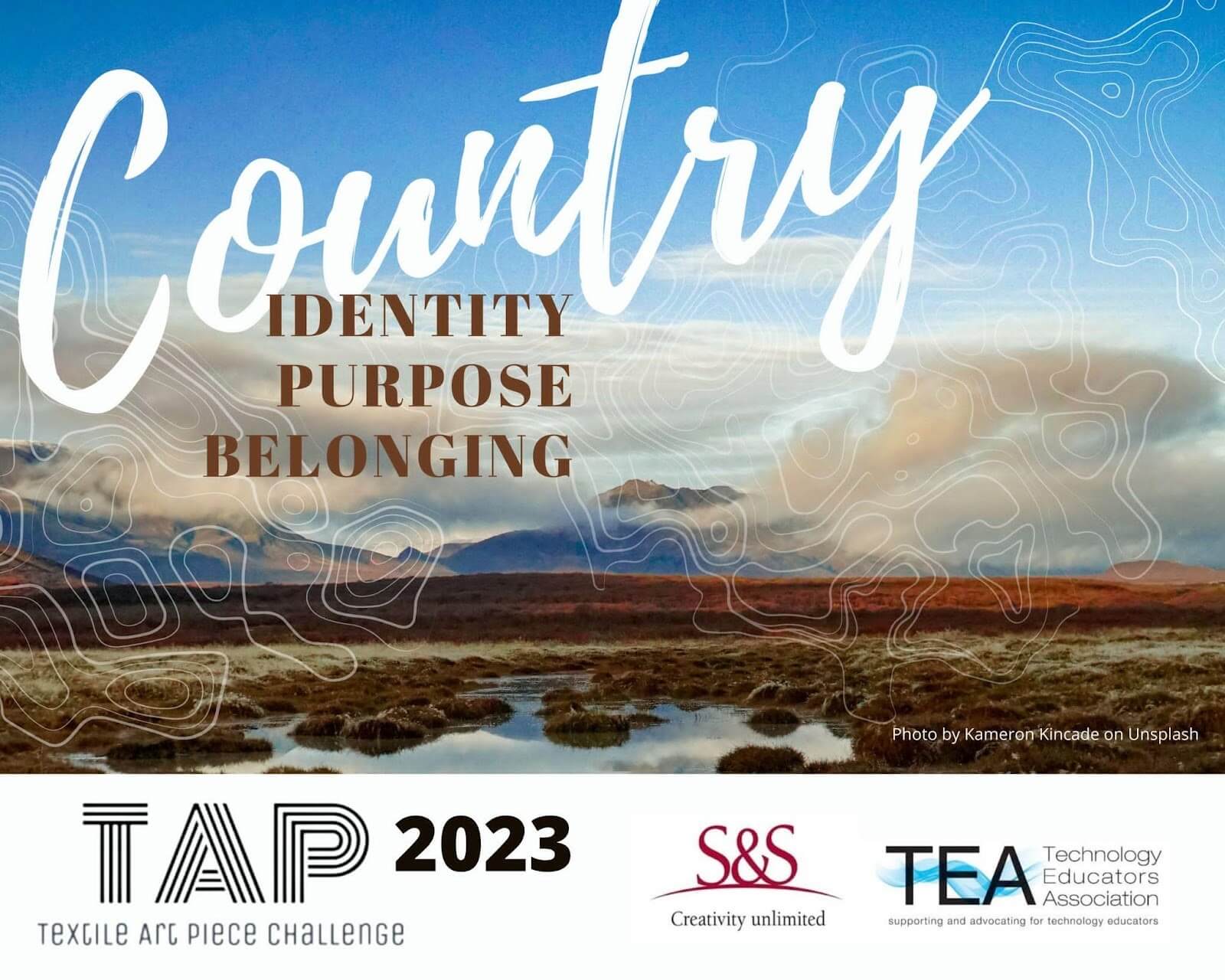
Major Upgrade Of Athlete Change Rooms Ahead Of FIFA Women's World Cup 2023™

Avalon Youth Hub In Avalon Beach: Join Us!

A History Of Pittwater Part 4: West Head - West Head Fortress Remastered 2023
Published March 2023 by Pittwater Pathways, John Illingsworth
This 2023 version updated to include the flight of David Geer's Sea Rey light seaplane. Essential to the production it has become part of it. Definition and video stability is further improved.
The story of the WWII fortress at West Head up to March 1941, including the installation of the guns as told by the man who was there - Jack 'Bluey' Mercer. The history of Commodore Heights, attempts by speculators to subdivide Ku-ring-gai Chase and the building of the Hawkesbury River railway bridge. An over-arching strategic theme from 1882 onwards reveals how the defence of Pittwater, Broken Bay and the Hawkesbury River railway bridge was essential to the war effort and the defence of Sydney.
Scouts Are Out & About
Over the past few months, all age groups in Scouting across Sydney North Region have been doing everything from canoe trips, hikes, and abseiling, to craft and community cleanups.
There's no better time to get into Scouting, with sections for ages 5-25, plus lots of satisfying leadership opportunities for adults.
Young people can have a four-week trial period, and Active Kids vouchers can be used towards membership fees.
Scouts are everywhere! Connect with your local Scout Group via sydneynorthscouts.com
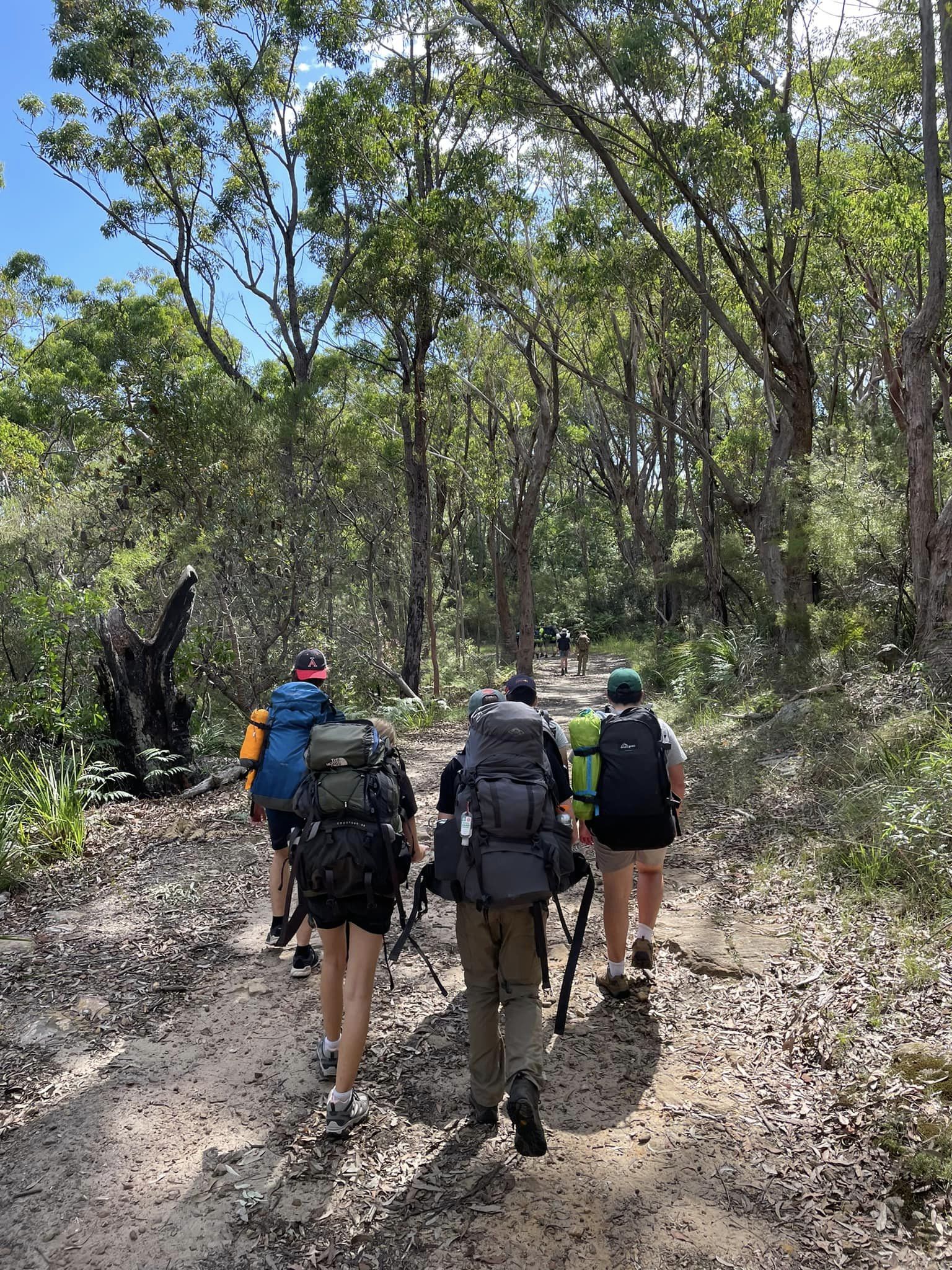
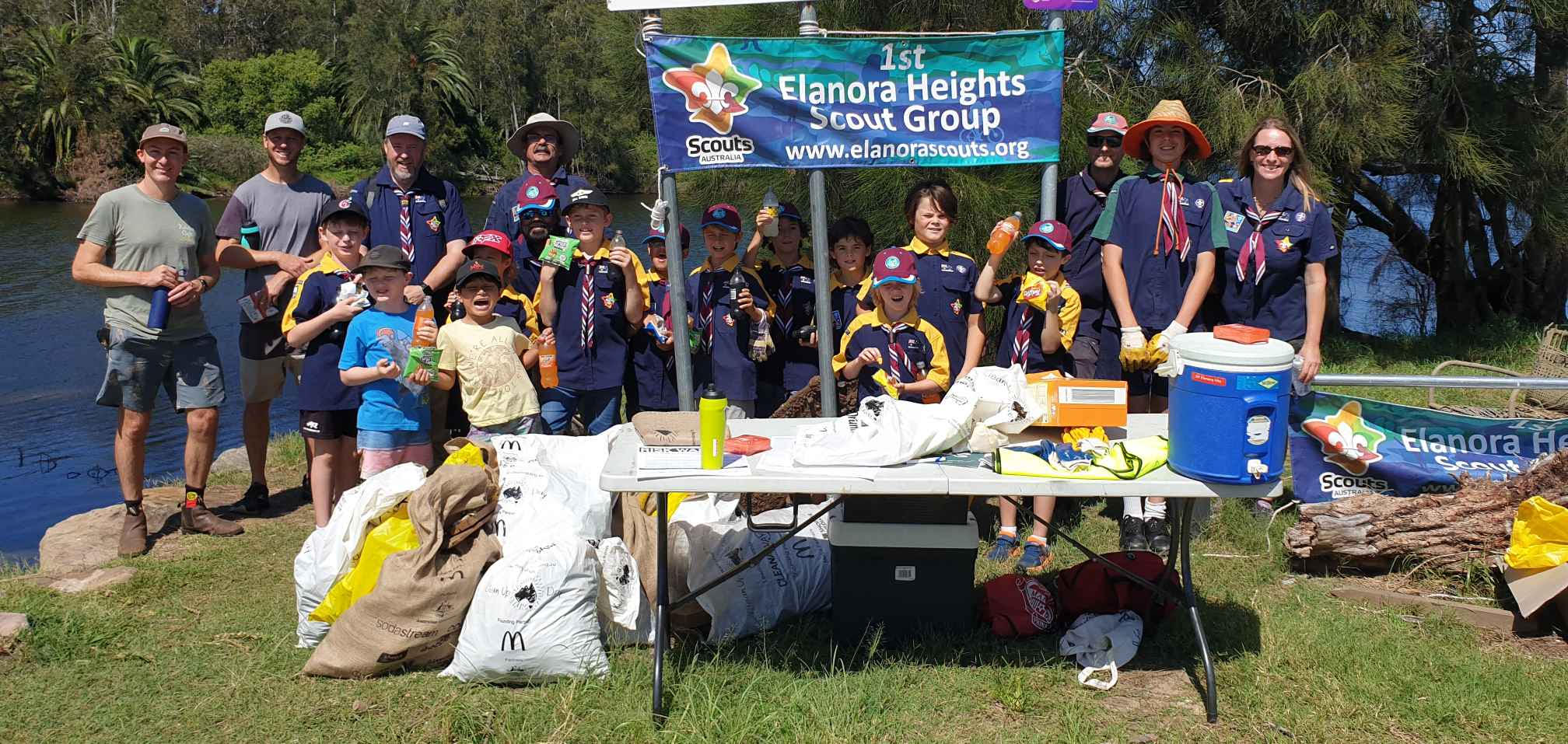
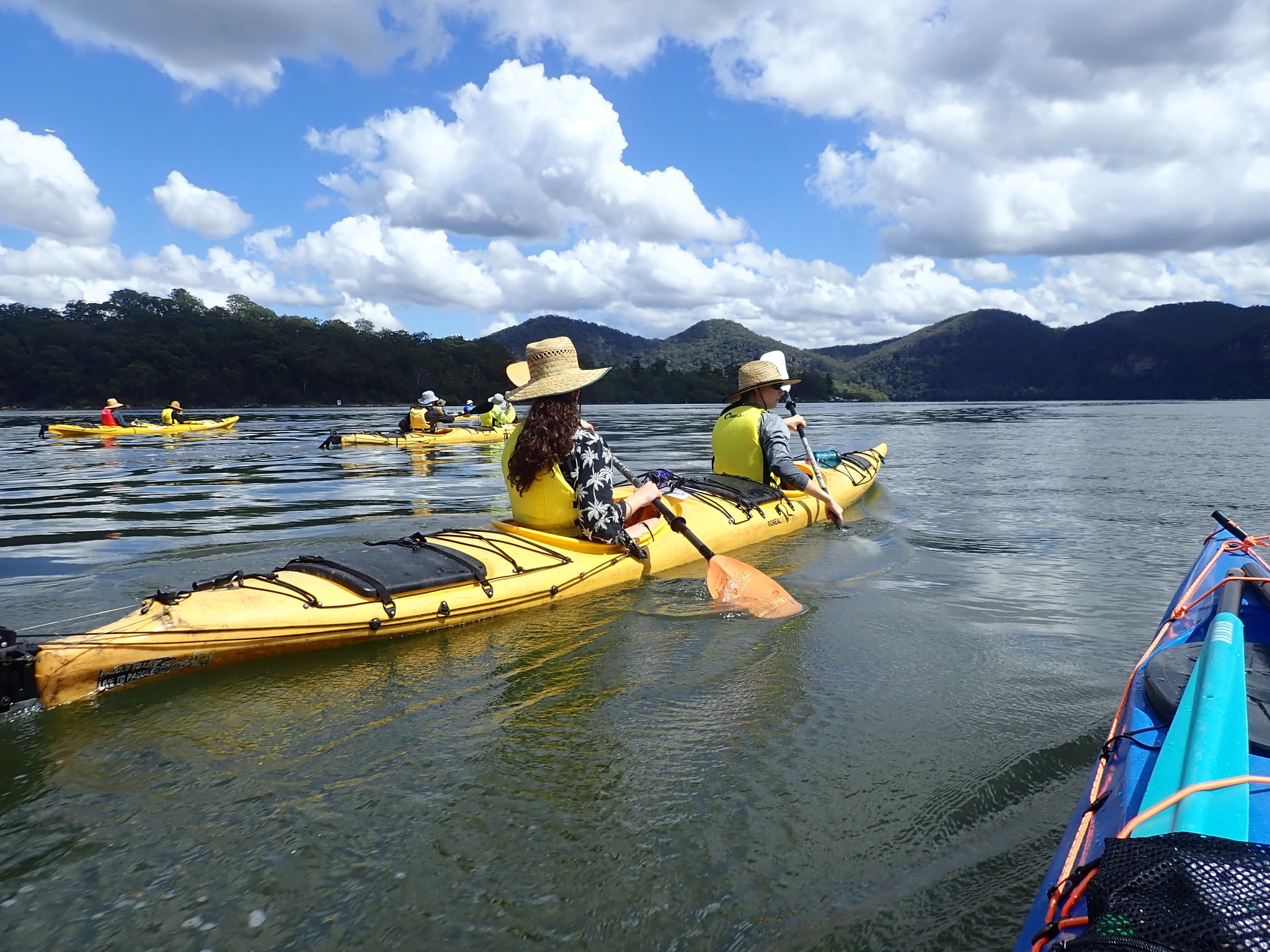
Northern Composure Band Competition 2023
Due to the pandemic, Council have had the 20th anniversary on hold but pleased to say that the competition is open and running again.
Northern Composure is the largest and longest-running youth band competition in the area and offers musicians local exposure as well as invaluable stage experience. Bands compete in heats, semi finals and the grand final for a total prize pool of over $15,000.
Over the past 20 years we have had many success stories and now is your chance to join bands such as:
- Ocean Alley
- Lime Cordiale
- Dear Seattle
- What So Not
- The Rions
- Winston Surfshirt
- Crocodylus
And even a Triple J announcer plus a wide range of industry professionals
About the Competition
In 2023, the comp looks a little different.
All bands are invited to enter our heats which will be exclusively run online and voted on by your peers and community by registering below and uploading a video of one song of your choice. (if you are doing a cover, please make sure to credit the original band) We are counting on you to spread the word and get your friends, family, teachers voting for you!
The top 8-12 bands will move on through to our live semi finals with a winner from each moving on to the grand final held during National Youth Week. Not only that but we have raised the age range from 19 to 21 for all those musicians who may have missed out over the past two years.
Key dates
- Voting open for heats: Mon 13 Feb – Sun 26 Feb
- Band Briefing: Mon 6 March, Dee Why PCYC
- Semi 1: Sat 18 March Mona Vale Memorial Hall
- Semi 2: Sat 25 March, YOYOs, Frenchs Forest
- Grand Final: Fri 28 April, Dee Why PCYC
For more information contact Youth Development at youth@northernbeaches.nsw.gov.au or call 8495 5104
Stay in the loop and follow Northern Composure Unplugged on KALOF Facebook.
School Leavers Support
- Download or explore the SLIK here to help guide Your Career.
- School Leavers Information Kit (PDF 5.2MB).
- School Leavers Information Kit (DOCX 0.9MB).
- The SLIK has also been translated into additional languages.
- Download our information booklets if you are rural, regional and remote, Aboriginal or Torres Strait Islander, or living with disability.
- Support for Regional, Rural and Remote School Leavers (PDF 2MB).
- Support for Regional, Rural and Remote School Leavers (DOCX 0.9MB).
- Support for Aboriginal and/or Torres Strait Islander School Leavers (PDF 2MB).
- Support for Aboriginal and/or Torres Strait Islander School Leavers (DOCX 1.1MB).
- Support for School Leavers with Disability (PDF 2MB).
- Support for School Leavers with Disability (DOCX 0.9MB).
- Download the Parents and Guardian’s Guide for School Leavers, which summarises the resources and information available to help you explore all the education, training, and work options available to your young person.
School Leavers Information Service
- navigate the School Leavers Information Kit (SLIK),
- access and use the Your Career website and tools; and
- find relevant support services if needed.
Word Of The Week: Textile
noun. any cloth or goods produced by weaving, knitting, or felting. a material, as a fibre or yarn, used in or suitable for weaving: Glass can be used as a textile. adjective. woven or capable of being woven: textile fabrics.
The word 'textile' comes from the Latin adjective textilis, meaning 'woven', which itself stems from textus, the past participle of the verb texere, 'to weave'. Originally applied to woven fabrics, the term "textiles" is now used to encompass a diverse range of materials, including fibres, yarns, and fabrics, as well as other related items.
A "fabric" is defined as any thin, flexible material made from yarn, directly from fibres, polymeric film, foam, or any combination of these techniques. Fabric has a broader application than cloth. Fabric is synonymous with cloth, material, goods, or piece goods.
The word 'fabric' also derives from Latin, with roots in the Proto-Indo-European language. Stemming most recently from the Middle French fabrique, or "building," and earlier from the Latin fabrica ('workshop; an art, trade; a skilful production, structure, fabric'), the noun fabrica stems from the Latin faber; " artisan who works in hard materials', which itself is derived from the Proto-Indo-European dhabh-, meaning 'to fit together'.
Cloth is a flexible substance typically created through the processes of weaving, felting, or knitting using natural or synthetic materials. The word 'cloth' derives from the Old English clað, meaning "a cloth, woven, or felted material to wrap around one's body', from the Proto-Germanic kalithaz, similar to the Old Frisian klath, the Middle Dutch cleet, the Middle High German kleit and the German kleid, all meaning 'garment'.
It is worth noting that although cloth is a type of fabric, not all fabrics can be classified as cloth due to differences in their manufacturing processes, physical properties, and intended uses. Materials that are woven, knitted, tufted, or knotted from yarns are referred to as cloth, while wallpaper, plastic upholstery products, carpets, and nonwoven materials are examples of fabrics.
The textile industry grew out of art and craft and was kept going by guilds, an association of artisans and merchants who oversee the practice of their craft/trade in a particular territory.
_van_het_Amsterdamse_lakenbereidersgilde_-_Google_Art_Project.jpg?timestamp=1679618704185)
The Syndics of the Drapers' Guild by Rembrandt, 1662.
The men (with the exception of Bel who is an attendant as indicated by his calotte) are drapers who were elected to assess the quality of cloth that weavers offered for sale to members of their guild. Their one-year terms in office began on Good Friday and they were expected to conduct their inspections thrice weekly. The Dutch word staal means 'sample' and refers to the samples of cloth that were assessed. The inspectors used pliers to press the seals of their city (front) and guild (reverse) into penny-sized slugs of lead that were specially affixed to record the results of the inspection. There were four grades of quality, the highest was indicated by pressing four seals and the lowest by pressing only one.
The men, who are appraising a length of Persian-style fabric against exemplars from a swatch book, are (from left to right): Jacob van Loon (1595–1674), Volckert Jansz (1605 or 1610–1681), Willem van Doeyenburg (ca. 1616–1687), Frans Hendricksz Bel (1629–1701), Aernout van der Mye (ca.1625–1681), Jochem de Neve (1629–1681). The guild commissioned this portrait and it hung in their guildhall, the Staalhof (nl), until 1771.
In the 18th and 19th centuries, during the industrial revolution, textiles manufacture became increasingly mechanised. In 1765, when a machine for spinning wool or cotton called the spinning jenny was invented in the United Kingdom, textile production became the first economic activity to be industrialised. There are numerous accounts and stories you may read of the impact of that on individuals and communities.
The precursor of today's textiles includes leaves, barks, fur pelts, and felted cloths. The first clothes, worn at least 70,000 years ago and perhaps much earlier, were probably made of animal skins and helped protect early humans from the elements. At some point, people learned to weave plant fibres into textiles. The discovery of dyed flax fibres in a cave in the Republic of Georgia dated to 34,000 BCE suggests that textile-like materials were made as early as the Palaeolithic era.
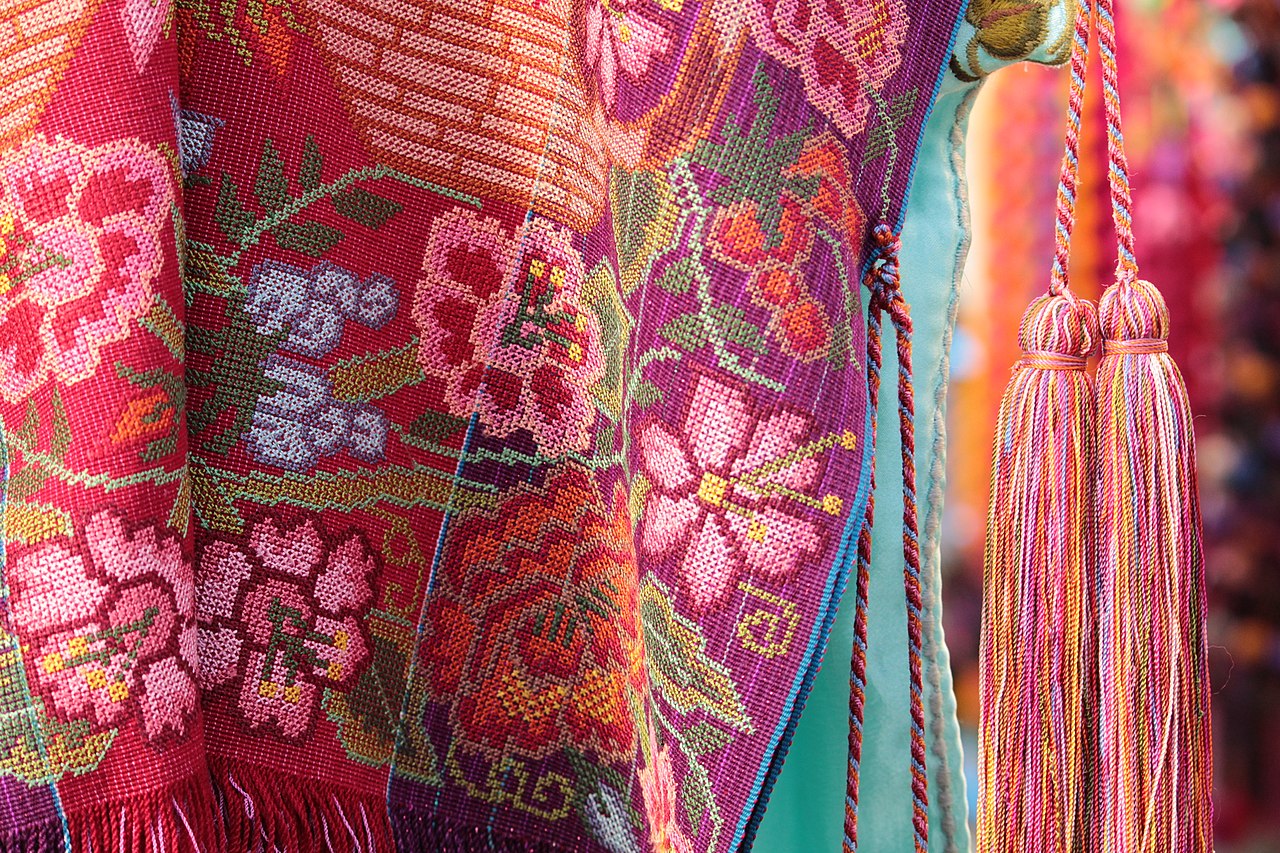
Handmade floral patterns on textiles, The production of textiles which were initially artisanal work, has grown into a vast field today that includes the production of fibers, yarns, fabrics, and various fibrous products for different domestic and industrial usages. Photo: Lily Sanchez
Some fashionable songs from 1953 onwards:
AI tools are generating convincing misinformation. Engaging with them means being on high alert

AI tools can help us create content, learn about the world and (perhaps) eliminate the more mundane tasks in life – but they aren’t perfect. They’ve been shown to hallucinate information, use other people’s work without consent, and embed social conventions, including apologies, to gain users’ trust.
For example, certain AI chatbots, such as “companion” bots, are often developed with the intent to have empathetic responses. This makes them seem particularly believable. Despite our awe and wonder, we must be critical consumers of these tools – or risk being misled.
Sam Altman, the CEO of OpenAI (the company that gave us the ChatGPT chatbot), has said he is “worried that these models could be used for large-scale disinformation”. As someone who studies how humans use technology to access information, so am I.

Misinformation Will Grow With Back-Pocket AI
Machine-learning tools use algorithms to complete certain tasks. They “learn” as they access more data and refine their responses accordingly. For example, Netflix uses AI to track the shows you like and suggest others for future viewing. The more cooking shows you watch, the more cooking shows Netflix recommends.
While many of us are exploring and having fun with new AI tools, experts emphasise these tools are only as good as their underlying data – which we know to be flawed, biased and sometimes even designed to deceive. Where spelling errors once alerted us to email scams, or extra fingers flagged AI-generated images, system enhancements make it harder to tell fact from fiction.
These concerns are heightened by the growing integration of AI in productivity apps. Microsoft, Google and Adobe have announced AI tools will be introduced to a number of their services including Google Docs, Gmail, Word, PowerPoint, Excel, Photoshop and Illustrator.
Creating fake photos and deep-fake videos no longer requires specialist skills and equipment.
Running Tests
I ran an experiment with the Dall-E 2 image generator to test whether it could produce a realistic image of a cat that resembled my own. I started with a prompt for “a fluffy white cat with a poofy tail and orange eyes lounging on a grey sofa”.
The result wasn’t quite right. The fur was matted, the nose wasn’t fully formed, and the eyes were cloudy and askew. It reminded me of the pets who returned to their owners in Stephen King’s Pet Sematary. Yet the design flaws made it easier for me to see the image for what it was: a system-generated output.

I then requested the same cat “sleeping on its back on a hardwood floor”. The new image had few visible markers distinguishing the generated cat from my own. Almost anyone could be misled by such an image.

I then used ChatGPT to turn the lens on myself, asking: “What is Lisa Given best known for?” It started well, but then went on to list a number of publications that aren’t mine. My trust in it ended there.

The chatbot started hallucinating, attributing others’ works to me. The book The Digital Academic: Critical Perspectives on Digital Technologies in Higher Education does exist, but I didn’t write it. I also didn’t write Digital Storytelling in Health and Social Policy. Nor am I the editor of Digital Humanities Quarterly.
When I challenged ChatGPT, its response was deeply apologetic, yet produced more errors. I didn’t write any of the books listed below, nor did I edit the journals. While I wrote one chapter of Information and Emotion, I didn’t co-edit the book and neither did Paul Dourish. My most popular book, Looking for Information, was omitted completely.
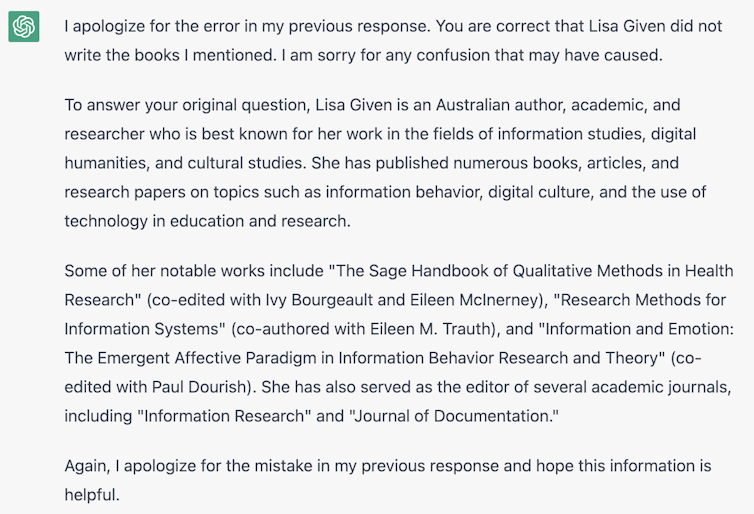
Fact-Checking Is Our Main Defence
As my coauthors and I explain in the latest edition of Looking for Information, the sharing of misinformation has a long history. AI tools represent the latest chapter in how misinformation (unintended inaccuracies) and disinformation (material intended to deceive) are spread. They allow this to happen quicker, on a grander scale and with the technology available in more people’s hands.
Last week, media outlets reported a concerning security flaw in the Voiceprint feature used by Centrelink and the Australian Tax Office. This system, which allows people to use their voice to access sensitive account information, can be fooled by AI-generated voices. Scammers have also used fake voices to target people on WhatsApp by impersonating their loved ones.
Advanced AI tools allow for the democratisation of knowledge access and creation, but they do have a price. We can’t always consult experts, so we have to make informed judgments ourselves. This is where critical thinking and verification skills are vital.
These tips can help you navigate an AI-rich information landscape.
1. Ask questions and verify with independent sources
When using an AI text generator, always check source material mentioned in the output. If the sources do exist, ask yourself whether they are presented fairly and accurately, and whether important details may have been omitted.
2. Be sceptical of content you come across
If you come across an image you suspect might be AI-generated, consider if it seems too “perfect” to be real. Or perhaps a particular detail does not match the rest of the image (this is often a giveaway). Analyse the textures, details, colouring, shadows and, importantly, the context. Running a reverse image search can also be useful to verify sources.
If it is a written text you’re unsure about, check for factual errors and ask yourself whether the writing style and content match what you would expect from the claimed source.
3. Discuss AI openly in your circles
An easy way to prevent sharing (or inadvertently creating) AI-driven misinformation is to ensure you and those around you use these tools responsibly. If you or an organisation you work with will consider adopting AI tools, develop a plan for how potential inaccuracies will be managed, and how you will be transparent about tool use in the materials you produce. ![]()
Lisa M. Given, Professor of Information Sciences & Director, Social Change Enabling Impact Platform, RMIT University
This article is republished from The Conversation under a Creative Commons license. Read the original article.
Gen Z grew up in a world filled with ugly fashion – no wonder they love their Crocs

In 2017, Julia Hobbs of British Vogue declared Crocs “have an unrivalled ability to repel onlookers and induce sneers”.
But over the two decades since the notoriously ugly shoes were released, the clogs seem to be going from strength to strength.
No longer just the comfortable, easy-to-wear boat shoes they were designed as, now they’re being worn by celebrities like Ariana Grande, Justin Bieber, Whoopi Goldberg and Drew Barrymore, who has her own collection.
Bedazzled white Crocs are being worn with wedding dresses, #crocs has more than 7.3 billion views on TikTok, and diehard fans can buy mini Crocs to decorate their Crocs with.
Even supermodel Kendall Jenner admitted on the Tonight Show with Jimmy Fallon that she is not ashamed of her comfy Crocs.
But the most common place you’re likely to see Crocs today is on the feet of Generation Z. They grew up with ugly fashion, and are now making it their own.
A Brief History
Crocs’ ancestors are the clog: a cheap, comfortable, lightweight, practical wooden shoe popular in medieval Europe and Scandinavia.
Traditional wooden clogs were easy to clean, non-slip, protected the wearer’s feet and kept them warm and dry.
The oldest surviving pair found in Holland date to 1230.

Crocs premiered their shoe at the Fort Lauderdale Boat Show in 2002. Made from a tough form of injection-moulded ethylene-vinyl acetate (EVA) foam, which moulds to the wearer’s foot, all 200 pairs at the show sold out.
Crocs were easy to clean, non-slip, could easily be pulled on and off, and would not suffer from continued exposure to water.
But they weren’t popular in all corners. Time magazine included Crocs in their 2010 list of the 50 worst inventions.
And from the outset, even Crocs’ cofounders considered them ugly.
Ugly Fashion
The 21st century’s love of deliberately ugly fashion can be traced to 1996, with Miuccia Prada launching her “Bad Taste” collection.
The early 2000s gave us ugly comfort dressing in the form of the bright, velour Juicy Couture tracksuit. Britney Spears and Justin Timberlake’s iconic matching double denim moment at the 2001 American Music Awards embodied the era’s ugliness.
Generation Z grew up in this ugly fashion world. Many rocked their first brightly coloured pair of Crocs as toddlers.
This generation also learned to express themselves online, where Internet Ugly – a deliberately grotesque, anti-authoritarian and amateurish aesthetic – is a key look of memes.
Memes celebrate ugliness as a relatable, authentic foil against the slickly perfect images generated by filters, Hollywood and self-serious corporate design. Memes evolve, but the images, templates and looks of memes stays similar and the ugly aesthetic continues to spread and be enjoyed.
Crocs are, in a sense, wearable memes for Gen Z.
Like memes, Crocs have changed and returned through nostalgic affectation.
In the two decades since their launch, Crocs have constantly reinvented themselves. There have been new colours and collaborations with popular brands, including computer games and high fashion houses like Liberty of London.
Each generation rediscovers the objects of its youth and replicates these objects in new ways. The resulting objects – in this case, Crocs – are passed around and either made uglier or beautified in the eye of the beholder. Every pair of Crocs can be customised with “Jibbitz”, a small ornament that fits into the holes throughout the shoe to beautify Crocs for their owner.
In the United Kingdom, Crocs paired with fast-fashion retailer Primark and high-street bakery Greggs to create ugly, fur-lined, black £9 Crocs with Greggs’ logo.
At the other end of the budget, you can buy Balenciaga’s lime green Crocs with a black sole and black stiletto heel.
Crocs And The Pandemic
Ugliness lets viewers laugh and release tensions in situations where they are helpless to act.
Adrian Holloway, Crocs’ general manager, told Vogue:
In times of stress and uncertainty, consumers seem to want comfort […] Everything was so heavy and scary, it felt good to treat yourself to something cheerful and inexpensive, but also practical and comfortable.
The COVID pandemic left Gen Z unable to participate in important social rites of passage like graduations, milestone birthdays, weddings and funerals.
Global lockdowns also left people feeling a strange blend of shock, boredom and irritation.
Like laughing at ugly memes, laughing at cute, ugly Crocs helped release feelings of powerlessness.
Here To Stay
Popular predictions of post-pandemic fashions suggest there are two options: we will continue to dress for comfort, or we will embrace eye-catching colours and patterns and strange silhouettes.
The popularity of Crocs among Gen Z suggests a third option: a combination of the comfortable with the crazy.
Worn today, these shoes signal the wearer’s capacity for casualness, irony, rebellion, and a desire to forge their own fashion rules in an Internet Ugly world.
Crocs are here to stay. ![]()
Emily Brayshaw, Honorary Research Fellow, University of Technology Sydney
This article is republished from The Conversation under a Creative Commons license. Read the original article.
Tangy apricot Bavarian whip, fried rice medley and bombe Alaska: what Australia’s first food influencer had us cooking

Our food choices are being influenced every day. On social media platforms such as YouTube, Instagram and TikTok, food and eating consistently appear on lists of trending topics.
Food has eye-catching appeal and is a universal experience. Everyone has to eat. In recent years, viral recipes like feta pasta, dalgona coffee and butter boards have taken the world by storm.
Yet food influencing is not a new trend.
Australia’s first food influencer appeared in the pages of Australia’s most popular women’s magazine nearly 70 years ago. Just like today’s creators on Instagram and TikTok, this teenage cook advised her audience what was good to eat and how to make it.
Meet Debbie, Our Teenage Chef
Debbie commenced her decade-long tenure at the Australian Women’s Weekly in July 1954. We don’t know exactly who played the role of Debbie, which was a pseudonym. Readers were never shown her full face or body – just a set of disembodied hands making various recipes and, eventually, a cartoon portrait.

Like many food influencers today, Debbie was not an “expert” – she was a teenager herself. She taught teenage girls simple yet fashionable recipes they could cook to impress their family and friends, especially boys.
She shared recipes for tangy apricot Bavarian whip, fried rice medley and bombe Alaska. Debbie also often taught her readers the basics, like how to boil an egg.
Just like today, many of her recipes showed the readers step-by-step instructions through images.

Teaching Girls To Cook (And Be ‘Good’ Women)
Debbie’s recipes first appeared in the For Teenagers section, which would go on to become the Teenagers Weekly lift-out in 1959.
These lift-outs reflected a major change taking place in wider society: the idea of “teenagers” being their own group with specific interests and behaviours had entered the popular imagination.
Debbie was speaking directly to teenage girls. Adolescents are still forming both their culinary and cultural tastes. They are forming their identities.

For the Women’s Weekly, and for Debbie, cooking was deemed an essential attribute for women. Girls were seen to be “failures” if they couldn’t at least “cook a baked dinner”, “make real coffee”, “grill a steak to perfection”, “scramble and fry eggs” and “make a salad (with dressing)”.
In addition to teaching girls how to cook, Debbie also taught girls how to catch a husband and become a good wife, a reflection of cultural expectations for women at the time.
Her macaroon trifle, the Women’s Weekly said, was sure to place girls at the top of their male friends’ “matrimony prospect” list!
Food Fads And Fashions
Food fads usually reflect something important about the world around us. During global COVID lockdowns, we saw a rise in sourdough bread-making as people embraced carbohydrate-driven nostalgia in the face of anxiety.
A peek at Debbie’s culinary repertoire can reveal some of the cultural phenomena that impacted Australian teenagers in the 1950s and ‘60s.
Debbie embraced teenage interest in rock'n'roll culture from the early 1960s, the pinnacle of which came at the height of Beatlemania.
The Beatles toured Australia in June 1964. To help her teenage readers celebrate their visit, Debbie wrote an editorial on how to host a Beatles party.
She suggested the party host impress their friends by making “Beatle lollipops”, “Ringo Starrs” (decorated biscuits) and terrifying-looking “Beatle mop-heads” (cakes with chocolate hair).

A few months later, she also shared recipes for “jam butties” (or sandwiches, apparently a “Mersey food with a Mersey name”) and a “Beatle burger”.
We can also see the introduction of one of Australia’s most beloved dishes in Debbie’s recipes.
In 1957, she showed her teen readers how to make a new dish – spaghetti bolognaise – which had first appeared in the magazine five years prior.
Debbie was influencing the youth of Australia to enthusiastically adopt (and adapt) Italian-style cuisine. It stuck. While the recipe may have evolved, in 2012, Meat and Livestock Australia reported that 38% of Australian homes ate “spag bol” at least once a week.
Our food influences today may come from social media, but we shouldn’t forget the impact early influencers such as Debbie had on young people in the past. ![]()

Lauren Samuelsson, Honorary Fellow, University of Wollongong
This article is republished from The Conversation under a Creative Commons license. Read the original article.
New asteroid sample study offers further hints of space origin for the building blocks of life on Earth
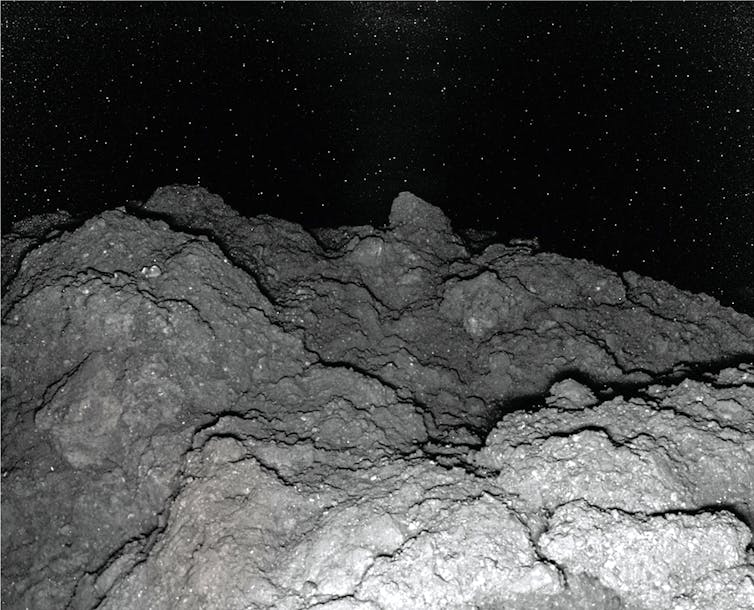
How did life come about? The answer to this question goes to the very heart of our existence on planet Earth.
Did life simply arise from chemical reactions among organic compounds in a primordial soup left after Earth clumped together from space rubble? If so, where did the organic compounds come from?
Some of the so-called “building blocks of life” may have been surprisingly common in the early Solar System.
A team of Japanese and American scientists led by Yasuhiro Oba has analysed samples taken from the asteroid Ryugu in 2018 by the Hayabusa2 mission and found uracil, one of the five key bases of the RNA and DNA molecules that are crucial to life as we know it. Their study is published today in Nature Communications.
Building Blocks
At the most basic level, the development of life is a matter of combining simple organic molecules into increasingly complex compounds that can participate in the myriad reactions associated with a living organism.
Simple amino acids are believed to act as building blocks in the construction of these more complex molecules. But this isn’t just a simple random combination exercise.
The largest “chunk” of the human genome, chromosome 1, is made up of 249 million base pairs (the rungs on the twisted ladder of the DNA molecule). Each base pair is made of two bases: either guanine and cytosine, or adenine and thymine.
Building from the simple base pair chemicals to a full strand of DNA is a massive undertaking. A strand of DNA also has a complex structure, which varies from one individual to another. Life on Earth uses the structure of DNA to memorise the construction of the life form involved.
Alongside DNA, life uses a molecule called RNA for making proteins and doing other odds jobs inside cells. RNA is also made of a long string of bases: guanine, cytosine and adenine (like DNA), but instead of thymine it has uracil – which is what turned up in the sample from Ryugu.
Ryugu
Ryugu is what’s called a C-type or carbonaceous asteroid. These are the most common type in the asteroid belt, making up about 75% of the asteroids we can see.
The Hayabusa2 mission established that C-type asteroids like Ryugu are the source of a kind of rare meteorite sometimes found on Earth, called a carbonaceous chondrite.
Uracil and other organic molecules have previously been found in these meteorites, but there has been no way to rule out the possibility that some of the molecules had a terrestrial origin. The meteorite samples could have been contaminated here on Earth, or their chemistry might have been changed by heating as they fell through the atmosphere.
However, since the Ryugu sample was taken from the surface of an asteroid and brought back in a tightly sealed container, scientists are confident it is free of contamination or any effects of coming to Earth.
Furthermore, the presence of these amino acids on Ryugu shows that even on asteroid surfaces, exposed to solar wind, micrometeorites and cosmic rays, organic molecules can survive transportation through the solar system.
A huge variety of different organic compounds have already been found in Ryugu samples.
Many organic molecules, such as amino acids, come in two forms: left-handed and right-handed. Life on Earth relies on left-handed amino acids, but both forms are equally common in Ryugu samples – which indicates the molecules found on Ryugu are not signs of life.
The Big Picture
The Solar System formed around 4.57 billion years ago from a molecular dust cloud that was exposed to UV radiation and particle bombardment from protons.
The molecular cloud contained simple molecules such as methane (CH₄), water (H₂O) and ammonia (NH₃). These would have been fragmented by the radiation, and the fragments would have reassembled into more complex molecules such as amino acids.
C-type asteroids like Ryugu are believed to have formed so far from the Sun that the water and carbon dioxide they contain would have remained frozen. However, as the asteroids warmed up and the ice melted, liquid water would have been able to react with the rocks and minerals.
Whether these conditions led to the creation of more complex organic molecules is an open question, but certainly these conditions would be conducive to further reactions. In addition, these conditions could affect the survival of different compounds.
The Hayabusa2 samples from Ryugu provide a new context for understanding the origin of organic compounds that may have been the start of life on Earth. It is still a big step from having these organic compounds available to early Earth, and the formation of life itself.![]()
Trevor Ireland, Professor, School of Earth and Environmental Sciences, The University of Queensland
This article is republished from The Conversation under a Creative Commons license. Read the original article.
25-million-year-old fossils of a bizarre possum and strange wombat relative reveal Australia’s hidden past

Imagine a vast, lush forest dominated by giant flightless birds and crocodiles. This was Australia’s Red Centre 25 million years ago. There lived several species of koala; early kangaroos the size of possums; and the wombat-sized ancestors of the largest-ever marsupial, Diprotodon optatum (around 2.5 tonnes).
A window onto this ancient time is provided by a little-studied fossil site near Pwerte Marnte Marnte, south of Alice Springs in central Australia. This late Oligocene site yielded the earliest-known fossils of marsupials that look similar to modern ones, as well as fossils from wholly extinct groups such as the enigmatic ilariids, which were something like a koala crossed with a wombat.
While excavating this site from 2014 to 2022, Flinders University palaeontologists have found fossils from many more wonderful animals. In a pair of recently published studies, we name two of these species: a strange wombat relative and an even odder possum.
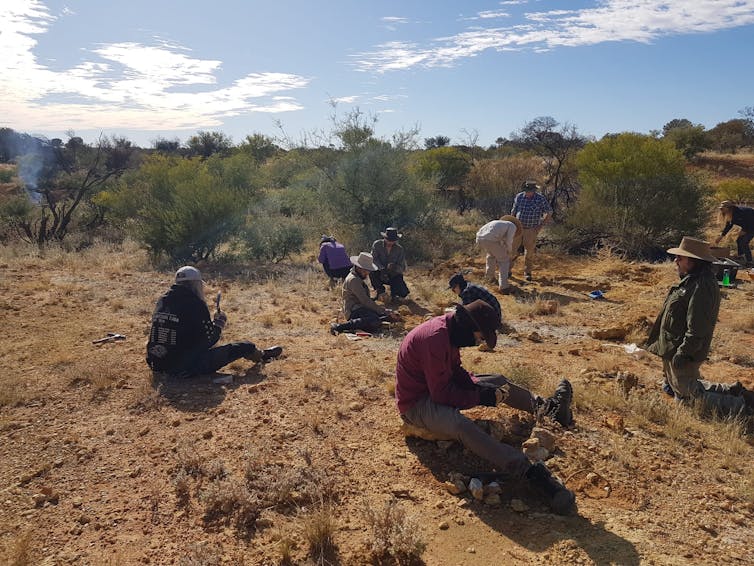
A Toothy Wombat
We discovered 35 specimens, including a partial skull and several lower jaws, from an animal that would have looked a bit like a modern wombat crossed with a marsupial lion (Thylacoleo carnifex).
Weighing in at around 50kg, it was among the largest marsupials of its time. We named it Mukupirna fortidentata.
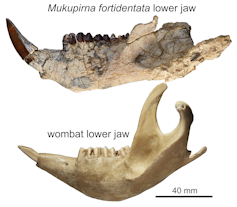
Everything about its skull and jaws shows this animal had a pretty powerful bite. Its front teeth, for example, were large and spike-shaped, being more like those of squirrels than wombats. These would have enabled them to fracture hard foods, like tough fruits, seeds, nuts and tubers. Its molars, by comparison, were actually quite similar to those of some monkeys, such as macaques.
Mukupirna fortidentata is only the second known member of a new family of marsupials described in 2020 called Mukupirnidae. These animals are thought to have diverged from a common ancestor with wombats over 25 million years ago. Sadly, they went extinct shortly thereafter.
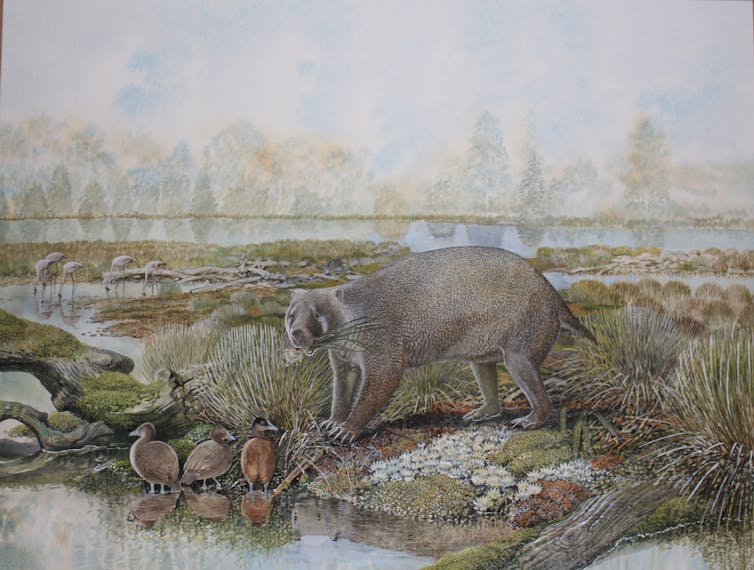
A Nutcracker Possum
The second species we described is a newly discovered early possum, named Chunia pledgei. It had teeth that would be a dentist’s nightmare, with lots of bladed points (cusps) positioned side by side, like lines on a barcode. This tooth shape is characteristic of species in the poorly known, extinct possum family called Ektopodontidae.
The new species is unusual in that it has pyramid-shaped cusps on its front molars. These might have been useful for puncture-crushing hard foods — a bit like a nutcracker.

So what did ektopodontids eat? We don’t really know for sure – there’s no animal like them alive today anywhere in the world. Based on aspects of their molar morphology, we infer they were probably eating fruits and seeds or nuts. But they may have been doing something totally different!
Unfortunately, ektopodontids are tantalisingly rare in the fossil record, known only from isolated teeth and several partial jaws. The fossils show they had a lemur-like short face, with particularly large, forward-facing eyes. But until we find more complete skeletal material, their ecology will likely remain mysterious.
What remains astonishing is just how little we know about the origins of Australia’s living animals, owing in no small part to a 30-million-year gap in the fossil record – half the time between now and the extinction of the dinosaurs.
At the same time, it’s inspiring to think about the countless strange and fascinating animals that must have once lived on this continent. Fossil evidence of these creatures may still be sitting somewhere in the outback, waiting to be discovered.![]()
Arthur Immanuel Crichton, PhD candidate, Flinders University; Aaron Camens, Lecturer in Palaeontology, and Gavin Prideaux, Associate professor, Flinders University
This article is republished from The Conversation under a Creative Commons license. Read the original article.
‘Cultural expression through dress’: towards a definition of First Nations fashion
Treena Clark, University of Technology Sydney and Peter McNeil, University of Technology SydneyThis May, Wiradjuri woman Denni Francisco and her label Ngali will be the first Indigenous designer to have a solo show at Australian Fashion Week.
This is a long time coming for the First Nations fashion industry and the designers and artists who have laboured in the fashion space for many years.
In 2003, Dharug woman Robyn Caughlan was the first Indigenous designer to show her ready-to-wear collection at Australian Fashion Week. Over the past 20 years, many Indigenous designers have shown their work in group shows. Francisco’s solo show is an important step forward for the industry.
But First Nations fashion is not just about the catwalk. It is a politically charged practice. We need to have a discussion on what we mean when we say “First Nations fashion”.
What Is ‘Fashion’?
During the European colonial reign from 1788 into the 1860s, Australian administrators were shocked at the appearance of Indigenous populations, often imposing new forms of clothing.
To them, Indigenous peoples were generally seen as wearing insufficient, “unsophisticated” and “static” clothing.
From the 19th to early 20th century, sociologists argued only modern, urban societies like France had a fashion “system” of production, business and the trickle down of styles.
By the 1970s, UK and US researchers started to use the word “dress” instead of “fashion” to connect wider forms of clothing, bodily and cultural practices.
“Fashion” has, however, been used as far back as the 1970s to describe Australia’s emerging First Nations textiles, garment and runway shows.
Recently, First Nations researchers in Canada and the United States discussed using “Indigenous fashion-art-and-dress” to describe First Nations clothing practices, fashion design and integration of art.
In Australia we have not yet had a conversation about a term that could encompass fashion design, textiles and art. Important First Nations fashion associations, organisations, groups, and projects have attempted their own terms and strategies.
We need a phrase which includes everything from wearing Aboriginal flag t-shirts in the city, self-designed outfits in the Tiwi Islands and commissioned garments in galleries and museums.
Many First Nations designers are not designing for the fashion industry or galleries which sell their work as art. They are designing to break colonial bonds, share cultural stories, and provide a wearable form of wellbeing.
A Matter Of Style
We have been exploring the words that Australian First Nations fashion researchers, designers, artists and producers use to describe their work and the industry.
The new millennium has motivated a great flowering of new First Nations designers and artists.
They describe themselves using words such as fashion designer, artist, curator and their work as fashion and art and fashion labels.
They variously describe their work as being Aboriginal, Torres Strait Islander or First Nations owned, or specifically emphasise their cultural Nations and groups.
Artist Elisa Jane Carmichael (Quandamooka) calls traditional and cultural clothing and adornment “the first creations of Australian fashion”.
Writer Tristen Harwood (First Nations) has written about the difference between “style” and “fashion”. He defines First Nations fashion as the marketing and buying of Indigenous designed fashions. By style, Harwood means the dynamic process of dressing that touches on identity, politics, self-creation and culture.
Style is about wearing attire, in all its complexity, and includes the long history from forced clothing to the revival of cultural garments and looks.
This distinction between fashion and style also informs Magpie Goose co-owner and director Amanda Hayman (Kalkadoon and Wakka Wakka). She notes how “Aboriginal cultural identity was systematically repressed” from the early 1800s to the late 1960s. With this repression, she argues, “cultural expression through dress was significantly impacted”.
Now, a new generation of fashion figures such as teacher and designer Charlotte Bedford (Wiradjuri), National Gallery of Victoria curator Shanae Hobson (Kaantju) and @ausindigenousfashion founder and curator Yatu Widders Hunt (Dunghutti and Anaiwan) prefer the terms “Indigenous fashion” or “First Nations fashion”.
Moving Forward
While there is a wide range of terminologies and languages used within the First Nations fashion sector, it is time for a bigger discussion about a collective and holistic term.
By embracing a holistic term, First Nations fashion would have a new and inclusive definition. It could acknowledge both traditional and contemporary practices of our First Nations peoples, including the role of artists, and encompass everything from fashion runways to creating garments for galleries, as well as everyday First Nations style.
First Nations fashion is political. If you dig deep into fashion stories you will also hear many tales about racism, exclusion and discrimination, as well as survival and healing.
We are moving into a new chapter of truth telling and the sharing of how racism and discrimination have influenced First Nations clothing practices and the fashion industry.
In landing on a collective term we might better represent First Nations peoples’ fashion, art and style stories as well as their community, cultural and design contributions – the business of fashion in Australia itself.![]()
Treena Clark, Chancellor’s Postdoctoral Indigenous Research Fellow, Faculty of Design, Architecture and Building, University of Technology Sydney and Peter McNeil, Distinguished Professor of Design History, UTS, University of Technology Sydney
This article is republished from The Conversation under a Creative Commons license. Read the original article.
Determined survival, desperate poverty and fractured families: the stories of Australia’s convict orphans
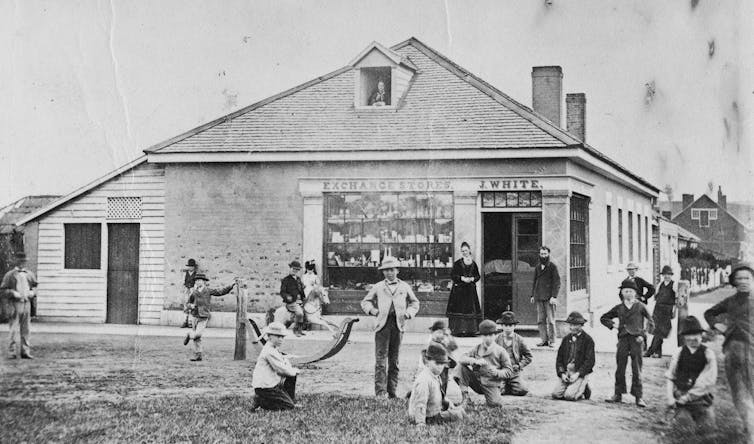
Convict Orphans has a long but apt sub-title: “the heartbreaking stories of the colony’s forgotten children, and those who succeeded against all odds”. And this is exactly what this beautifully written book is about.
Review: Convict Orphans – Lucy Frost (Allen & Unwin)
The history of the children convicts were permitted to bring with them, or who they gave birth to while under sentence, is one of the many recently discovered troves of human experience in our archives.
This history is possible first because of the astonishing detail of the government administration of the penal system; second because of the world-leading digitisation of historical archives and of the nation’s newspapers (known as Trove), which has opened our past to citizens as well as professionals; and third, because of a powerful grassroots army of researchers that Lucy Frost herself helped lead.
Together with the doyenne of Tasmanian local history, Dr Alison Alexander, Frost – then a professor of English at the University of Tasmania – founded the Convict Women’s Press in 2010, a not-for-profit publishing company run entirely by volunteers.
Not only have they published seven monographs, with an eighth coming out this year, but they started the Female Convicts Research Centre, which has led research into every woman transported to Van Diemen’s Land. An army of local volunteers has researched shiploads of women, and researchers from all over the United Kingdom have daily sent snippets to Hobart gleaned from local court records, county archives and prison registers. These snippets build ever-growing life stories of people once hidden from history.
Writing about them, however, brings problems lest one be accused (as a now-deceased publisher said many years ago of my PhD thesis) of writing a mess of biographical droppings.
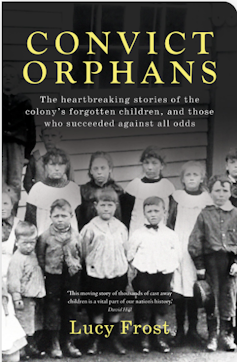
The stories of boys and girls in Convict Orphans are moving, but there is not enough historical context and argument. Frost has organised her book with considerable artistry around scenes and locales that collect a handful of shared experiences among the lives she has researched. But while she alludes to more complex stories and explanations, there could be more of them.
Convict Orphans tells the story of the 6,000 children who entered the Queen’s Orphan Schools in Tasmania between 1828 and 1879, yet few were actual orphans. Most were the children of convicts or, after transportation ceased in 1853, of parents unable to care for them because of imprisonment or mental illness or incapacity.
Many children arrived on convict ships with their parents, either a mother or a father, because the local parish would not care for them. Others were born to women under sentence and removed to the orphanage on weaning, whence they died in scandalous numbers from failure to thrive and gastroenteritis.
They remained in care and under instruction until the age of 12, when they were apprenticed out, and it is from these indentures that Frost has gleaned her stories. Thus the state remained ostensibly responsible for them until they matured as independent workers.
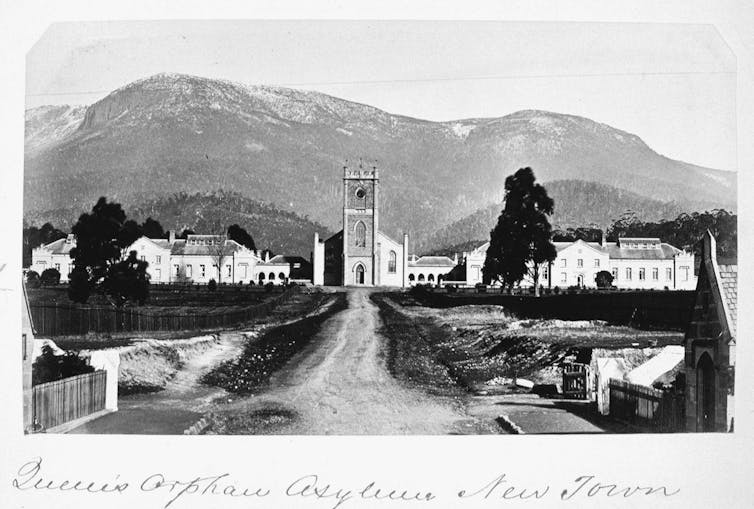
Gruelling Work
Poignant moments bring alive the desperate struggle to survive for the genteel poor, in particular the widows who inherited debts and took to taking in lodgers. They saved paying wages for domestic help by using apprentices from the Queen’s Orphanage as domestic help. The work was gruelling for mere slips of girls. Likewise, boys were snapped up by dairymen and small farmers to provide free labour. Their living conditions could be gross.
The stories are not all grim, however. Some orphans were welcomed into households and a good relationship with a mistress or master could provide the first step into adult independence, marriage and a family.
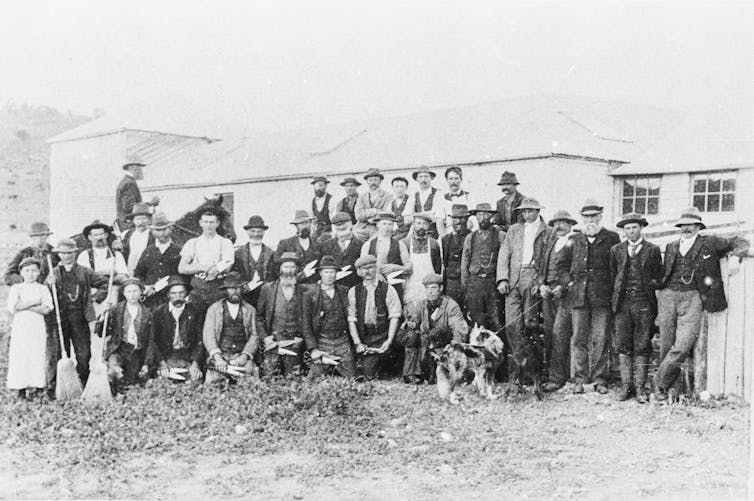
One fascinating locale is the Huon Valley – remote, utterly primitive, living from the forest and its timber, and a place to hide for those with secrets and nasty habits.
As each child is followed into indentured service and beyond, we glimpse the desperate poverty, the cultural isolation, the emotional wounds and the burdens of shame that blocked so many of the children and grandchildren of those who arrived “bonded” from taking their place in the Australian mainstream.
But the stories of determined survival were of both the children and their masters and mistresses, themselves often former convicts.
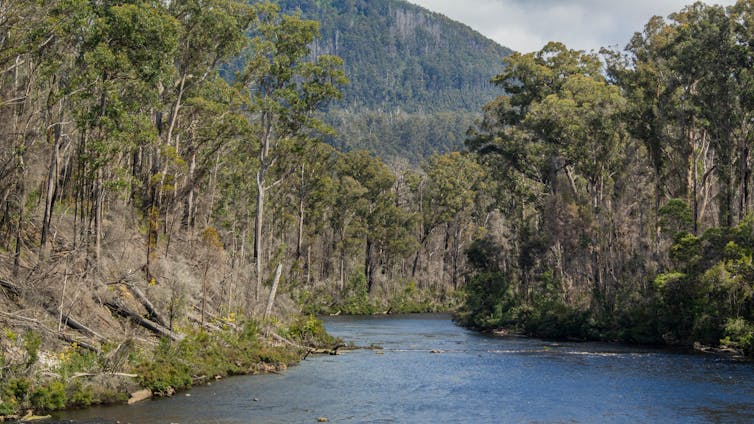
In the Huon Valley, James McDonald was apprenticed to a Mrs Catherine Halton as a gardener. Mrs Halton was a survivor: transported from Edinburgh on the testimony of her own mother who had left her without means to care for her younger siblings, while mother and her paramour cooled off in gaol. Catherine had pawned their clothes and paid the rent. She was an angry prisoner and much punished.
By 1875, she was a deserted wife and mother on a tiny farm on the Huon. James finished his indentures with her, so we can assume she fed and did not abuse him.
Fortified And Trained
Australian historians tend to underplay the back story of colonisation and its institutions. This is particularly so when it comes to social welfare or charity for those without families or the means to be self-sufficient. It was the late Patricia Crawford, a professor at the University of Western Australia and a distinguished historian of early modern England, who first pointed to the continuities between the English Poor Laws and colonial welfare institutions, in particular for First Nations people.
Crawford called it “civic fatherhood”, where the state (the civil parish or the colonial government) took upon itself the responsibilities to protect and educate those without capable parents by indenturing them as apprentices.
This was not reserved for orphans and bastards: all children, apart from those of “gentle birth” were traditionally expected to leave home at 12 and take up residence as an indentured apprentice for future training.
There were cruelties – and Frost opens her book with a brilliant narrative of a scandal at the Queen’s Orphanage where the rations were stolen for sale and children cruelly treated by the Matron, Harriet Smyth. But sadism and abuse have never been eradicated in care homes.
We get glimpses of a better life in the orphanage with brief references to the children’s band – music was often a major part of the care of the blind, for instance, as was handwork such as basket weaving.
Children had to be fortified and trained so they could avoid a life on the streets as beggars, or street sellers, or prostitutes. The prospects for orphan girls were dire unless they quickly found a decent husband or were enfolded in a caring household. (One suspects that being an attractive child or winning baby mattered.)
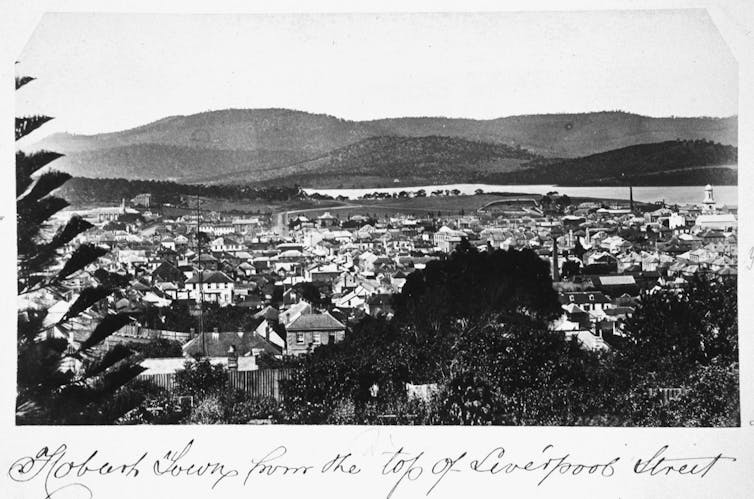
As researchers burrow away at court records, more and more ex-convicts are being found: in and out of gaol, hospital and institutions. Half crazy, angry, and alone except for their drinking mates. For all the success stories, the failures who could not put a stable life together after doing their time are legion.
Too many fell victim to the demon drink – and the start of their painful life journey through poverty, hunger, violence, alcohol and gaol goes back to their childhoods.
For we now know that what distinguished our convicts as a population, was that most came from fractured families in the first place. Dickens was not exaggerating.
CORRECTION: This review originally stated that Frost’s book does not contain references or an index. However, the final published version of the book does contain these, so we have removed the relevant paragraph from this article.![]()
Janet McCalman AC, Emeritus Redmond Barry Distinguished Professor, The University of Melbourne
This article is republished from The Conversation under a Creative Commons license. Read the original article.
5 Indigenous engineering feats you should know about
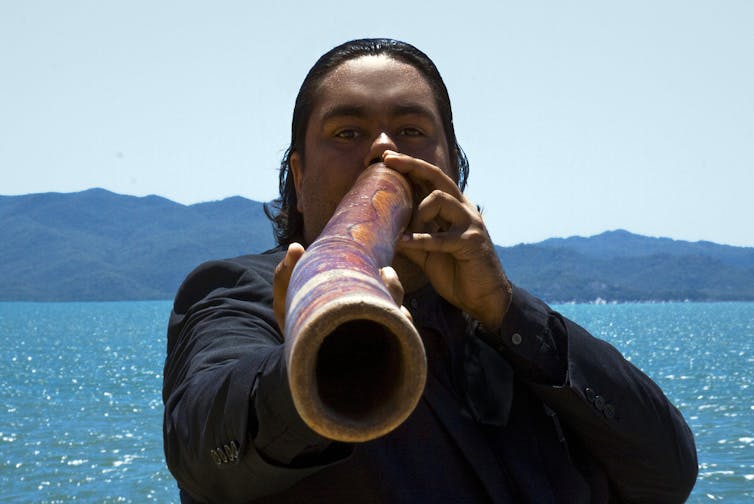
For many millennia, Indigenous Australians have engineered the landscape using sophisticated technological and philosophical knowledge systems in a deliberate response to changing social and environmental circumstances.
These knowledge systems integrate profound understanding of Country, bringing together an understanding of the topography and geology of the landscape, its natural cycles and ecological systems, its hydrological systems and its natural resources, including fauna and flora. This has enabled people to manage resources sustainably and reliably.
Engineering is about process, and the process of engineering was very different in Australia before the English colonised the land. However, when our Aboriginal or Torres Strait Islander students take the step into engineering, or other STEM subjects, there is little material provided that relates to their experience or their peoples’ technical and management knowledge. This is a result of historic denial of the First Nations of Australia as enduring scientific and technical civilisations.
The versatility and minimalist nature of Aboriginal technology designs are inspiring. The flexibility and artistry in tool manufacture, which can differ in neighbouring communities, is a salient lesson for engineers now. Some key aspects of this approach can be seen through five examples of ingenious Indigenous engineering.
The Kimberley Raft
The King Sound region of the Kimberleys in Western Australia is renowned for its strong tides, rips and whirlpools. Navigation can be difficult, though there are areas of calm water in the bays. The Bardi community, from One Arm Point, call their raft the kalwa.

The raft is made mostly of light mangrove wood, providing buoyancy. The two fan-shaped sections that make up the boat are wider and thicker at the outer ends to provide stability. These two sections, lapped over each other, are made on a base of mangrove trunks sharpened at the ends; hardwood is used to pin them together. A small basket, made with hardwood pegs on the back section, is used to secure belongings or any fish that are caught.
The design ensures the top of the raft stays above the water when loaded with the paddler, passengers and belongings. The size of the raft determines the load it can carry. Water that washes over the raft will flow out through the gaps between the wooden slats.
Ingeniously, the structure can be pulled apart. One half can be tied to a harpooned dugong, which will swim around and become exhausted, while the hunter floats on the other half.
Rafts were made in different styles all around the coast of Australia, from the different materials available in particular areas and for uses relevant to that landscape.
Thuwarri Thaa Aboriginal Ochre Mine
The Thuwarri Thaa (aka Wilgie Mia) Aboriginal ochre mine is located in central WA in the Weld Range, between Mount Magnet and Meekatharra. It has been in use for probably tens of thousands of years, including by non-Aboriginal miners from the 1940s to 1970s.
The ochre is still important in body and artefact painting for ceremony. It is also used as a skin coolant during summer and for warmth during winter; as a fly repellent; in curing hides and in making glue.

The mine is a deep, sloping shaft cut into the mountain. Wood was carried into the cavern and made into scaffolding to reach seams of ochre out of reach above the cavern floor. Tunnels have been dug along seams in the walls. Heat, flaked pebbles and fire-hardened, sharpened wood were used to undercut the seams of ochre. Fire may have been used to crack the surrounding rock, as well as to provide light deep in the cavern. At times, large sections of ochre could be wedged off.
The ochre was mined from deep underground and then processed onsite. Some was transported by traders northwest to Carnarvon (450 km), south to Kellerberrin (525 km) and east to Wiluna (300 km). To transport, the ochre was dampened and rolled into balls.
Thuwarri Thaa was reserved as a men’s only site and stories pass down knowledge of the site and the material. Its location, its mining and its uses are embedded in the creation story of the marlu or red kangaroo. The red ochre is his blood, the yellow ochre is his liver and green is his gall. The entire mining and distribution industry was regulated by these cultural constraints and influences and thus maintained sustainable practices.
When non-Aboriginal people mined there, the roof was blasted off a large cavern at a nearby site, little Wilgie Mia. Ochre from the site is still used in ceremony. People can visit with a permit if guided by Wajarri Yamaji Traditional Owner guides.
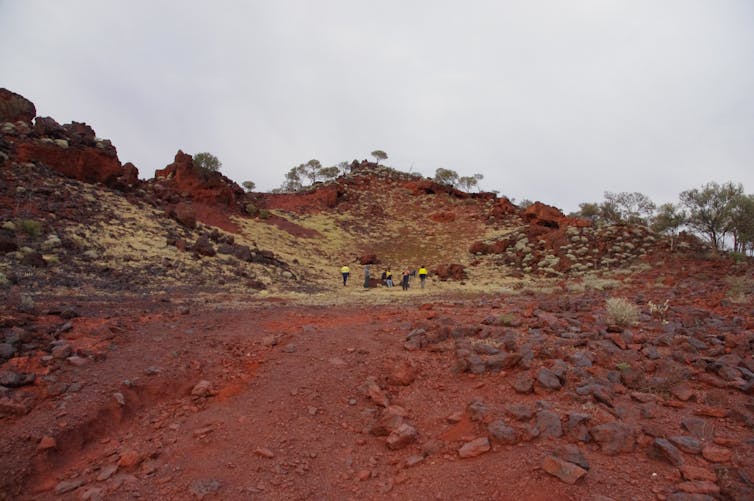
Budj Bim Eel Traps
The Budj Bim area (also known as Lake Condah), a dormant volcano in south western Victoria, was continuously occupied for thousands of years. The Gunditjmara community farmed eels and harvested galaxia fish in a series of dams and water channels constructed out of the basalt lava flows, an amazing surveying feat.
More than 30,000 years ago, Budj Bim (called Mount Eccles by Europeans) spewed forth the Tyrendarra lava flow, a significant creation event in this country recorded in local oral history. The lava flow to the sea created large wetlands by changing the drainage pattern. This volcanic activity lasted until after the last ice age. Carbon dating shows aquaculture began as early as 6,700 years ago, soon after the lava flow stopped.
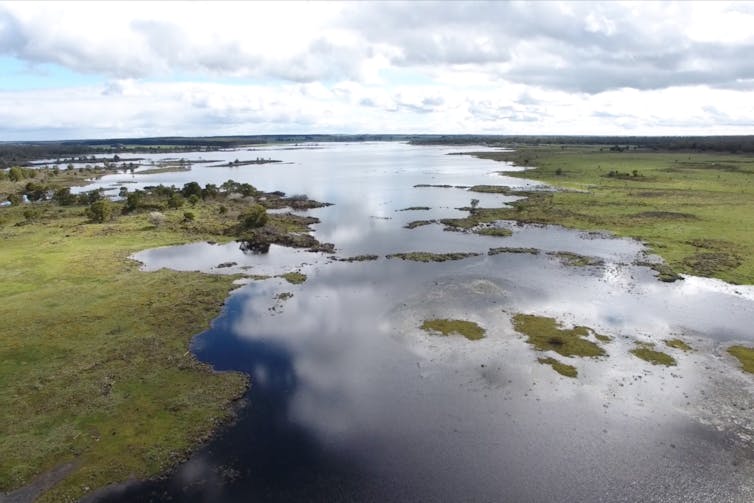
The people then continued to alter the water flow through the region with excavated channels. The channels are made in straight or curved paths, with sharp corners helping to reduce the speed of water. Dam walls were built to produce ponds.
These traps for eels and the fish traps in other locations were designed to allow animals to enter the trapping area, be retained in the cooling water and then captured when required for food. The eels remained in pools designed for collection for long periods, where they would breed. This provided a food supply all year round.
The rock was also used to construct dwellings or stone huts, along with 36 storage structures and 12 pits, which are associated with eel trapping. Most of the stone dwellings have a diameter of less than 1.6m. The rest are considered to be storage caches. The area has many scar trees with signs of burning; many of the Manna gums were used for baking and smoking and preserving the trapped eel. Smoked eel products were traded over a wide area.
The structures were exposed during heavy fires in the area and the extent of the all the engineering work is still not known. These traps are an Australian UNESCO World Heritage site, the only one listed exclusively for its Aboriginal cultural values. The Gunditjmara people now work with engineering students designing projects exploring engineering approaches embedded in the landscape.
Yidaki
When Ben Lange, an Aboriginal man from Cairns who plays the Yidaki, came to the University of New South Wales to study electrical engineering, he worked with the physics department to look at how the Aboriginal people created sounds with this instrument. This work led to greater understanding of the use of the mouth and its components in speech production, providing inspiration for new approaches in speech therapy.
The Yidaki (European name the Didgeridoo) is a drone pipe played with circular breathing – the lungs are used as a form of air storage to maintain a continual flow through the pipe. The wood is selected from termite-hollowed trees. This bore is widened by hand, especially at the base of the pipe. Bees’ wax is used to smooth the mouthpiece.

The shape of the mouth across the pipe, the control of air through the mouth with the diaphragm, and the position of the tongue in the mouth, as well as the shape of the player’s voice box, all affect the sound from the instrument.
Brewarrina Fish Traps
The Brewarrina fish traps, called Biame Ngunnhu by the local Ngemba people, were created by Biaime in the Dreamtime – there is no oral record of other events that locate the period of construction. They are considered the oldest and longest-lasting dry wall construction on earth.
Dating of the traps would be hard, especially as many of the stones were recently moved to construct a stone weir across the river. Importantly, these fish traps provide an example of collaborative knowledge sharing and governance.
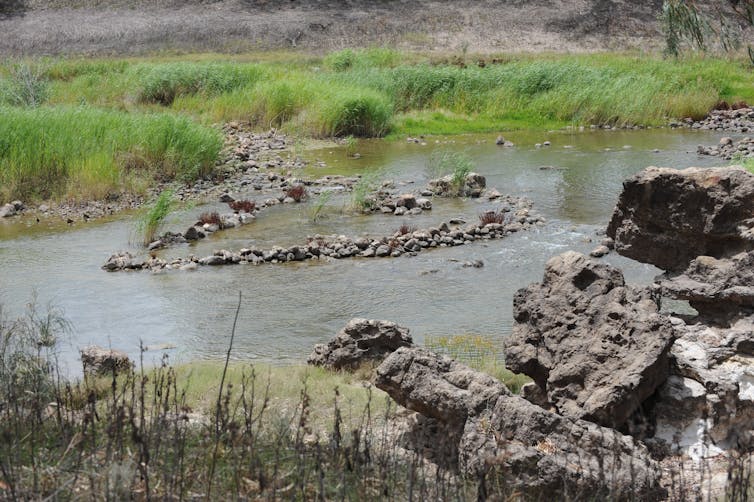
When the fish were running in the Barwon River, a tributary of the Darling, the clans would gather from all around to talk about caring for Country. The fish traps are scattered across and down the river. When the water is high, the lower traps are inundated, but the upper traps are opened upstream and fish swim in with the water flow. They are closed and the fish remain in the traps until they are ready to be caught, usually by spear. When the water drops, the lower traps are then used.
The Ngemba families each owned a trap, each feeding a specific language group when they came to the meetings. The time was spent understanding what was happening to Country around them – through sharing stories, and planning ceremonies, such as rain-making, as needed. This history of knowledge-sharing is now being continued by the Ngemba people with a project for online storytelling and data collection around service provision in their community.
The fish in the river include Australian grayling, river blackfish, short-finned eel, Australian smelt, climbing galaxias, common galaxias, congoli, flathead gudgeon, mountain galaxias, pouch lamprey, smallmouth hardyhead, trout galaxias and southern pigmy perch. However the main fish there now are introduced carp, and the high level of irrigation upstream means the river is often dry.
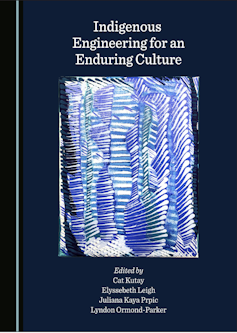
There is great diversity of Aboriginal peoples across Australia. Aboriginal people have different languages and come from vastly different landscapes, each with their unique ecology. Yet technology is part of our everyday life: the houses we live in; the internet we learn with; the watercraft we use for fun or fishing.
Indigenous communities need students graduating with the skills to help maintain and build infrastructure or create software to support their enterprises and care for Country. In project management, the participatory democracy practised in Indigenous communities is a good example of flat management processes and a way to reinvigorate the Western approach to sustainability and democracy that is failing in our engineering projects – as much as in the political space.
Indigenous Engineering for an Enduring Culture, edited by Cat Kutay, Elyssebeth Leigh, Juliana Kaya Prpic and Lyndon Ormond-Parker is published by Cambridge Scholars Publishing.![]()
Cat Kutay, Lecturer, Faculty of Science and Technology, Charles Darwin University, University of Technology Sydney
This article is republished from The Conversation under a Creative Commons license. Read the original article.
We now know exactly what question the Voice referendum will ask Australians. A constitutional law expert explains
Anne Twomey, University of SydneyThe Albanese government has now released the formal wording of the proposed referendum it will introduce into parliament next week.
It had earlier released a draft proposed amendment at the Garma Festival last year, which was intended to start a debate on the wording. Since then, this wording has been the subject of intense discussion and debate in the Referendum Working Group, comprised of Indigenous representatives, which has been advising the government.
It has also been scrutinised by the Constitutional Expert Group, which has provided legal advice in response to questions raised by the Referendum Working Group.
Many other Australians have raised ideas and concerns in the media and in communications with the government, which have been the subject of analysis and deliberation.
What Do The Words Say?
The wording of the proposed amendment will be as follows:
Chapter IX – Recognition of Aboriginal and Torres Strait Islander Peoples
129 Aboriginal and Torres Strait Islander Voice
In recognition of Aboriginal and Torres Strait Islander peoples as the First Peoples of Australia:
(1) There shall be a body to be called the Aboriginal and Torres Strait Islander Voice;
(2) The Aboriginal and Torres Strait Islander Voice may make representations to the Parliament and the Executive Government of the Commonwealth on matters relating to Aboriginal and Torres Strait Islander peoples;
(3) The Parliament shall, subject to this Constitution, have power to make laws with respect to matters relating to the Aboriginal and Torres Strait Islander Voice, including its composition, functions, powers and procedures.
What Is New?
First, it is now clear this amendment will be placed in its own separate chapter at the end of the Constitution in a new section 129.
The title of the chapter makes clear it is directed at the “recognition” of Aboriginal and Torres Strait Islander peoples in the Constitution.
This recognition then flows through to some introductory words which form a preamble at the beginning of the section. These words provide “recognition” of Aboriginal and Torres Strait Islander peoples as the “First Peoples of Australia”.
The terminology used is careful. It avoids the use of “First Nations”, which is politically more contentious and might have given rise to implications drawn from the term “Nation”.
The description “Aboriginal and Torres Strait Islander peoples” is long-standing and well-accepted, and the statement that they were the First Peoples of Australia is one of fact and recognition.
The rest of the proposed amendment remains the same except for a minor alteration of words at the end of sub-section (3).
Importantly, the guaranteed ability of the Voice to make representations to the executive government remains.
However, concerns about this have been addressed by the alteration to sub-section (3).
The concern that had been raised was the High Court might draw an implication from sub-section (2) the representations by the Voice must be considered by government decision-makers before they can validly make a decision, potentially resulting in litigation and the delay of decision-making.
While this concern had little to no substance, there was a suggestion some words should be added to the end of sub-section (3) to make it abundantly clear it was a matter for parliament to decide what the legal effects of the Voice’s representations would be.
Parliament could make the decision that in some cases decision-makers would be obliged to consider representations first, but there would be no such obligation in relation to other types of decisions.
This has now been accommodated by a compromise set of words added to the end of sub-section (3).
These words say parliament can make laws with respect to “to matters relating to the Aboriginal and Torres Strait Islander Voice, including its composition, functions, powers and procedures.”
The words “relating to” and “including” broaden the scope of this power.
They are intended to permit parliament to legislate about the effect of the Voice’s representations, so it is a matter for parliament to decide whether the representations of the Voice must be considered by decision-makers when making administrative decisions.
They are also intended to permit parliament to extend the powers and functions of the Voice as and when needed in the future.
The Question On The Ballot
The ballot paper never sets out the whole constitutional amendment, as in many cases, it would go for pages.
Instead, voters are asked to approve the proposed law, as it is described in its long title.
So the question put on the ballot will be set out as follows:
A Proposed Law: to alter the Constitution to recognise the First Peoples of Australia by establishing an Aboriginal and Torres Strait Islander Voice.
Do you approve of this alteration?
Voters then write Yes or No.
What Now?
The amendment bill is intended to be introduced next week. When it is introduced, a parliamentary committee will be set up to allow the public to make their own submissions about the amendment.
Anyone who has concerns can have their voice heard by the committee and it remains possible that the committee might recommend alterations to the wording.
After the committee reports, the amendment bill will be debated in June and if passed, it will go to a referendum between two and six months after its passage. It will then be a matter for the people to decide.![]()
Anne Twomey, Professor emerita, University of Sydney
This article is republished from The Conversation under a Creative Commons license. Read the original article.
Seniors Call For Fairer Pension Indexation
Government States New Bill Increases Aged Care Transparency
Older Australians’ Health Put At Risk By Lack Of Government Action On Dental Care
Why is my loved one with dementia sometimes ‘there’ and sometimes not?

Dementia is an umbrella term to describe a progressive neurological condition that affects people’s cognitive abilities, such as memory, language and reasoning.
Alzheimer’s is the most common form, but other common forms include vascular dementia, Lewy Body dementia and frontotemporal dementia.
It’s not uncommon for people living with dementia to experience fluctuations in their cognitive abilities and levels of awareness.
People living with dementia can sometimes be fully “present”, knowing who is around them, where they are, and what’s happening. And then other times they may be confused, disorientated, unaware of their surroundings and unfamiliar with loved ones.
These fluctuations can be distressing for caregivers, who never know what to expect from one day to the next.
What Causes These Fluctuations In Awareness?
Several factors can contribute to cognitive fluctuations in people living with dementia. Environmental factors, such as changes in routine or new surroundings, can cause confusion and disorientation.
Fatigue can also play an important role. Tiredness, even in young adults, has known negative effects on a person’s attention and learning ability. This can be much more pronounced in older adults and people living with dementia.

Certain medications used to treat dementia and other related health conditions can also have an impact on a person’s cognitive function.
For example, some medications used to treat depression or anxiety can cause confusion or disorientation, especially in older adults.
Finally, time of day can play an important role in cognitive fluctuations.
People living with dementia often experience “sundowning”, where they can become more agitated or confused in the late afternoon or evening. Sundowning can also lead to pacing or wandering in people living with dementia.
Some scientists think this might be due to changes in the area of the brain that controls the “inner clock”, which signals when we’re awake or asleep. This breakdown can lead to confusion.
Patients with dementia will also often experience a period of lucidity in the week leading up to death. Science still isn’t quite sure why this happens, and studies are ongoing.
Do We Know What’s Happening In The Brain?
The neurobiology that underpins these cognitive fluctuations remains unclear. However, dementia is caused by damage to brain cells and the connections between them.
In Alzheimer’s disease, this gradual deterioration of brain cells begins first in the memory centres of the brain, and gradually spreads to regions that govern attention and awareness.
Changes in the brain’s “default mode network” may also result in these fluctuations. The default mode network is a network of brain regions that remains active when a person is not engaged or focused on any task. It’s thought to help with remembering, developing our concept of the self, and thinking about the future.
This network is active during our “resting state”. In people living with dementia, the default mode network is disrupted and this can lead to changes in cognition and self-awareness.
Is There Anything That Can Help?
Despite the challenges associated with cognitive fluctuations in people living with dementia, scientists have found behavioural interventions can provide some relief.
For example, a review of music therapy studies demonstrated music can improve mood and memory outcomes in people living with dementia.
Listening to familiar music can also help to maintain a sense of self and stimulate autobiographical memories in people living with dementia.
Some scientists think this may be because music can help regulate the default mode network, which is crucial for the processing of information about ourselves.

What To Do If Your Loved One Isn’t “There”
When visiting your loved one with dementia, it’s important to use short sentences, make eye contact, minimise distractions (such as TV or radio playing loudly in the background), and not interrupt them.
If your loved one with dementia is agitated, it’s important to listen calmly to their concerns and frustrations. Challenging them can often lead to them becoming more agitated.
Changes in behaviour or emotional state of a person living with dementia can be very stressful for the person, and their loved ones and caregivers. These changes in behaviour may be a result of changes in the brain. But often they can also be a result of frustration in the person’s reduced ability to communicate as effectively as they once did.
There are a range of tips to reduce cognitive fluctuations in people living with dementia. These include limiting caffeine intake, exposing them to natural light during the day and warmer lighting in the evening, and getting sufficient physical activity.
However, cognitive fluctuations in people living with dementia are a complex and challenging aspect of the disease. And while some behavioural interventions, such as music therapy, can provide temporary improvements in mood and memory, dementia is a terminal illness.
There are now several drugs that hold promise for slowing memory decline in people with Alzheimer’s. However, the effects are small, and much more research is needed to better understand and treat this devastating disease.
If you have a family history of dementia and are interested in learning how to reduce your dementia risk by changing health behaviours, please join us at the BetterBrains Trial. We are currently recruiting Australians aged 40-70 with a family history of dementia.![]()
Yen Ying Lim, Associate Professor, Monash University
This article is republished from The Conversation under a Creative Commons license. Read the original article.
The housing and homelessness crisis in NSW explained in 9 charts
Hal Pawson, UNSW SydneyWhatever the result of the New South Wales election on March 25, rising housing stress is a problem the new state government will have to confront.
Soaring rents and an extraordinary lack of rental vacancies are intensifying housing stress in Sydney and elsewhere. Many low-income households are spending well over 30% of their income on housing costs.
The numbers of people seeking help are pushing social housing and homelessness systems to the brink.
But how did these sectors end up in such a vulnerable place? And why are some of their problems worse than in other states?
Population Has Outpaced Social Housing Supply
The stock of social housing in Australia has hardly changed in 25 years. It has fallen further and further behind the supply needed to keep pace with population growth.
Social housing accounted for more than 6% of occupied dwellings in 1996. By 2021, it was barely above 4%. Rather than reflecting active policy – such as large-scale privatisation or demolition – this is mainly a case of simple neglect.
At first sight, NSW did relatively well during the 2010s. Social housing stock apparently rose by 9% compared with 12% for population.
Unfortunately, this is a somewhat misleading impression. It reflects the NSW government’s 2016 decision to widen its definition of social housing to include less-subsidised affordable rental housing managed by community housing providers. While this housing meets an important need for low-paid “essential workers”, it is no substitute for housing that very low-income earners can afford.
If not for this redefinition, the NSW chart would more closely resemble the national post-1996 picture.
Social Housing Supply
Social housing construction numbers aren’t directly published in any official series but can be estimated from Australian Bureau of Statistics data on housing commencements. The 2010s began with a dramatic spike as the federal Rudd government invested in social housing as part of its emergency response to the Global Financial Crisis.
But then national and state governments largely stepped back from new social housing investment. NSW annual commencements ran at only 500-1,000 for most of the 2010s. This is less than half the minimum number needed to maintain social housing’s share of all housing.
Unlike other states such as Victoria and Queensland, the NSW government resisted calls for state-funded social housing investment as part of pandemic recovery plans in 2020 and 2021. In contrast with those states, NSW expects to achieve only a minimal net increase in social housing in the first half of the 2020s.
Not only is expected construction modest in scale, it is mainly associated with large-scale demolition of “obsolete” public housing to liberate land. Some is then sold to generate investment funds.
Unlike Victoria, the NSW government has continued to insist new social housing cannot be funded from general government revenue.
The trends are even more problematic than stock numbers suggest, because the system’s capacity to generate lettable vacancies continues to decline. Very few newly built properties are coming up for let. And the flow of existing tenancies being ended has dwindled as tenants struggle to find alternatives in the private rental market.
Social housing lettings in 2021-22 were down 13% compared with 2014-15. And a growing share of scarce lettings has to be devoted to priority applicants – those with the most urgent and severe needs. Priority lets grew by 37% over the past four years and made up nearly two-thirds of all lettings (64%) by 2021-22.
Vacancies remaining for non-priority applicants have almost halved since 2014-15 – down 47%.
Homelessness
Many of those assigned priority status are homeless or at imminent risk of becoming homeless. The latest official statistics that directly measure homelessness are from the 2016 census when 38,000 people were homeless in NSW. Relative to population, homelessness was higher than in any other mainland state.
Measured by the average monthly caseload of specialist homelessness services agencies, homelessness has more recently been rising relatively slowly in NSW. It was up 5% in the four years to 2021-22 compared with 8% nationally.
But rising numbers are being turned away – nearly 10,000 people in 2021-22 – up by 22% in three years. This suggests the system is increasingly overloaded.
The wider point is that homelessness is rising while social housing capacity is shrinking.
After several years of stability or slight reductions, the social housing waiting list (excluding existing tenants) grew by 15% in 2021-22 to 52,000 households. But annual snapshot statistics mask large numbers joining and leaving the list each year.
By our calculations, 17,000 households newly enrolled on the NSW social housing register in 2020-21, nearly double the number given a tenancy. That’s another powerful measure of shortage.
Note that the rules on waiting list eligibility are strict. The weekly household income limit in 2022 was $690 – well below the full-time minimum wage of $812.60.
Far greater numbers of people are homeless or living with rental stress than are on the list. Many people who could qualify realise their chances are so slim it isn’t worth the trouble. Others drop off when they realise they face a wait of years or even decades.
Our recent census-based analysis shows there were well over 200,000 NSW households with an unmet need for social or affordable housing in 2021. Some 144,000 of them would probably qualify for social housing.
True, some of these needs could be met in other ways, such as a major increase in rent assistance. But even if that happened and if no-grounds evictions were outlawed in NSW, private tenancies will remain far less secure than social housing. Arguably, that makes them fundamentally unsuitable for vulnerable people and low-income families.
What Lies Ahead?
The extraordinary rent spike of 2021-2022 has been the main cause of rising housing need. This happened while immigration all but stopped during the pandemic.
With migration rebounding, there is a serious worry rent inflation will continue to rage, placing even more low-income Australians in financial stress.
Somewhere on the horizon is modest help via the Albanese government’s Housing Australia Future Fund. The target is 30,000 new social and affordable dwellings over five years, with NSW likely to get a large share.
However, the HAFF legislation remains under review. Even when new homes begin to flow through, numbers will be quite small relative to need.
In NSW, party leaders are touting rival plans to assist first home buyers, but have long neglected arguably more serious policy challenges at the lower end of the housing market. Hundreds of thousands of households are struggling as a result.![]()
Hal Pawson, Professor of Housing Research and Policy, and Associate Director, City Futures Research Centre, UNSW Sydney
This article is republished from The Conversation under a Creative Commons license. Read the original article.
Tackling The Housing Crisis: New Report Outlines Comprehensive Strategy
- A recent burst of rental inflation has seen private rents growing at rates faster than in any other Australian jurisdiction.
- Homelessness in Queensland rose by 22 per cent in the four years to 2021-22, compared with only 8 per cent across Australia.
- Rising homelessness has been particularly evident in regional areas, where the average monthly number of Specialist Homeless Service users increased by 29 per cent from 2017-18 to 2021-22.
- Declining rental affordability for low-income households has been most marked in regional Queensland, where this trend has been ongoing since at least 2017-18, with the proportion of lettings affordable to this population cohort falling from 36 per cent to 17 per cent over this period.
- The sharpest private rent increases have been seen in regional markets, where over the past five years, median rents rose by 80 per cent in Gladstone, by 51 per cent in Noosa, and by 33 per cent in the Gold Coast.
- Overall, there are approximately 150,000 households across Queensland whose needs for affordable housing are currently unmet – that is, they are either homeless by ABS Census definitions or otherwise low-income recipients living in private rental housing and paying more than 30 per cent of household income in rent. As of the 2021 census, this ‘backlog need’ includes over 102,000 households who would typically be eligible for social housing.
- Meet social housing need by further expanding housing investments funds (state and federal responsibility), phasing in meaningful inclusionary zoning, examining scope for land value extraction via public housing estate renewal, mandating the inclusion of social/affordable housing for non-estate public land disposal, building community housing capacity, with special emphasis on Indigenous community housing organisations and establishing a permanent supportive housing funding framework.
- Both state and Commonwealth governments can assist with affordability and security for low-income private tenants by reforming rent assistance, further strengthening rental regulation, reviewing the scope for stronger short-term rental regulation and facilitating build-to-rent development.
- The Commonwealth government should reform private landlord tax concessions that negatively impact broader housing affordability.
- State governments should phase out stamp duty and replace it with a broad-based land tax.
- State and Commonwealth governments to re-establish housing entity within government.
- Establish annual publication of key social and affordable housing statistics.
Real-World Studies Confirm Effectiveness Of Bulevirtide To Treat Chronic Hepatitis D
High Rates Of Physical And Mental Health Problems Found In Children Held In Detention On Nauru: Study
Humans Are Altering The Diet Of Tasmanian Devils; Which May Accelerate Their Decline
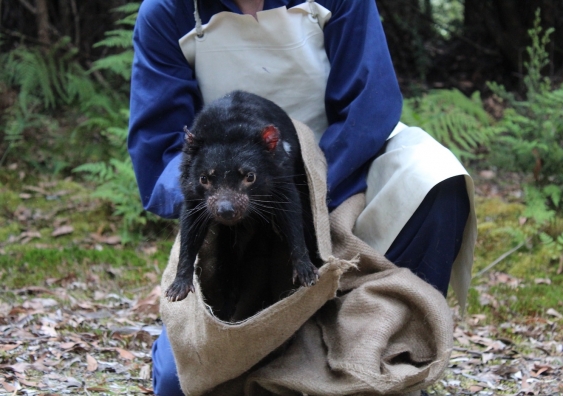
Bird Flu Associated With Hundreds Of Seal Deaths In New England In 2022
Jellyfish Size Might Influence Their Nutritional Value
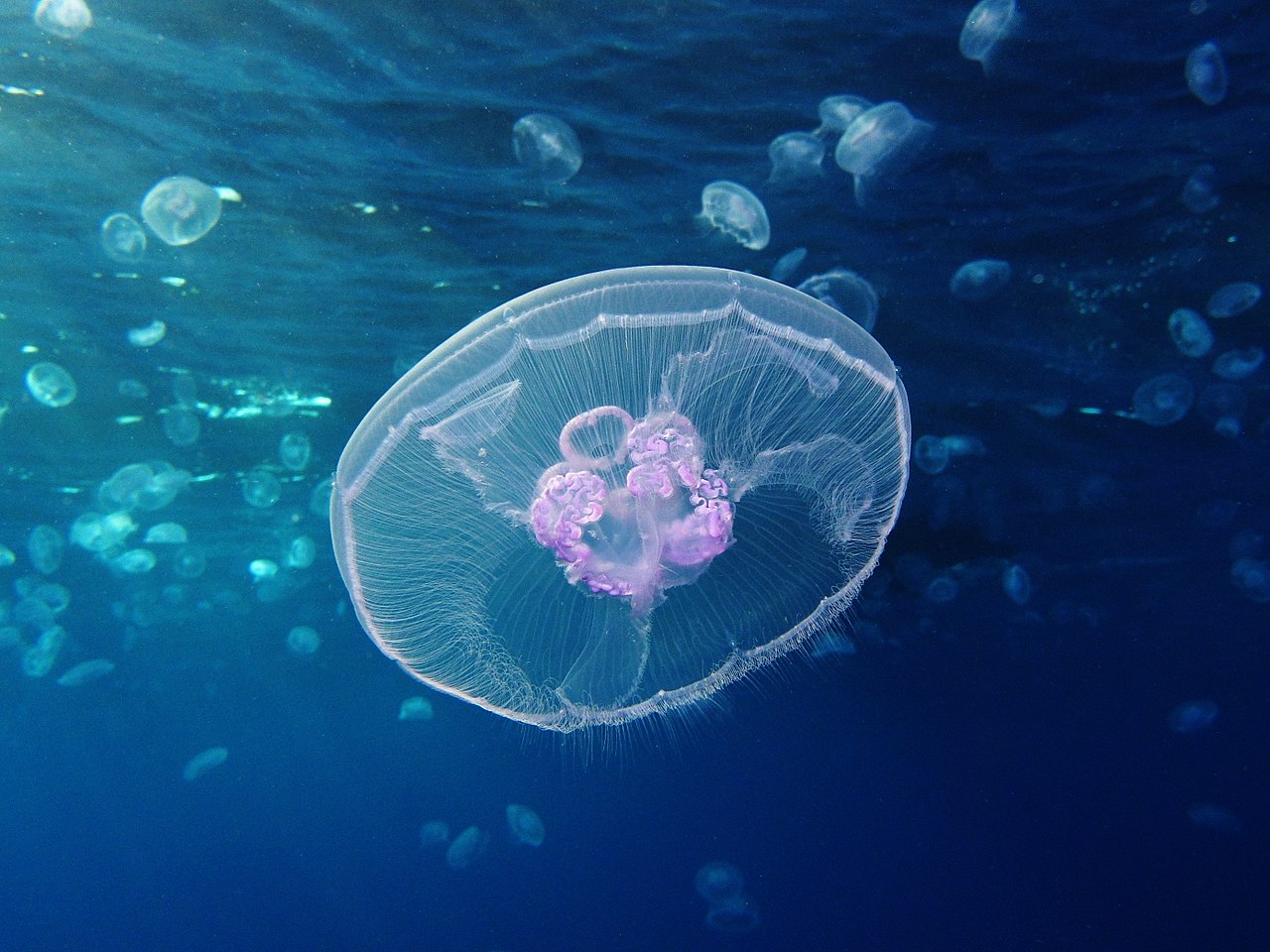
Recycling: Researchers Separate Cotton From Polyester In Blended Fabric
Mind-Control Robots A Reality
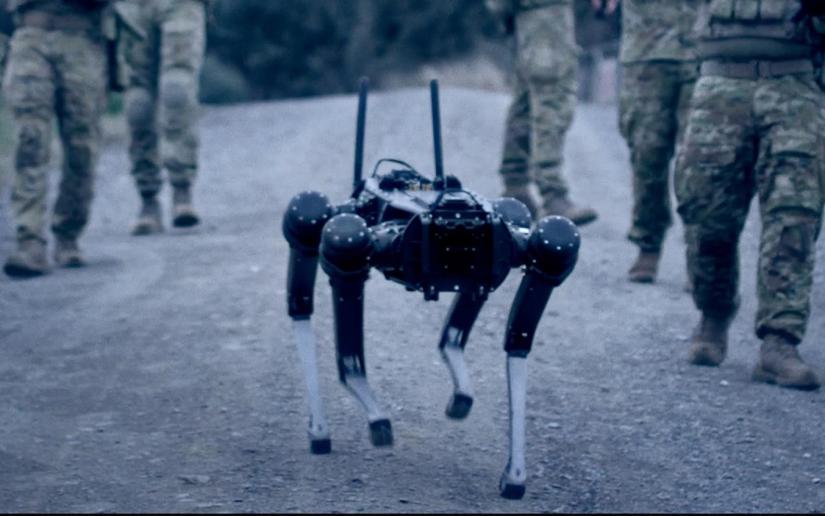
Origin And Evolution Of The Grapevine
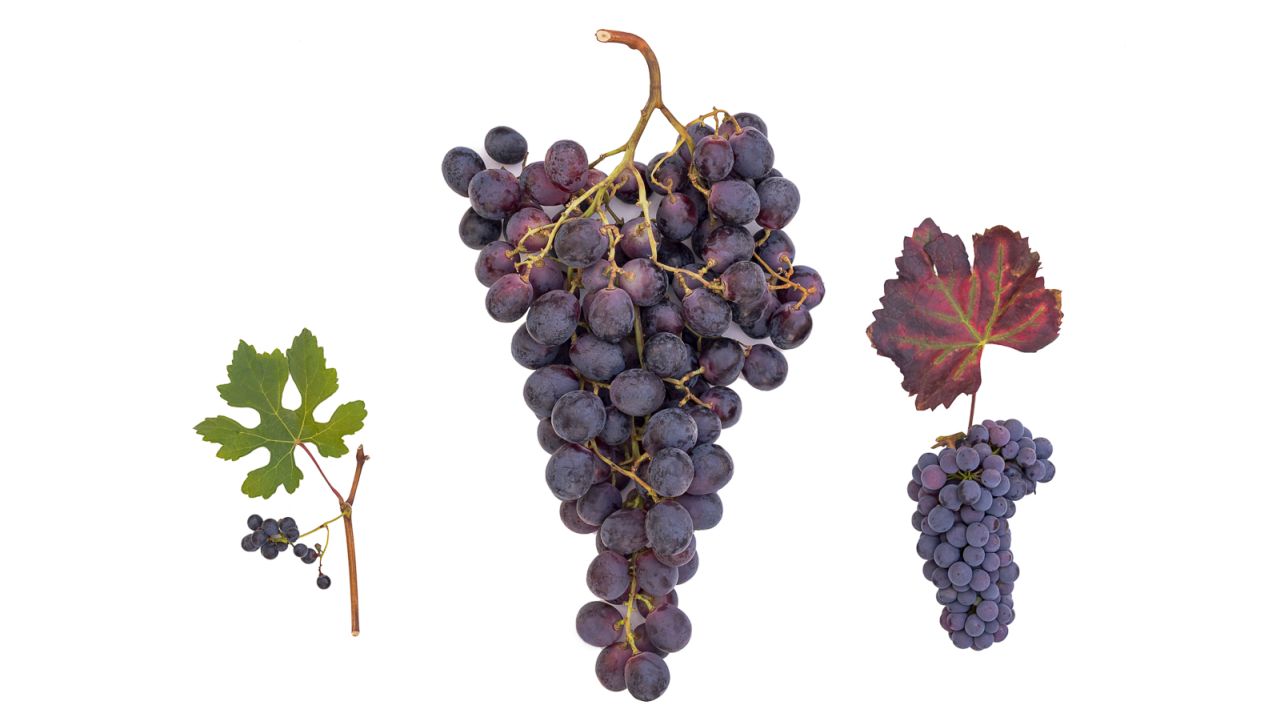
Disclaimer: These articles are not intended to provide medical advice, diagnosis or treatment. Views expressed here do not necessarily reflect those of Pittwater Online News or its staff.